1959 Cadillac outside Hotel Nacional
VEDADO AND PLAZA DE LA REVOLUCIÓN
PERFUMES, TOILETRIES, AND JEWELRY
DEPARTMENT STORES AND SHOPPING CENTERS
VEDADO AND PLAZA DE LA REVOLUCIÓN
VEDADO AND PLAZA DE LA REVOLUCIÓN
CIUDAD PANAMERICANO AND COJÍMAR
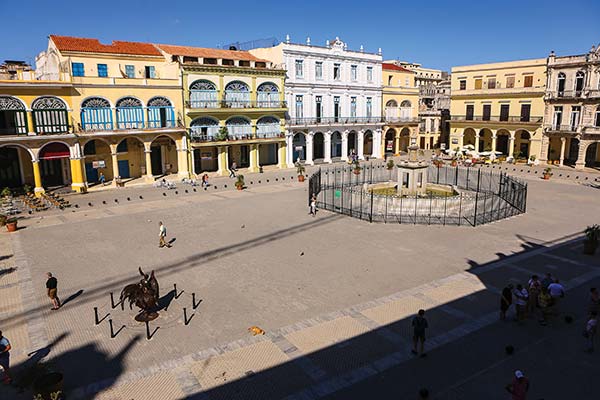
Plaza Vieja, Habana Vieja.
Havana is the political, cultural, and industrial heart of the nation.
It lies 150 kilometers (93 miles) due south of Florida on Cuba’s northwest coast. It is built on the west side of the sweeping Bahía de la Habana and extends west 12 kilometers to the Río Jaimanitas and south for an equal distance.
Countless writers have commented on the exhilarating sensation that engulfs visitors to this most beautiful and beguiling of Caribbean cities. Set foot one time in Havana and you can only succumb to its enigmatic allure. It is impossible to resist the city’s mysteries and contradictions.
Havana (pop. 2.2 million) has a flavor all its own, a merging of colonialism, capitalism, and Communism into one. One of the great historical cities of the New World, Havana is a far cry from the Caribbean backwaters that call themselves capitals elsewhere in the Antilles. Havana is a city, notes architect Jorge Rigau, “upholstered in columns, cushioned by colonnaded arcades.” The buildings come in a spectacular amalgam of styles—from the academic classicism of aristocratic homes, rococo residential exteriors, Moorish interiors, and art deco and art nouveau to stunning exemplars of 1950s moderne.
At the heart of the city is enchanting Habana Vieja (Old Havana), a living museum inhabited by 60,000 people and containing perhaps the finest collection of Spanish-colonial buildings in all the Americas. Baroque churches, convents, and castles that could have been transposed from Madrid or Cádiz still reign majestically over squares embraced by the former palaces of Cuba’s ruling gentry and cobbled streets still haunted by Ernest Hemingway’s ghost. Hemingway’s house, Finca Vigía, is one of dozens of museums dedicated to the memory of great men and women. And although older monuments of politically incorrect heroes were pulled down, they were replaced by dozens of monuments to those on the correct side of history.
The heart of Habana Vieja has been restored, and most of the important structures have been given facelifts, or better, by the City Historian’s office. Some have even metamorphosed into boutique hotels. Nor is there a shortage of 1950s-era modernist hotels steeped in Mafia associations. And hundreds of casas particulares provide an opportunity to live life alongside the habaneros themselves. As for food, Havana is in the midst of a gastro-revolution. A dynamic new breed of paladar (private restaurant) owner is now offering world-class cuisine in spectacular settings. Streets from Habana Vieja to Vedado resound with the sound of jackhammers. Pockets of gentrification—an inconceivable word for Cuba until now—are emerging as the rapprochement with the United States and the tourism boom it has fostered are translating into money, money, money and a surge of private investment in boutique bars, boutiques, and chic casas particulares billed as boutique “hotels.”
Nonetheless, it’s increasingly hard to find a vacant hotel room: Havana is jam-packed with yanqui visitors making the most of the heretofore forbidden fruit. A series finale of House of Lies, plus segments of Fast & Furious 8, have been filmed in Havana as Hollywood, too, has cottoned on. In 2017, U.S. cruise ships arrived, flooding the plazas with tour groups. The arts scene remains unrivaled in Latin America, with first-rate museums and galleries—not only formal galleries, but informal ones where contemporary artists produce unique works of amazing profundity and appeal. There are tremendous crafts markets and boutique stores. Afro-Caribbean music is everywhere, quite literally on the streets. Lovers of sizzling salsa have dozens of venues from which to choose. Havana even has a hot jazz scene. Classical music and ballet are world class. And neither Las Vegas nor Rio de Janeiro can compare with Havana for sexy cabarets, with top billing now, as back in the day, belonging to the Tropicana.
Havana is so large, and the sights to be seen so many, that one week is the bare minimum needed. Metropolitan Havana sprawls over 740 square kilometers (286 square miles) and incorporates 15 municipios (municipalities). Havana is a collection of neighborhoods, each with its own distinct character. Because the city is so spread out, it is best to explore Havana in sections, concentrating your time on the three main districts of touristic interest—Habana Vieja, Vedado, and Miramar—in that order.
If you have only one or two days in Havana, book a get-your-bearings trip by HabanaBusTour or hop on an organized city tour offered by Havanatur or a similar agency. This will provide an overview of the major sights. Concentrate the balance of your time around Parque Central, Plaza de la Catedral, and Plaza de Armas. Your checklist of must-sees should include the Capitolio Nacional, Museo de la Revolución, Museo Nacional de Bellas Artes, Catedral de la Habana, Museo de la Ciudad de la Habana, and Parque Histórico Militar Morro-Cabaña, featuring two restored castles attended by soldiers in period costume.
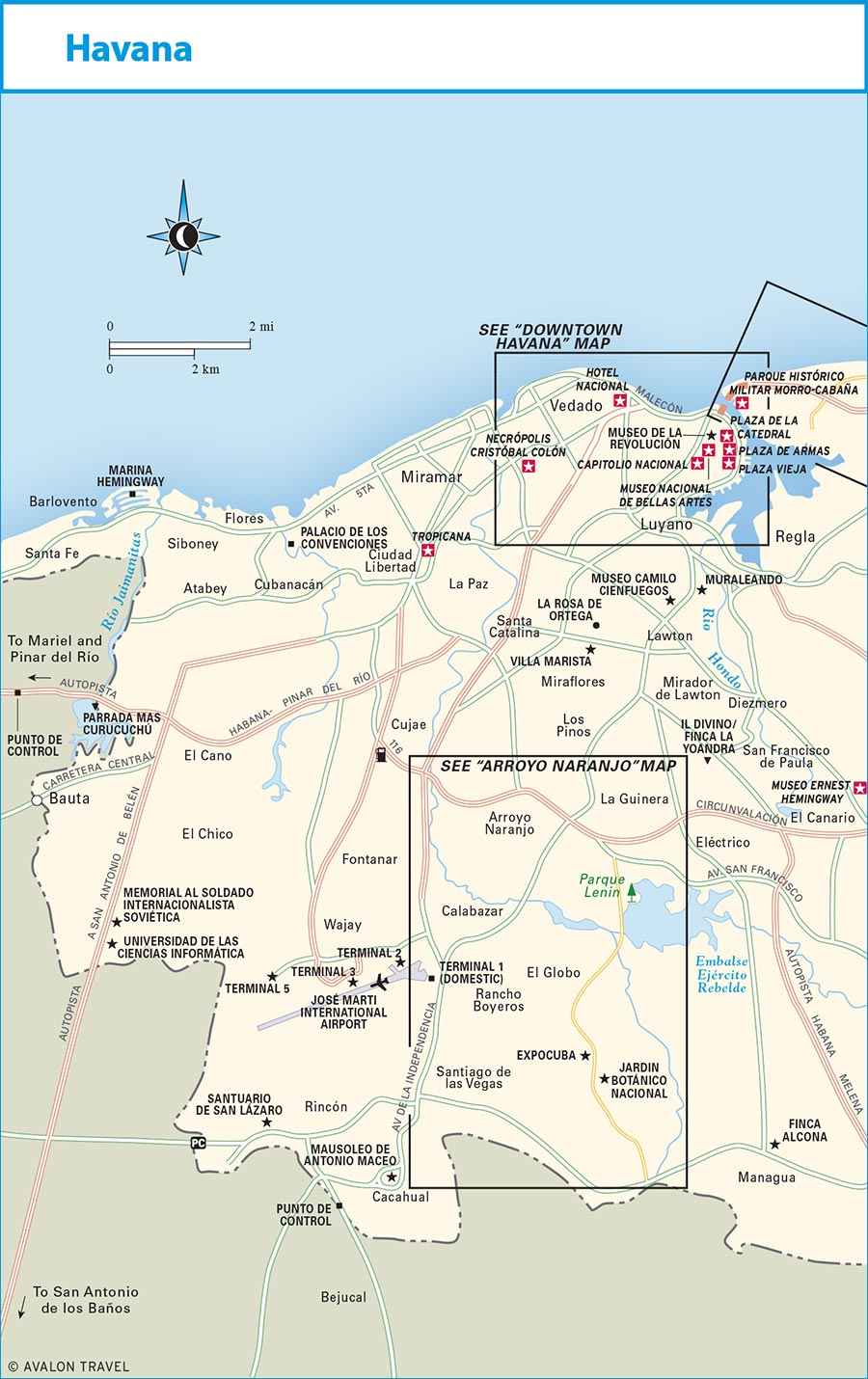
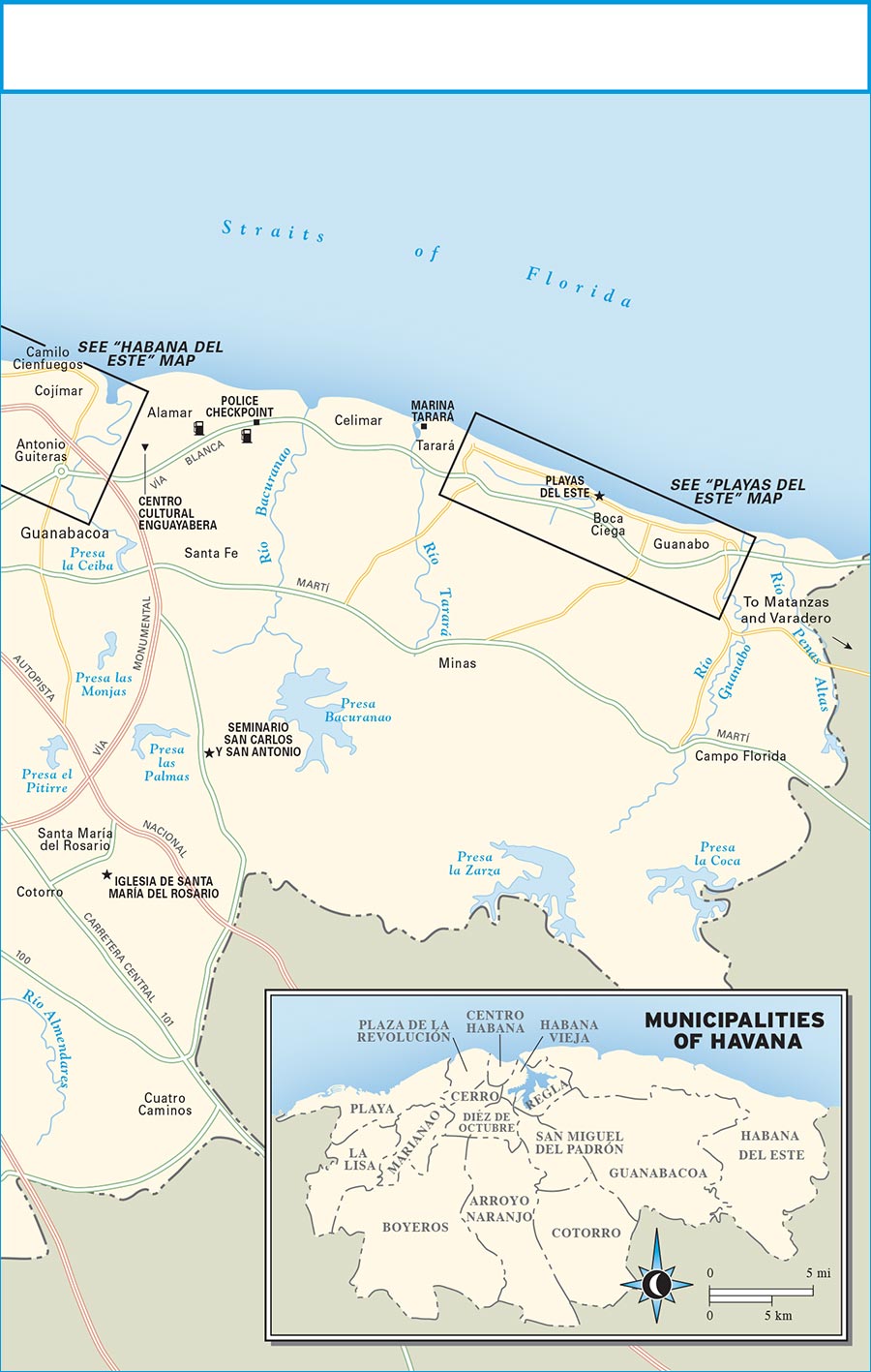
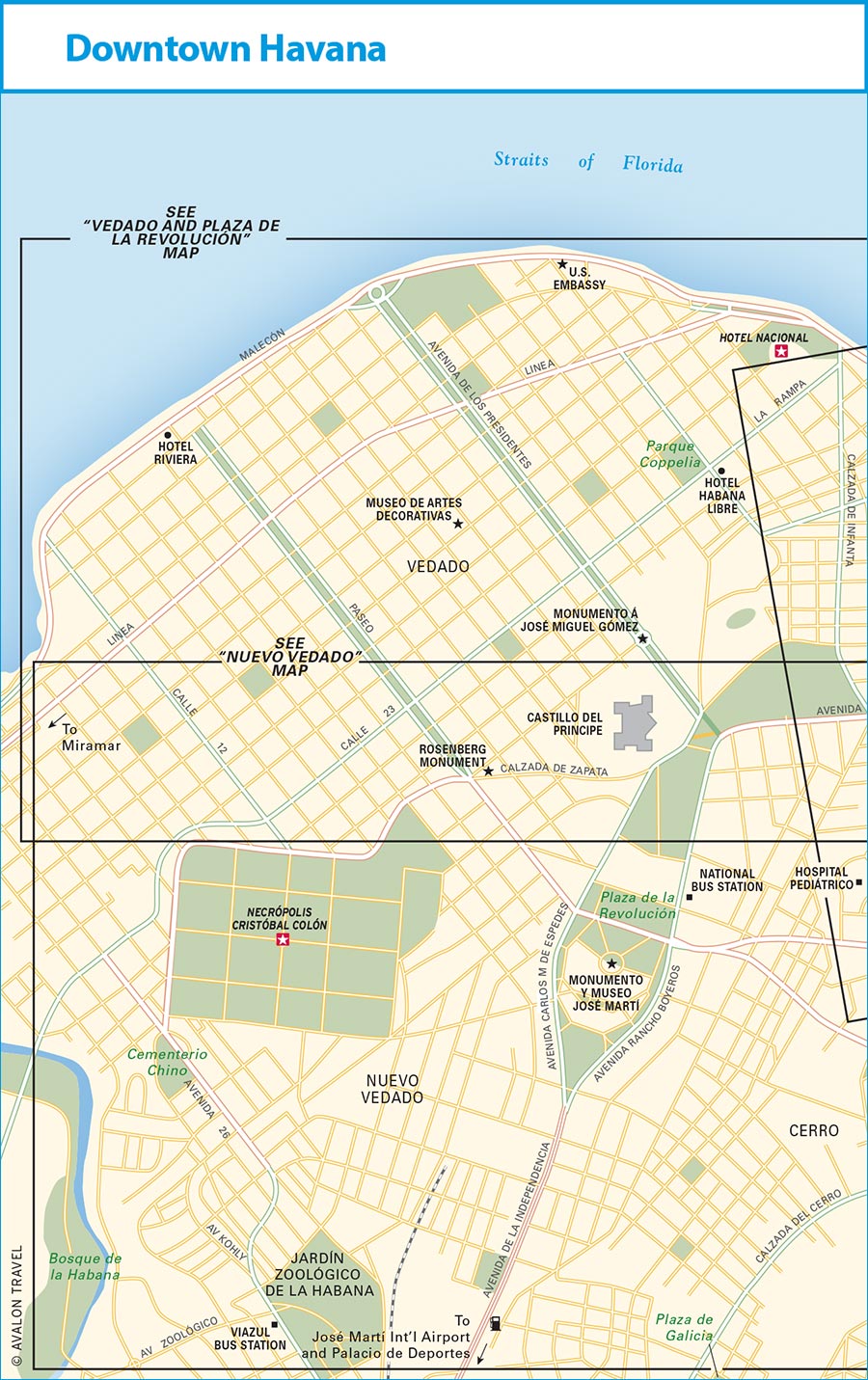
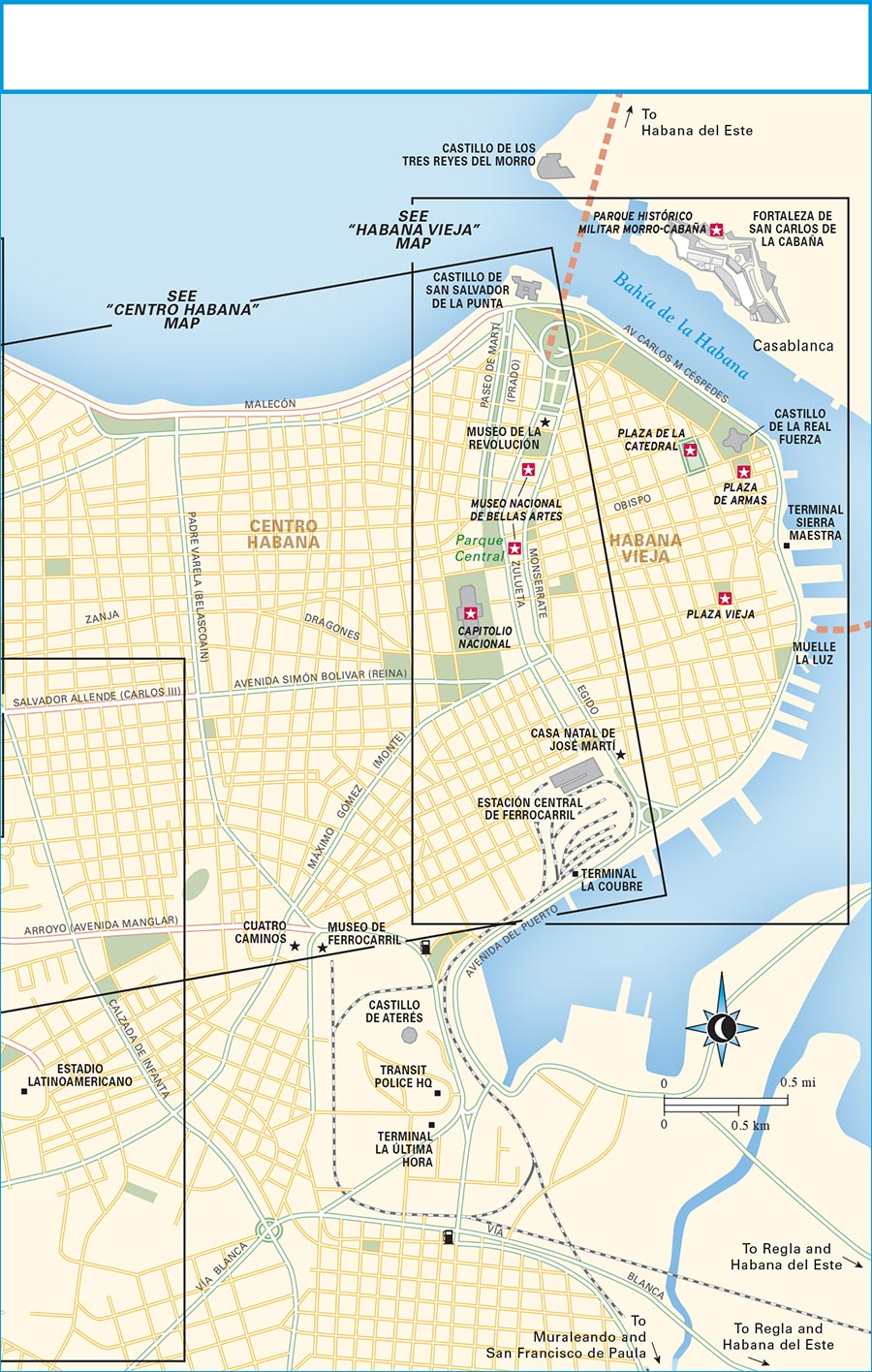
Habana Vieja, the original colonial city within the 17th-century city walls (now demolished), will require at least three days to fully explore. You can base yourself in one of the charming historic hotel conversions close to the main sights of interest.
Centro Habana has many casas particulares and fine restaurants but few sites of interest, and its rubble-strewn, dimly lit streets aren’t the safest. Skip Centro for Vedado, the modern heart of the city that evolved in the early 20th century, with many ornate mansions in beaux-arts and art nouveau style. Its leafy streets make for great walking. Many of the city’s best casas particulares are here, as are most businesses, paladares, and nightclubs. The Hotel Nacional, Universidad de la Habana, Cementerio Colón, and Plaza de la Revolución are sights not to miss.
If you’re interested in beaux-arts or art deco architecture, then the once-glamorous Miramar, Cubanacán, and Siboney regions, west of Vedado, are worth exploring. Miramar also has excellent restaurants, deluxe hotels, and some of my favorite nightspots.
Most other sections of Havana are run-down residential districts of little interest to tourists. A few exceptions lie on the east side of Havana harbor. Regla and neighboring Guanabacoa are together a center of Santería and Afro-Cuban music. The 18th-century fishing village of Cojímar has Hemingway associations, and the nearby community of San Miguel del Padrón is where the great author lived for 20 years. A visit to his home, Finca Vigía, today the Museo Ernest Hemingway, is de rigueur. Combine it with a visit to the exquisite colonial Iglesia de Santa María del Rosario. About 15 kilometers east of the city, long, white-sand beaches—the Playas del Este—prove tempting on hot summer days.
In the suburban district of Boyeros, to the south, the Santuario de San Lázaro is an important pilgrimage site. A visit here can be combined with the nearby Mausoleo Antonio Maceo, where the hero general of the independence wars is buried outside the village of Santiago de las Vegas. A short distance east, the Arroyo Naranjo district has Parque Lenin, a vast park with an amusement park, horseback rides, boating, and more. Enthusiasts of botany can visit the Jardín Botánico Nacional.
Despite Havana’s great size, most sights of interest are highly concentrated, and most exploring is best done on foot.
The city was founded in July 1515 as San Cristóbal de la Habana, and was located on the south coast, where Batabanó stands today. The site was a disaster. On November 25, 1519, the settlers moved to the shore of the flask-shaped Bahía de la Habana. Its location was so advantageous that in July 1553 the city replaced Santiago de Cuba as the capital of the island.
Every spring and summer, Spanish treasure ships returning from the Americas crowded into Havana’s sheltered harbor before setting off for Spain in an armed convoy—la flota. By the turn of the 18th century, Havana was the third-largest city in the New World after Mexico City and Lima. The 17th and 18th centuries saw a surge of ecclesiastical construction and a perimeter wall was built.
In 1762, the English captured Havana but ceded it back to Spain the following year in exchange for Florida. The Spanish lost no time in building the largest fortress in the Americas—San Carlos de la Cabaña. Under the supervision of the new Spanish governor, the Marqués de la Torre, the city attained a new focus and rigorous architectural harmony. The first public gas lighting arrived in 1768. Most of the streets were cobbled. Along them, wealthy merchants and plantation owners erected beautiful mansions fitted inside with every luxury in European style.
By the mid-19th century, Havana was bursting its seams. In 1863, the city walls came tumbling down. New districts went up westward, and graceful boulevards pushed into the surrounding countryside, lined with a parade of quintas (summer homes) fronted by classical columns. By the mid-1800s, Havana had achieved a level of modernity that surpassed that of Madrid.
Following the Spanish-Cuban-American War, Havana entered a new era of prosperity. The city spread out, its perimeter enlarged by parks, boulevards, and dwellings in eclectic, neoclassical, and revivalist styles, while older residential areas settled into an era of decay.
By the 1950s Havana was a wealthy and thoroughly modern city with a large and prospering middle class, and had acquired skyscrapers such as the Focsa building and the Hilton (now the Habana Libre). Ministries were being moved to a new center of construction (today the Plaza de la Revolución), inland from Vedado. Gambling found new life, and casinos flourished.
Following the Revolution in 1959, a mass exodus of the wealthy and the middle class began, inexorably changing the face of Havana. Tourists also forsook the city, dooming Havana’s hotels, restaurants, and other businesses to bankruptcy. Festering slums and shantytowns marred the suburbs. The government ordered them razed. Concrete apartment blocks were erected on the outskirts. That accomplished, the Revolution turned its back on the city. Havana’s aged housing and infrastructure, much of it already decayed, have ever since suffered neglect.
Tens of thousands of poor peasant migrants poured into Havana from Oriente. The settlers changed the city’s demographic profile: Most of the immigrants were black; today, as many as 400,000 “palestinos,” immigrants from Santiago and the eastern provinces, live in Havana.
Finally, in the 1980s, the revolutionary government established a preservation program for Habana Vieja, and the Centro Nacional de Conservación, Restauración, y Museología was created to inventory Havana’s historic sites and implement a restoration program that would return the ancient city to pristine splendor. Much of the original city core now gleams afresh with confections in stone, while the rest is left to crumble.
Habana Vieja (4.5 square km) is defined by the limits of the early colonial settlement that lay within fortified walls. The legal boundary of Habana Vieja includes the Paseo de Martí (Prado) and everything east of it.
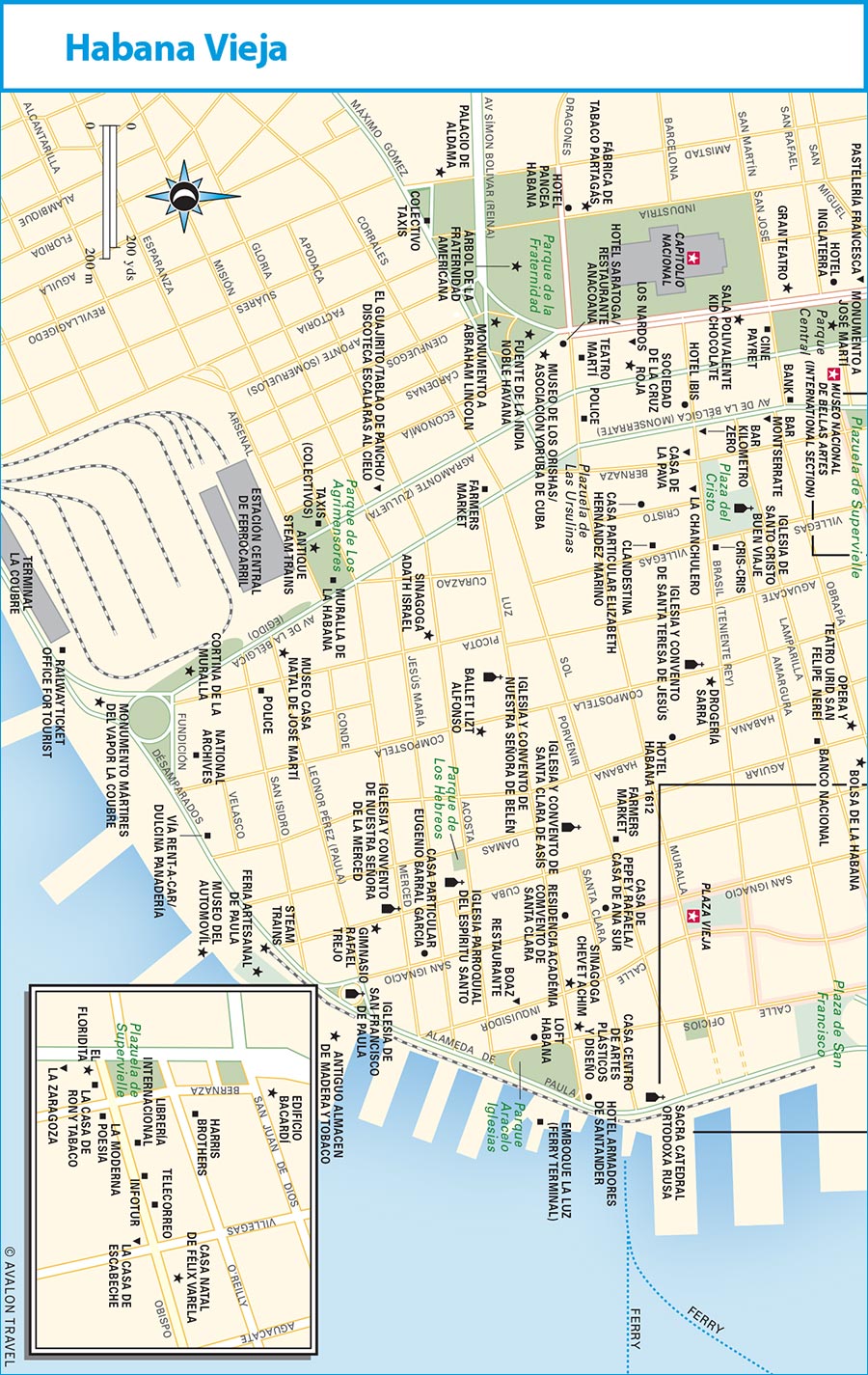

Habana Vieja is roughly shaped like a diamond, with the Castillo de la Punta its northerly point. The Prado runs south at a gradual gradient from the Castillo de la Punta to Parque Central and, beyond, Parque de la Fraternidad. Two blocks east, Avenida de Bélgica parallels the Prado, tracing the old city wall to the harborfront at the west end of Desamparados. East of Castillo de la Punta, Avenida Carlos Manuel de Céspedes (Avenida del Puerto) runs along the harbor channel and curls south to Desamparados.
The major sites of interest are centered on Plaza de Armas, Plaza de la Catedral, Plaza Vieja, and Parque Central. Each square has its own flavor. The plazas and surrounding streets shine after a complete restoration that now extends to the area east of Avenida de Bélgica and southwest of Plaza Vieja, between Calles Brasil and Merced. This was the great ecclesiastical center of colonial Havana and is replete with churches and convents.
Habana Vieja is a living museum—as many as 60,000 people live within the confines of the old city wall—and suffers from inevitable ruination brought on by the tropical climate, hastened since the Revolution by years of neglect. The grime of centuries has been soldered by tropical heat into the chipped cement and faded pastels. Beyond the restored areas, Habana Vieja is a quarter of sagging, mildewed walls and half-collapsed balconies. The much-deteriorated (mostly residential) southern half of Habana Vieja requires caution.
The past few years have witnessed a spectacular tourist boom. Gentrification is sweeping pockets of Habana Vieja. Suddenly every third building in this overcrowded, once sclerotic northern extreme of Habana Vieja is in the throes of a remake as a boutique B&B, hip restaurant, or—what’s this?—a gourmet heladería selling homemade gelato. You’ll want to avoid Habana Vieja when the cruise ships are in.
Paseo de Martí, colloquially known as the Prado, is a kilometer-long tree-lined boulevard that slopes southward, uphill, from the harbor mouth to Parque Central. The beautiful boulevard was initiated by the Marqués de la Torre in 1772 and completed in 1852, when it had the name Alameda de Isabella II. It lay extramura (outside the old walled city) and was Havana’s most notable thoroughfare. Mansions of aristocratic families rose on each side and it was a sign of distinction to live here. The paseo—the daily carriage ride—along the boulevard was an important social ritual, with bands at regular intervals to play to the parade of volantas (carriages).
French landscape artist Jean-Claude Nicolas Forestier remodeled the Prado to its present form in 1929. It’s guarded by eight bronze lions, with an elevated central walkway bordered by an ornate wall with alcoves containing marble benches carved with scroll motifs. At night, it is lit by brass gas lamps with globes atop wrought-iron lampposts in the shape of griffins. Schoolchildren sit beneath shade trees, listening to lessons presented alfresco. An art fair is held on Sundays.
Heading downhill from Neptuno, the first building of interest, on the east side at the corner of Virtudes, is the former American Club—U.S. expat headquarters before the Revolution. The Palacio de Matrimonio (Prado #306, esq. Ánimas, tel. 07/866-0661, Tues.-Fri. 8am-6pm), on the west side at the corner of Ánimas, is where many of Havana’s wedding ceremonies are performed. The palace, built in 1914, boasts a magnificent neobaroque facade and spectacularly ornate interior.
The Moorish-inspired Hotel Sevilla (Trocadero #55) is like entering a Moroccan medina. It was inspired by the Patio of the Lions at the Alhambra in Granada, Spain. The hotel opened in 1908. The gallery walls are festooned with black-and-white photos of famous figures who have stayed here, from singer Josephine Baker and boxer Joe Louis to Al Capone, who took the entire sixth floor (Capone occupied room 615).
At Trocadero, budding dancers train for potential ballet careers in the Escuela Nacional de Ballet (National School of Ballet, Prado #207, e/ Colón y Trocadero, tel. 07/861-6629, cuballet@cubarte.cult.cu; entry by permission only). On the west side, the Casa de los Científicos (Prado #212, esq. Trocadero, tel. 07/862-1607), the former home of President José Miguel Gómez, first president of the republic, is now a hotel; pop in to admire the fabulous stained glass and the chapel.
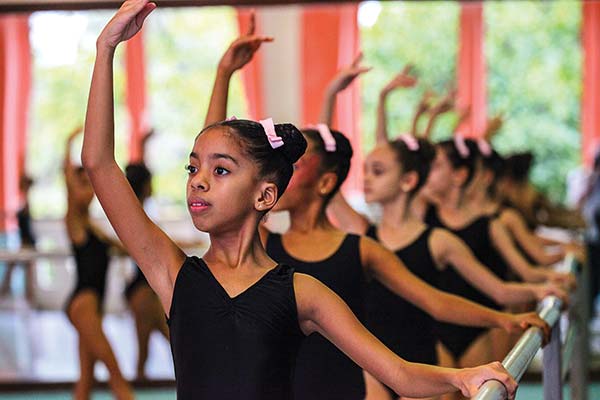
dancers at the Escuela Nacional de Ballet
At Prado and Colón, note the art deco Cine Fausto, an ornamental band on its upper facade; two blocks north, examine the mosaic mural of a Nubian beauty on the upper wall of the Centro Cultural de Árabe (between Refugio and Trocadero).
The bronze statue of Juan Clemente-Zenea (1832-1871), at the base of the Prado, honors a nationalist poet shot for treason in 1871.
The small, recently restored Castillo de San Salvador de la Punta (Av. Carlos M. de Céspedes, esq. Prado y Malecón, tel. 07/860-3195, Wed.-Sun. 10am-6pm, CUC1) guards the entrance to Havana’s harbor channel at the base of the Prado. It was built in 1589 directly across from the Morro castle so that the two fortresses could catch invaders in a crossfire. A great chain was slung between them each night to secure Havana harbor.
Gazing over the plaza on the west side of the castle is a life-size statue of Venezuelan general Francisco de Miranda Rodríguez (1750-1816), while 100 meters east of the castle is a statue of Pierre D’Iberville (1661-1706), a Canadian explorer who died in Havana.
The park immediately south of the Castillo de San Salvador, on the south side of Avenida Carlos Manuel de Céspedes, at the base (and east) of the Prado, is divided in two by Avenida de los Estudiantes. Parque de los Enamorados (Park of the Lovers), on the north side of Avenida de los Estudiantes, features a statue of an Indian couple, plus the Monumento de Estudiantes de Medicina, a small Grecian-style temple shading the remains of a wall used by Spanish firing squads. On November 27, 1871, eight medical students met their deaths after being falsely accused of desecrating the tomb of a prominent loyalist. A trial found them innocent, but enraged loyalist troops held their own trial and shot the students, who are commemorated each November 27.
Parque de Mártires (Martyrs’ Park), on the south side of Avenida de los Estudiantes, occupies the ground of the former Tacón prison, built in 1838. Nationalist hero José Martí was imprisoned here 1869-1870. The Carcel de la Habana prison was demolished in 1939. Preserved are two of the punishment cells and the chapel used by condemned prisoners before being marched to the firing wall.
Spacious Parque Central is the social epicenter of Habana Vieja. The park—bounded by the Prado, Neptuno, Zulueta, and San Martín—is presided over by stately royal palms shading a marble statue of José Martí. It was sculpted by José Vilalta de Saavedra and inaugurated in 1905. Adjacent, baseball fanatics gather at a point called “esquina caliente” (“hot corner”) to argue the intricacies of pelota (baseball).
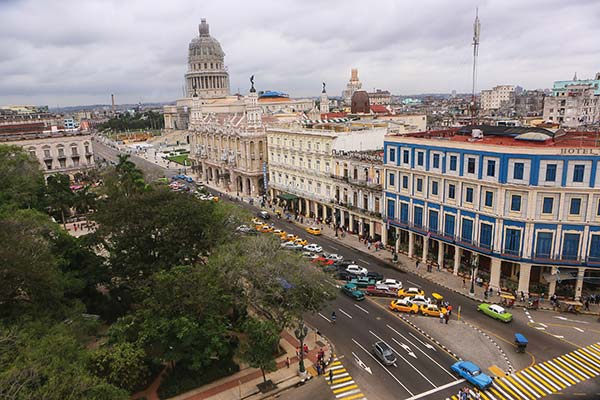
Parque Central, Habana Vieja
The park is surrounded by historic hotels, including the triangular Hotel Plaza (Zulueta #267), built in 1909, on the northeast face of the square. In 1920, baseball legend Babe Ruth stayed in room 216, preserved as a museum with his signed bat and ball in a case. Much of the social action happens in front of the Hotel Inglaterra (Paseo de Martí #416), opened in 1856 and today the oldest Cuban hotel still extant. The sidewalk, known in colonial days as the Acera del Louvre, was a focal point for rebellion against Spanish rule. A plaque outside the hotel entrance honors the “lads of the Louvre sidewalk” who died for Cuban independence. Inside, the hotel boasts elaborate wrought-ironwork and exquisite Mudejar-style detailing, including arabesque archways and azulejos (patterned tile). A highlight is the sensuous life-size bronze statue of a Spanish dancer—La Sevillana—in the main bar. Hopefully the fin de siècle charm will survive the 2016 remake initiated by U.S. hotel company Starwood.
Immediately south of the Inglaterra, the Gran Teatro (Paseo de Martí #452, e/ San Rafael y Neptuno, tel. 07/862-9473, guided tours Tue.-Sat. 9am-5pm, CUC2) originated in 1837 as the Teatro Tacón, drawing operatic luminaries such as Enrico Caruso and Sarah Bernhardt. The current neobaroque structure dates from 1915, when a social club—the Centro Gallego—was built around the old Teatro Tacón for the Galician community.
The building’s exorbitantly baroque facade drips with caryatids and has four towers, each tipped by a white marble angel reaching gracefully for heaven. It functions as a theater for the Ballet Nacional and Ópera Nacional de Cuba. The main auditorium, the exquisitely decorated 2,000-seat Teatro García Lorca, features a painted dome and huge chandelier. Smaller performances are hosted in the 500-seat Sala Alejo Carpentier and the 120-seat Sala Artaud. After a two-year restoration, it reopened in 2016 (in time for President Obama’s speech here) and is spectacularly illuminated at night.
The international section of the Museo Nacional de Bellas Artes (National Fine Arts Museum, San Rafael, e/ Zulueta y Monserrate, tel. 07/863-9484 or 07/862-0140, www.bellasartes.cult.cu, Tues.-Sat. 9am-5pm, Sun. 10am-2pm, entrance CUC5, or CUC8 for both sections, guided tour CUC2) occupies the former Centro Asturiano, on the southeast side of the square. The building, lavishly decorated with neoclassical motifs, was erected in 1885 but rebuilt in Renaissance style in 1927 following a fire and housed the postrevolutionary People’s Supreme Court. A stained glass window above the main staircase shows Columbus’s three caravels.
The art collection is displayed on five floors covering 4,800 square meters. The works span the United States, Latin America, Asia, and Europe—including masters such as Gainsborough, Goya, Murillo, Rubens, Velásquez, and various Impressionists. The museum also boasts Latin America’s richest trove of Roman, Greek, and Egyptian antiquities. It has a top-floor restaurant.
The statuesque Capitolio Nacional (Capitol, Paseo de Martí, e/ San Martín y Dragones), one block south of Parque Central, dominates Havana’s skyline. It was built between 1926 and 1929 as Cuba’s Chamber of Representatives and Senate and designed after the U.S. Capitol. The 692-foot-long edifice is supported by colonnades of Doric columns, with semicircular pavilions at each end of the building. The lofty stone cupola rises 62 meters, topped by a replica of 16th-century Florentine sculptor Giambologna’s famous bronze Mercury.
A massive stairway—flanked by neoclassical figures in bronze by Italian sculptor Angelo Zanelli that represent Labor and Virtue—leads to an entrance portico with three tall bronze doors sculpted with 30 bas-reliefs that depict important events of Cuban history. Inside, facing the door is the Estatua de la República (Statue of the Republic), a massive bronze sculpture (also by Zanelli) of Cuba’s Indian maiden of liberty. At 17.5 meters (57 feet) tall, she is the world’s third-largest indoor statue (the other two are the gold Buddha in Nava, Japan, and the Lincoln Memorial in Washington, DC). In the center of the floor a replica of a 24-carat diamond marks Kilometer 0, the point from which all distances on the island are calculated.
The 394-foot-long Salón de los Pasos Perdidos (Great Hall of the Lost Steps), so named because of its acoustics, is inlaid with patterned marble motifs and features bronze bas-reliefs, green marble pilasters, and massive lamps on carved pedestals of glittering copper. Renaissance-style candelabras dangle from the frescoed ceiling. The semicircular Senate chamber and Chamber of Representatives are at each end.
At press time the building remained closed for a three-year restoration and will supposedly reopen as the home of the Asemblea Nacional.
Paseo de Martí (Prado) runs south from Parque Central three blocks, where it ends at the junction with Avenida Máximo Gómez (Monte). Here rises the Fuente de la India Noble Habana in the middle of the Prado. Erected in 1837, the fountain is surmounted by a Carrara marble statue of the legendary Indian queen. In one hand she bears a cornucopia, in the other a shield with the arms of Havana. Four fish at her feet occasionally spout water.
The Asociación Cultural Yoruba de Cuba (Prado #615, e/ Dragones y Monte, tel. 07/863-5953, www.yorubacuba.org, daily 9am-5pm) has a rather prosaic upstairs Museo de los Orishas (CUC10, students CUC3) dedicated to the orishas of Santería; no photos are permitted. The constitution for the republic was signed in 1901 in the restored Teatro Martí (Dragones, esq. Zulueta), one block west of the Prado.
The Parque de la Fraternidad (Friendship Park) was laid out in 1892 on an old military drill square, the Campo de Marte, to commemorate the fourth centennial of Columbus’s discovery of America. The current layout by Jean-Claude Nicolas Forestier dates from 1928. The Árbol de la Fraternidad Americana (Friendship Tree) was planted at its center on February 24, 1928, to cement goodwill between the nations of the Americas. Busts and statues of outstanding American leaders such as Simón Bolívar and Abraham Lincoln watch over.
The Palacio de Aldama (Amistad #510, e/ Reina y Estrella), on the park’s far southwest corner, is a grandiose mansion built in neoclassical style in 1844 for a wealthy Basque, Don Domingo Aldama y Arrechaga. Its facade is lined by Ionic columns and the interior features murals of scenes from Pompeii. It is not open to the public.
To the park’s northeast side, a former graveyard for rusting antique steam trains has been cleared to make way for a new hotel, Pancea Havana Cuba.
The original Partagás Cigar Factory (Industria #520, e/ Dragones y Barcelona), on the west side of the Capitolio, features a four-story classical Spanish-style facade capped by a roofline of baroque curves topped by lions. It closed in 2010 for repair and remained so at press time, with little sign of progress. The cigar-making facility moved to the former El Rey del Mundo factory (Luceña #816, esq. Penalver, Centro Habana) and is open for tours. The factory specialized in full-bodied Partagás cigars, started in 1843 by Catalan immigrant Don Jaime Partagás Ravelo. Partagás was murdered in 1868—some say by a rival who discovered that Partagás was having an affair with his wife—and his ghost is said to haunt the building. A tobacco shop and cigar lounge remain open on the ground floor (tel. 07/863-5766).
Calle Agramonte, more commonly referred to by its colonial name of Zulueta, parallels the Prado and slopes gently upward from Avenida de los Estudiantes to the northeast side of Parque Central. Traffic runs one-way uphill.
At its north end is the Monumento al General Máximo Gómez. This massive monument of white marble by sculptor Aldo Gamba was erected in 1935 to honor the Dominican-born hero of the Cuban wars of independence who led the Liberation Army as commander-in-chief. Gómez (1836-1905) is cast in bronze, reining in his horse.
One block north of Parque Central, at the corner of Zulueta and Ánimas, is Sloppy Joe's, commemorated as Freddy’s Bar in Hemingway’s To Have and Have Not. Restored in 2013, it reopened its doors after decades lying shuttered and near-derelict.
The old Cuartel de Bomberos fire station houses the tiny Museo de Bomberos (Museum of Firemen, Zulueta #257, e/ Neptuno y Ánimas, tel. 07/863-4826, Tues.-Fri. 9:30am-5pm, free), displaying a Merryweather engine from 1894 and antique firefighting memorabilia.
Immediately beyond the Museo Nacional de Bellas Artes and Museo de la Revolución is Plaza 13 de Marzo, a grassy park named to commemorate the ill-fated attack of the presidential palace by student martyrs on March 13, 1957. At the base of Zulueta, at the junction with Cárcel, note the flamboyant art nouveau building housing the Spanish Embassy.
The ornate building facing north over Plaza 13 de Marzo was initiated in 1913 to house the provincial government. Before it could be finished (in 1920), it was earmarked as the Palacio Presidencial (Presidential Palace), and Tiffany’s of New York was entrusted with its interior decoration. It was designed by Belgian Paul Belau and Cuban Carlos Maruri in an eclectic style, with a lofty dome. Following the Revolution, the three-story palace was converted into the dour Museo de la Revolución (Museum of the Revolution, Refugio #1, e/ Zulueta y Monserrate, tel. 07/862-4091, daily 9am-5pm, CUC8, cameras CUC2, guide CUC2). It is fronted by a SAU-100 Stalin tank used during the Bay of Pigs invasion in 1961 and a semi-derelict watchtower, Baluarte de Ángel, erected in 1680.
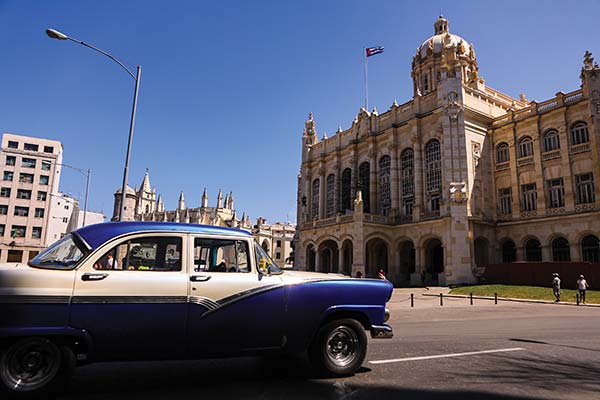
Museo de la Revolución
The marble staircase leads to the Salón de los Espejos (the Mirror Room), a replica of that in Versailles (replete with paintings by Armando Menocal); and Salón Dorado (the Gold Room), decorated with gold leaf and highlighted by its magnificent dome.
Rooms are divided chronologically. Maps describe the progress of the revolutionary war. Guns and rifles are displayed alongside grisly photos of dead and tortured heroes. The Rincón de los Cretinos (Corner of Cretins) pokes fun at Batista, Ronald Reagan, and George Bush. There’s a café to the rear.
At the rear, in the former palace gardens, is the Granma Memorial, preserving the vessel that brought Castro and his revolutionaries from Mexico to Cuba in 1956. The Granma is encased in a massive glass structure. It’s surrounded by vehicles used in the revolutionary war: armored vehicles, the bullet-riddled “Fast Delivery” truck used in the student commandos’ assault on the palace on March 13, 1957 (Batista escaped through a secret door), and Castro’s Toyota jeep from the Sierra Maestra. There’s also a turbine from the U-2 spy plane downed during the missile crisis in 1962, plus a Sea Fury aircraft and a T-34 tank.
The Cuban section of the Museo Nacional de Bellas Artes (National Fine Arts Museum, Trocadero, e/ Zulueta y Monserrate, tel. 07/863-9484 or 07/862-0140, www.bellasartes.cult.cu, Tues.-Sat. 9am-5pm, Sun. 10am-2pm, entrance CUC5, or CUC8 for both sections, guided tour CUC2) is housed in the soberly classical Palacio de Bellas Artes. The museum features an atrium garden from which ramps lead to two floors exhibiting a complete spectrum of Cuban paintings, engravings, sketches, and sculptures. Works representing the vision of early 16th- and 17th-century travelers merge into colonial-era pieces, early 20th-century Cuban interpretations of Impressionism, Surrealism, and works spawned by the Revolution.
Avenida de los Misiones, or Monserrate as everyone knows it, parallels Zulueta one block to the east (traffic is one-way, downhill) and follows the space left by the ancient city walls. At the base of Monserrate, at its junction with Calle Tacón, is the once lovely Casa de Pérez de la Riva (Capdevila #1), built in Italian Renaissance style in 1905. It was closed for restoration at press time and is due to reopen as the Museo de la Música.
Immediately north is a narrow pedestrian alley (Calle Aguiar e/ Peña Pobre y Capdevila) known as Callejón de los Peluqueros (Hairdressers’ Alley). Adorned with colorful murals, it’s the venue for the community ArteCorte project—the inspiration of local stylist Gilberto “Papito” Valladares—and features barber shops, art galleries, and cafés. Papito (Calle Aguiar #10, tel. 07/861-0202) runs a hairdressers’ school and salon that doubles as a barbers’ museum.
The Gothic Iglesia del Santo Ángel Custodio (Monserrate y Cuarteles, tel. 07/861-8873), immediately east of the Palacio Presidencial, sits atop a rock known as Angel Hill. The church was founded in 1687 by builder-bishop Diego de Compostela. The tower dates from 1846, when a hurricane toppled the original, while the facade was reworked in neo-Gothic style in the mid-19th century. Cuba’s national hero, José Martí, was baptized here on February 12, 1853.
The church was the setting for the tragic marriage scene that ends in the violent denouement on the steps of the church in the 19th-century novel Cecilia Valdés by Cirilo Villaverde. A bust of the author and a statue of Cecilia grace the Plazuela de Santo Ángel outside the main entrance (the corner of Calles Compostela and Cuarteles). This colorful little plaza is a popular venue for music-video and film shoots.
The Edificio Bacardí (Bacardí Building, Monserrate #261, esq. San Juan de Dios), former headquarters of the Bacardí rum empire, is a stunning exemplar of art deco design. Designed by Cuban architect Esteban Rodríguez and finished in December 1929, it is clad in Swedish granite and local limestone. Terra-cotta of varying hues accents the building, with motifs showing Grecian nymphs and floral patterns. It’s crowned by a Lego-like pyramidal bell tower topped with a brass bat—the famous Bacardí motif. The building now houses various offices. The Café Barrita bar (daily 9am-6pm), a true gem of art deco design, is to the right of the lobby, up the stairs.
The famous restaurant and bar El Floridita (corner of Monserrate and Calle Obispo, tel. 07/867-1299, www.floridita-cuba.com, daily 11:30am-midnight) has been serving food since 1819, when it was called Pina de Plata. You expect a spotlight to come on and Desi Arnaz to appear conducting a dance band, and Hemingway to stroll in as he would every morning when he lived in Havana and drank with Honest Lil, the Worst Politician, and other real-life characters from his novels. A life-size bronze statue of Hemingway, by sculptor José Villa, leans on the dark mahogany bar where Constante Ribailagua once served frozen daiquiris to the great writer (Hemingway immortalized both the drink and the venue in his novel Islands in the Stream) and such illustrious guests as Gary Cooper, Tennessee Williams, Marlene Dietrich, and Jean-Paul Sartre.
El Floridita has been spruced up for tourist consumption with a 1930s art deco polish. They’ve overpriced the place, but sipping a daiquiri here is a must. Depsite the restaurant’s fantastic fin de siècle ambience, dining is subpar.
Plaza del Cristo lies at the west end of Amargura, between Lamparilla and Brasil, one block east of Monserrate. It was here that Wormold, the vacuum-cleaner salesman turned secret agent, was “swallowed up among the pimps and lottery sellers of the Havana noon” in Graham Greene’s Our Man in Havana. Wormold and his daughter, Millie, lived at the fictional 37 Lamparilla.
The plaza is dominated by the tiny Iglesia de Santo Cristo Buen Vieja (Villegas, e/ Amargura y Lamparilla, tel. 07/863-1767, daily 9am-noon), dating from 1732, but with a Franciscan hermitage dating from 1640. Buen Viaje was the final point of the Vía Crucis (the Procession of the Cross) held each Lenten Friday and beginning at the Iglesia de San Francisco de Asís. The church, named for its popularity among sailors, who pray here for safe voyages, has an impressive cross-beamed wooden ceiling and exquisite altars, including one to the Virgen de la Caridad showing three boatmen being saved from a tempest.
The handsome Iglesia y Convento de Santa Teresa de Jesús (Brasil, esq. Compostela, tel. 07/861-1445), two blocks east of Plaza del Cristo, was built by the Carmelites in 1705. The church is still in use, although the convent ceased to operate as such in 1929, when the nuns were moved out and the building was converted into a series of homes.
Across the road is the Drogería Sarrá (Brasil, e/ Compostela y Habana, tel. 07/866-7554, daily 9am-5pm, free), a fascinating apothecary that is now the Museo de la Farmacia Habanera. Its paneled cabinets are still stocked with herbs and pharmaceuticals in colorful old bottles and ceramic jars.
Throughout most of the colonial era, sea waves washed up on a beach that lined the southern shore of the harbor channel and bordered what is today Calle Cuba and, eastward, Calle Tacón, which runs along the site of the old city walls forming the original waterfront. In the early 19th century, the area was extended with landfill, and a broad boulevard—Avenida Carlos Manuel de Céspedes (Avenida del Puerto)—was laid out along the new harborfront. Parque Luz Caballero, between the avenida and Calle Tacón, is pinned by a statue of José de la Luz Caballero (1800-1862), a philosopher and nationalist. In 2014, a statue of feudal samurai Hasekura Tsunenaga (the first Japanese to visit Cuba, in 1614) was erected.
Overlooking the harborfront at the foot of Empedrado is the Fuente de Neptuno (Neptune Fountain), erected in 1838.
The giant and beautiful modernist glass cube at the Avenida del Puerto and Calle Narciso López, by Plaza de Armas, is the Cámara de Rejas, the new sewer gate. Educational panels tell the history of Havana’s sewer system.
Calle Cuba extends east from the foot of Monserrate. At the foot of Calle Cuarteles is the Palacio de Mateo Pedroso y Florencia, known today as the Palacio de Artesanía (Artisans Palace, Cuba #64, e/ Tacón y Peña Pobre, Mon.-Sat. 9am-8pm, Sat. 9am-2pm, free), built in Moorish style for nobleman Don Mateo Pedroso around 1780. Pedroso’s home displays the typical architectural layout of period houses, with stores on the ground floor, slave quarters on the mezzanine, and the owner’s dwellings above. Today it houses craft shops, boutiques, and folkloric music.
Immediately east is Plazuela de la Maestranza, where a remnant of the old city wall is preserved. On its east side, in the triangle formed by the junction of Calles Cuba, Tacón, and Chacón, is a medieval-style fortress, El Castillo de Atane, a police headquarters built in 1941 as a pseudo-colonial confection.
The Seminario de San Carlos y San Ambrosio, a massive seminary running the length of Tacón east of El Castillo de Atane, was established by the Jesuits in 1721 and is now the Centro Cultural Félix Varela (e/ Chacón y Empedrado, tel. 07/862-8790, www.cfv.org.cu, Mon.-Sat. 9am-4pm, free). The downstairs cloister is open to the public.
The entrance to the seminary overlooks an excavated site showing the foundations of the original seafront section of the city walls, here called the Cortina de Valdés.
Tacón opens to a tiny plazuela at the junction with Empedrado, where horse-drawn cabs called calezas offer guided tours. The Museo de Arqueología (Tacón #12, e/ O’Reilly y Empedrado, tel. 07/861-4469, Tues.-Sat. 9am-2pm, CUC1) displays pre-Columbian artifacts, plus ceramics and items from the early colonial years. The museum occupies Casa de Juana Carvajal, a mansion first mentioned in documents in 1644, and features floor-to-ceiling murals depicting 18th-century life.
The exquisite cobbled Plaza de la Catedral (Cathedral Square) was the last square to be laid out in Habana Vieja. It occupied a lowly quarter where rainwater and refuse collected (it was originally known as the Plazuela de la Ciénaga—Little Square of the Swamp). A cistern was built in 1587, and only in the following century was the area drained. Its present texture dates from the 18th century. The square is Habana Vieja at its most quintessential, the atmosphere enhanced by women in traditional costume who will pose for your camera for a small fee.
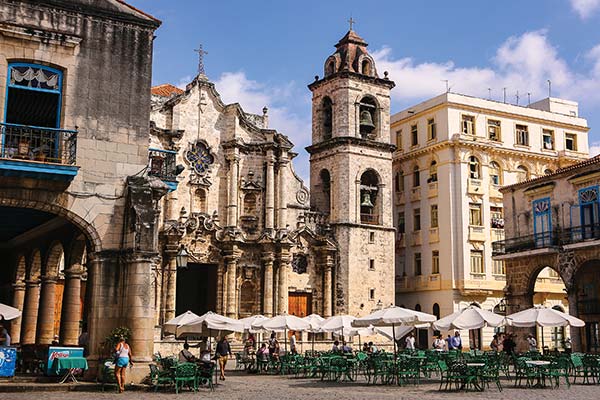
Plaza de la Catedral
On the north side of the plaza and known colloquially as Catedral Colón (Columbus Cathedral) is the Catedral San Cristóbal de la Habana (St. Christopher’s Cathedral, tel. 07/861-7771, Mon.-Fri. 9am-5pm, Sat.-Sun. 9am-noon, tower tour CUC1), initiated by the Jesuits in 1748. The order was kicked out of Cuba by Carlos III in 1767, but the building was eventually completed in 1777 and altered again in the early 19th century. The original baroque interior (including the altar) is gone, replaced in 1814 by a classical interior.
The baroque facade is adorned with clinging columns and ripples like a great swelling sea; Cuban novelist Alejo Carpentier thought it “music turned to stone.” A royal decree of December 1793 elevated the church to a cathedral. A second bell tower, narrower than the first, was added. Columns divide the rectangular church into three naves. The neoclassical main altar is made of wood; the murals above are by Italian painter Guiseppe Perovani. The chapel immediately to the left has several altars. Note the wooden image of Saint Christopher, patron saint of Havana, dating to 1633.
The Spanish believed that a casket brought to Havana from Santo Domingo in 1796 and that resided in the cathedral for more than a century held the ashes of Christopher Columbus. It was returned to Spain in 1899. All but the partisan habaneros now believe that the ashes were those of Columbus’s son Diego.
This splendid mansion, on the northwest side of the plaza, was built during the 16th century by Governor General Gonzalo Pérez de Angulo and has since been added to by subsequent owners. Today a café occupies the portico; the inner courtyard, with its fountain, houses the Restaurante El Patio. The upstairs restaurant offers splendid views over the plaza. Sunlight pouring in through stained glass mediopuntos saturates the floors with shifting colors.
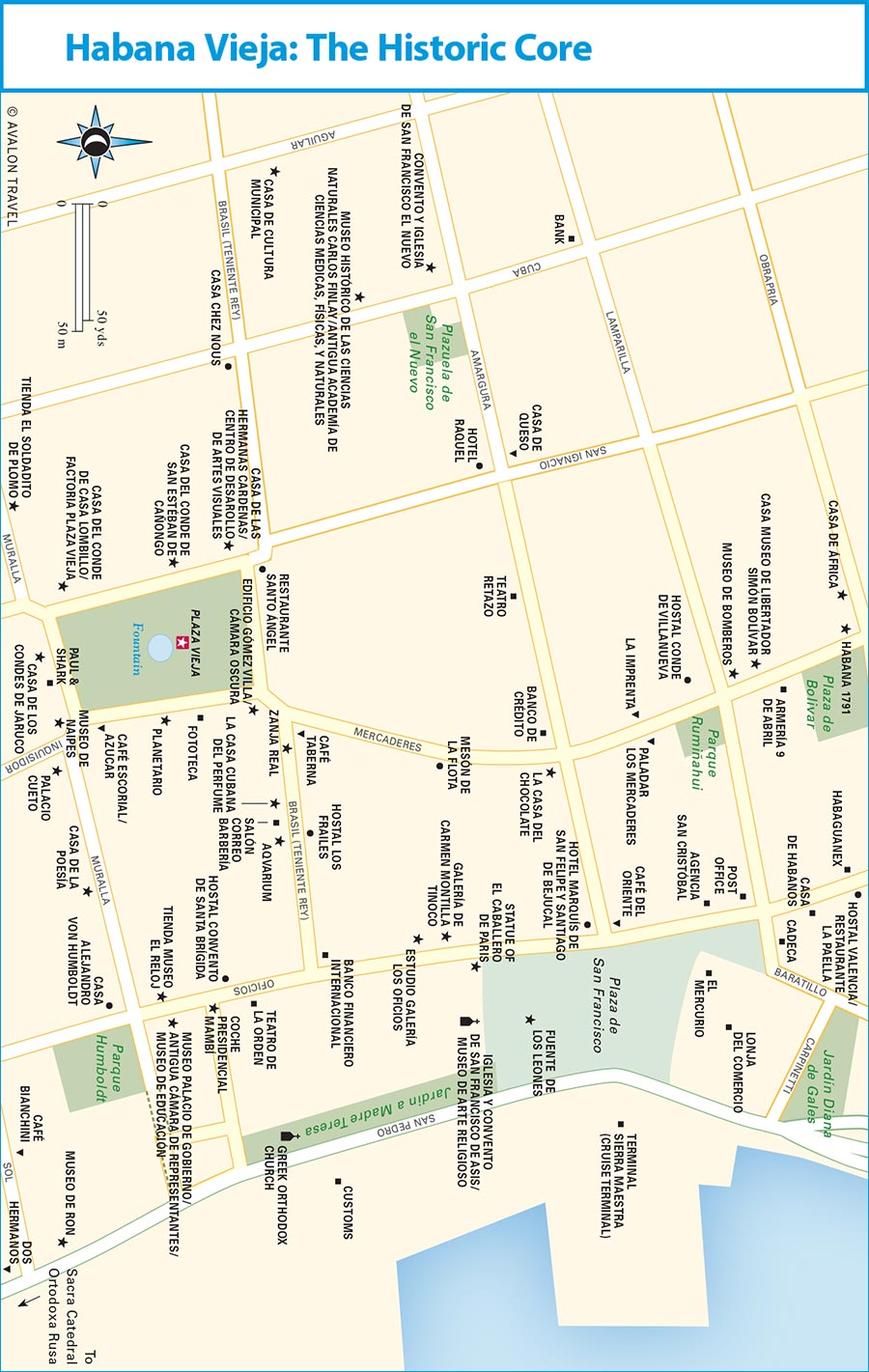
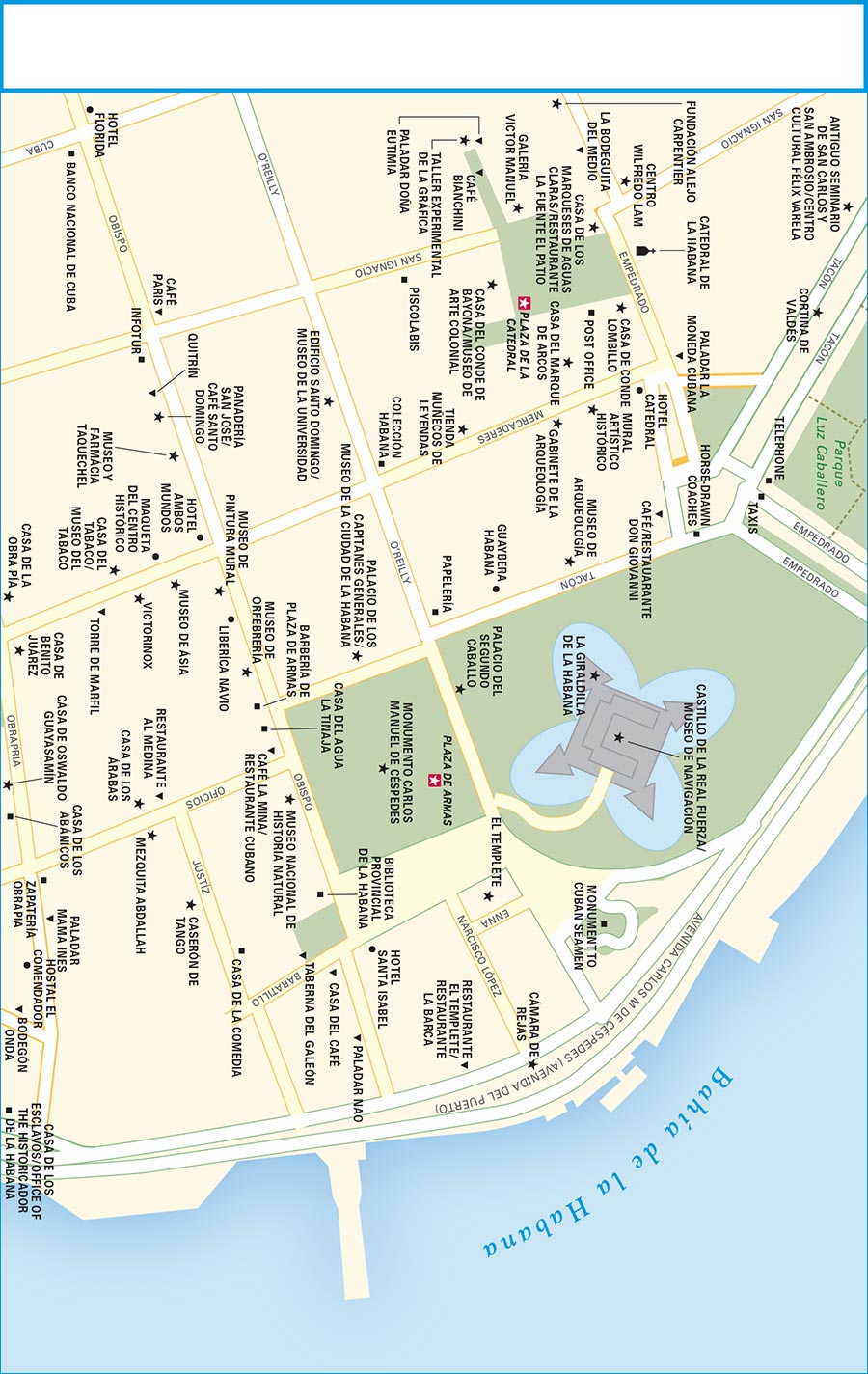
This simple two-story structure, on the south side of the square, is a perfect example of the traditional Havana merchant’s house of the period, with side stairs and an entresuelo (mezzanine of half-story proportions). It was built in the 1720s for Governor General Don Luis Chacón. Today it houses the Museo de Arte Colonial (Colonial Art Museum, San Ignacio #61, tel. 07/862-6440, daily 9:30am-5pm, entrance CUC2, cameras CUC5, guides CUC1), which re-creates the lavish interior of an aristocratic colonial home. One room is devoted to colorful stained glass vitrales.
At the southwest corner of the plaza, this short cul-de-sac is where a cistern was built to supply water to ships in the harbor. The aljibe (cistern) marked the terminus of the Zanja Real (the “royal ditch,” or chorro), a covered aqueduct that brought water from the Río Almendares some 10 kilometers away.
The Casa de Baños, which faces onto the square, looks quite ancient but was built in the 20th century in colonial style on the site of a bathhouse erected over the aljibe. Today the building contains the Galería Victor Manuel (San Ignacio #56, tel. 07/861-2955, daily 9am-8pm), selling quality arts.
At the far end of Callejón del Chorro is the not-to-be-missed Taller Experimental de la Gráfica (tel. 07/864-7622, tgrafica@cubarte.cult.cu, Mon.-Fri. 9am-4pm), a graphics cooperative where you can watch artists make prints for sale using antique presses and lithographic stones.
On the plaza’s east side is the Casa de Conde de Lombillo (tel. 07/860-4311, Mon.-Fri. 9am-5pm, Sat. 9am-1pm, free). Built in 1741, this former home of a slave trader houses a small post office (Cuba’s first), as it has since 1821. The building now holds historical lithographs. The mansion adjoins the Casa del Marqués de Arcos, built in the 1740s for the royal treasurer. What you see is the rear of the mansion; the entrance is on Calle Mercaderes, where the building facing the entrance is graced by the Mural Artístico-Histórico, by Cuban artist Andrés Carrillo. A restoration of the mansion was completed in 2017; the venue now hosts the Café Literario Marque de Arcos café, library, and exhibition space.
The two houses are fronted by a wide portico supported by thick columns. Note the mailbox set into the wall, a grotesque face of a tragic Greek mask carved in stone, with a scowling mouth as its slit. A life-size bronze statue of Spanish flamenco dancer Antonio Gades (1936-2004) leans against one of the columns.
The Centro Wilfredo Lam (San Ignacio #22, esq. Empedrado, tel. 07/864-6282, www.wlam.cult.cu, Tues.-Sat. 10am-5pm), on cobbled Empedrado, on the northwest corner of the plaza, occupies the former mansion of the counts of Peñalver. This art center displays works by the eponymous Cuban artist as well as artists from Latin America. The institution studies and promotes contemporary art from around the world.
No visit to Havana is complete without popping into La Bodeguita del Medio (Empedrado #207, tel. 07/866-8857, daily 10am-midnight), half a block west of the cathedral. This neighborhood hangout was originally the coach house of the mansion next door. Later it was a bodega, a mom-and-pop grocery store where Spanish immigrant Ángel Martínez served food and drinks.
Today troubadours move among thirsty turistas and the house drink is the somewhat weak mojito. Adorning the walls are posters, paintings, and faded photos of Ernest Hemingway, Carmen Miranda, and other famous visitors. The walls were once decorated with the signatures and scrawls of visitors dating back decades. Alas, a renovation wiped away much of the original charm; the artwork was erased and replaced in ersatz style, with visitors being handed blue pens (famous visitors now sign a chalkboard). The most famous graffiti is credited to Hemingway: “Mi mojito en La Bodeguita, mi daiquirí en El Floridita,” he supposedly scrawled on the sky-blue walls. According to Tom Miller in Trading with the Enemy, Martínez concocted the phrase as a marketing gimmick after the writer’s death. Errol Flynn thought it “A Great Place to Get Drunk.”
Built in the 1820s, at the peak of the baroque era, this home has a trefoil-arched doorway opening onto a zaguán (courtyard). Exquisite azulejos (painted tiles) decorate the walls. Famed novelist Alejo Carpentier used the house as the main setting for his novel El Siglo de las Luces (The Enlightenment). A portion of the home, which houses the Centro de Promoción Cultural, is dedicated to his memory as the Fundación Alejo Carpentier (Empedrado #215, tel. 07/861-5506, www.fundacioncarpentier.cult.cu, Mon.-Fri. 8:30am-4:30pm, free).
One block west, tiny Plazuela de San Juan de Dios (Empedrado, e/ Habana y Aguiar) is pinned by a white marble facsimile of Don Quixote author Miguel de Cervantes sitting in a chair, pen in hand, lending the plaza its colloquial name: Parque Cervantes. Visitors on the revolutionary trail should continue one block north up Aguiar to Calle Tejadillo. To the right is the Museo Bufete Aspiazo-Castro-Risende (Tejadillo #57; tel. 07/861-5001, by appointment), the office where Fidel Castro worked as a lawyer 1950-1952. The Arzobispado de la Habana, the 18th-century home of the archbishop, is one block west at the corner of Tejadillo and Habana. The lovely interior is closed to public view.
The oldest and most important plaza in Habana Vieja, handsome Arms Square was laid out in 1519 and named Plaza de Iglesia for a church that was demolished in 1741 after an English warship, the ill-named HMS Invincible, was struck by lightning and exploded, sending its main mast sailing down on the church. Later, Plaza de Armas evolved to become the settlement’s administrative center, when military parades and musical concerts were held and the gentry would take their evening promenade.
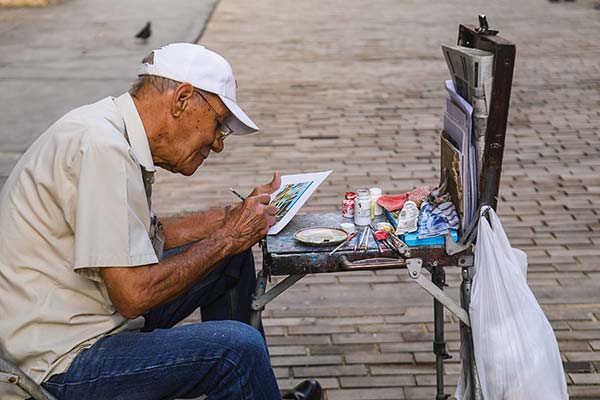
Cuban man painting in Plaza de Armas
Off the southeast corner of the square, tucked off Calle Baratillo, is an enclosed plazuela—the setting for Feria de Publicaciones y Curiosidades, with stalls selling tatterdemalion antiquarian books and small antiquities.
The somber yet stately Palacio de los Capitanes Generales (Palace of the Captains-Generals) was completed in 1791 and became home to 65 governors of Cuba between 1791 and 1898. After that, it was the U.S. governor’s residence, the early seat of the Cuban government (1902-1920), and Havana’s city hall (1920-1967).
The palace is fronted by a loggia supported by Ionic columns and by “cobblewood,” laid instead of stone to soften the noise of carriages and thereby lessen the disturbance of the governor’s sleep. The three-story structure surrounds a courtyard that contains a statue of Christopher Columbus by Italian sculptor Cucchiari. Arched colonnades rise on all sides. In the southeast corner, a hole containing the coffin of a nobleman is one of several graves from the old Cementerio de Espada. To the north end of the loggia is a marble statue of Fernando VII.
Today, the palace houses the Museo de la Ciudad de la Habana (City of Havana Museum, Tacón #1, e/ Obispo y O’Reilly, tel. 07/861-5001, Tues.-Sun. 9:30am-5pm, last entry at 4pm, entrance CUC3, cameras CUC5, guide CUC5). The stairs lead up to palatially furnished rooms. The Salón del Trono (Throne Room), made for the king of Spain but never used, is of breathtaking splendor. The museum also features the Salón de las Banderas (Hall of Flags), with magnificent artwork that includes The Death of Antonio Maceo by Menocal, plus exquisite collections illustrating the story of the city’s (and Cuba’s) development and the 19th-century struggles for independence.
On the park’s northwest corner, the austere Palacio del Segundo Cabo (Palace of the Second Lieutenant, O’Reilly #14, tel. 07/862-8091, Mon.-Fri. 6am-midnight) dates from 1770, when it was designed as the city post office. Later it became the home of the vice governor-general and, after independence, the seat of the Senate. Today it is a cultural center.
The pocket-size Castillo de la Real Fuerza (Royal Power Castle, O’Reilly #2, tel. 07/864-4490, Tues.-Sun. 9:30am-5pm, entrance CUC3, cameras CUC5), on the northeast corner of the plaza, was begun in 1558 and completed in 1577. It’s the oldest of the four forts that guarded the New World’s most precious harbor. Built in medieval fashion, with walls 6 meters wide and 10 meters tall, the castle forms a square with enormous triangular bulwarks at the corners, their sharp angles slicing the dark waters of the moat. It was almost useless from a strategic point of view, being landlocked far from the mouth of the harbor channel and hemmed in by surrounding buildings that would have formed a great impediment to its cannons in any attack. The governors of Cuba lived here until 1762.
Visitors enter via a courtyard full of cannons and mortars. Note the royal coat of arms carved in stone above the massive gateway as you cross the moat by a drawbridge.
The castle houses the not-to-be-missed Museo de Navegación (Naval Museum), displaying treasures from the golden age when the riches of the Americas flowed to Spain. The air-conditioned Sala de Tesoro gleams with gold bars and coins, plus precious jewels, bronze astrolabes, and silver reales (“pieces of eight”). The jewel in the crown is a four-meter interactive scale model of the Santisima Trinidad galleon, built in Havana 1767-1770 and destroyed at the Battle of Trafalgar.
A cylindrical bell tower rising from the northwest corner is topped by a bronze weathervane called La Giraldilla de la Habana showing a voluptuous figure with hair braided in thick ropes; in her right hand is a palm tree and in her left a cross. This figure is the official symbol of Havana. The vane is a copy; the original, which now resides in the foyer, was cast in 1631 in honor of Isabel de Bobadilla, the wife of Governor Hernando de Soto, the tireless explorer who fruitlessly searched for the fountain of youth in Florida. De Soto named his wife governor in his absence—the only female governor ever to serve in Cuba. For four years she scanned the horizon in vain for his return.
Immediately east of the castle, at the junction of Avenida del Puerto and O’Reilly, is an obelisk to the 77 Cuban seamen killed during World War II by German submarines.
A charming copy of a Doric temple, El Templete (The Pavilion, daily 9:30am-5pm, CUC1.50 including guide) stands on the northeast corner of the Plaza de Armas. It was inaugurated on March 19, 1828, on the site where the first mass and town council meeting were held in 1519, beside a massive ceiba tree. The original ceiba was felled by a hurricane in 1828 and replaced by a column fronted by a small bust of Christopher Columbus. A ceiba has since been replanted and today shades the tiny temple; its interior features a wall-to-ceiling triptych depicting the first mass, the council meeting, and El Templete’s inauguration. In the center of the room sits a bust of the artist, Jean-Baptiste Vermay (1786-1833).
Immediately south of El Templete is the former Palacio del Conde de Santovenia (Baratillo, e/ Narciso López y Baratillo y Obispo). Its quintessentially Cuban-colonial facade is graced by a becolumned portico and, above, wrought-iron railings on balconies whose windows boast stained glass mediopuntos. The conde (count) in question was famous for hosting elaborate parties, most notoriously a three-day bash in 1833 to celebrate the accession to the throne of Isabel II that climaxed with the ascent of a gaily decorated gas-filled balloon. Later that century the building served as a hotel. Today it’s the Hotel Santa Isabel. President Carter stayed here during his visit to Havana in 2002.
On the south side of the plaza, the Museo Nacional de Historia Natural (Natural History Museum, Obispo #61, e/ Oficios y Baratillo, tel. 07/863-9361, museo@mnhnc.inf.cu, Tues.-Sun. 9:30pm-5pm, CUC3) covers evolution in a well-conceived display. The museum houses collections of Cuban flora and fauna—many in clever reproductions of their natural environments—plus stuffed tigers, apes, and other beasts from around the world. Children will appreciate the interactive displays.
Immediately east, the Biblioteca Provincial de la Habana (Havana Provincial Library, tel. 07/862-9035, Mon.-Fri. 8:15am-7pm, Sat. 8:15am-4:30pm, Sun. 8:15am-1pm) once served as the U.S. Embassy.
One block south along Calle Oficios, at the corner of Justiz, the former Depósito del Automóvil has been beautifully restored as Mezquita Abdallah (Oficios #18, no tel.)—a mosque and the only place in Havana where Muslims can practice the Islamic faith. The prayer hall is decorated with hardwoods inlaid with mother-of-pearl. Only Muslims may enter, but you can peer in at the beautiful Mughal architecture through glass-panel doors.
Across the street, the Casa de los Árabes (Arabs’ House, Oficios #12, tel. 07/861-5868, Tues.-Sat. 9am-4:30pm, Sun. 9am-1pm, free) comprises two Moorish-inspired 17th-century mansions that house a small yet impressive museum dedicated to a Levantine and Islamic theme.
Cobbled Plaza de San Francisco, two blocks south of Plaza de Armas, at Oficios and the foot of Amargura, faces onto Avenida del Puerto. During the 16th century this area was the waterfront. Iberian emigrants disembarked, slaves were unloaded, and galleons were replenished and treasure fleets loaded for the passage to Spain. A market developed on the plaza, which became the focus of the annual Fiesta de San Francisco each October 3, when a gambling fair was established. At its heart is the Fuente de los Leones (Fountain of the Lions) by Giuseppe Gaggini, erected in 1836.
The five-story neoclassical building on the north side is the Lonja del Comercio (Goods Exchange, Amargura #2, esq. Oficios, tel. 07/866-9588, Mon.-Sat. 9am-6pm), dating from 1907, when it was built as a center for commodities trading. Restored, it houses offices of international corporations, news bureaus, and tour companies. The dome is crowned by a bronze figure of the god Mercury.
Behind the Lonja del Comercio, entered by a wrought-iron archway topped by a most-uncommunist fairytale crown, is the Jardín Diana de Gales (Baratillo, esq. Carpinetti, daily 9am-6pm), a park unveiled in 2000 in memory of Diana, Princess of Wales. The three-meter-tall column is by acclaimed Cuban artist Alfredo Sosabravo. There’s also an engraved Welsh slate and stone plaque from Althorp, Diana’s childhood home, donated by the British Embassy.
The garden backs onto the Casa de los Esclavos (Obrapía, esq. Av. del Puerto), a slave-merchant’s home that now serves as the principal office of the city historian.
Dominating the plaza on the south side, the Iglesia y Convento de San Francisco de Asís (Oficios, e/ Amargura y Brasil, tel. 07/862-9683, daily 9am-5:30pm, entrance CUC2, guide CUC1, cameras CUC2, videos CUC10) was completed in 1730 in baroque style with a 40-meter bell tower. The church was eventually proclaimed a basilica, serving as Havana’s main church. It was from here that the processions of the Vía Crucis (Procession of the Cross) departed every Lenten Friday, ending at the Iglesia del Santo Cristo del Buen Vieja. The devout passed down Calle Amargura (Street of Bitterness), where stations of the cross were set up at street corners. After the Protestant English worshiped here in 1762, the Catholic Spanish considered it desecrated and it was never again used for religious purposes.
The main nave, with its towering roof supported by 12 columns, each topped by an apostle, features a trompe l’oeil that extends the perspective of the nave. The sumptuously adorned altars are gone, replaced by a huge crucifix suspended above a grand piano. (The cathedral serves as a concert hall, with classical music performances hosted 6pm Sat. and 11am Sun. Sept.-June.) Aristocrats were buried in the crypt; some skeletons can be seen through clear plastic set into the floor. Climb the campanile (CUC1) for a panoramic view. A side nave contains the Museo de Arte Sacro, featuring religious icons.
A life-size bronze statue (by José Villa Soberón) of an erstwhile and once-renowned tramp known as El Caballero de París (Gentleman of Paris) graces the sidewalk in front of the cathedral entrance. Many Cubans believe that touching his beard will bring good luck.
On the basilica’s north side is Jardín Madre Teresa de Calcuta, a garden dedicated to Mother Teresa. It contains the small Iglesia Ortodoxa Griega, a Greek Orthodox church opened in 2004.
Facing the cathedral, cobbled Calle Oficios is lined with 17th-century colonial buildings that possess a marked Mudejar style, exemplified by their wooden balconies. Many of the buildings have been converted into art galleries, including Galería de Carmen Montilla Tinoco (Oficios #162, tel. 07/866-8768, Mon.-Sat. 9am-5pm, free); only the front of the house remains, but the architects have made creative use of the empty shell. Next door, Estudio Galería Los Oficios (Oficios #166, tel. 07/863-0497, Mon.-Sat. 9:30am-5pm, Sun. 9am-1pm, free) displays works by renowned artist Nelson Domínguez.
Midway down the block, cobbled Calle Brasil extends west about 80 meters to Plaza Vieja. Portions of the original colonial-era aqueduct (the Zanja Real) are exposed. Detour to visit the Aqvarium (Brasil #9, tel. 07/863-9493, Tues.-Sat. 9am-5pm, Sun. 9am-1pm, CUC1, children free), displaying tropical fish. Next door, La Casa Cubana del Perfume (Brasil #13, tel. 07/866-3759, Mon.-Sat. 10am-7pm, Sun. 10am-1pm) displays colonial-era distilleries, has aromatherapy demos, and sells handmade perfumes made on-site.
Back on Oficios, the former Casa de Don Lorenzo Montalvo houses a convent and the Hostal Convento de Santa Brígida. To its side, the Coche Presidencial Mambí railway carriage (Mon.-Fri. 8:30am-4:45pm, CUC1) stands on rails at Oficios and Churruca. It served as the official presidential carriage of five presidents, beginning in 1902 with Tomás Estrada Palma. Its polished hardwood interior gleams with brass fittings.
The door inset in the wall behind the carriage opens to the Salón Blanco, housing El Genio de Leonardi da Vinci Exhibición Permanente (no tel., Tues.-Sat. 9:30am-4pm, CUC2), dedicated to the Renaissance genius. It displays copies (and contemporary reinterpretations) of his artwork, plus magnificent 3-D models of his inventions—from bicycles, gliders, and helicopters to a diving suit—all labeled in various languages. Da Vinci (1452-1519) died the year of Havana’s founding.
Immediately east of the Coche is the Museo Palacio de Gobierno (Government Palace Museum, Oficios #211, esq. Muralla, tel. 07/863-4358, Tues.-Sat. 9:30am-5pm, Sun. 9:30am-1pm). This 19th-century neoclassical building housed the Cámara de Representantes (Chamber of Representatives) during the early republic. Later it served as the Ministerio de Educación (1929-1960) and, following the Revolution, housed the Poder Popular Municipal (Havana’s local government office). Today it has uniforms, documents, and other items relating to its past use, and the office of the President of the Senate is maintained with period furniture. The interior lobby is striking for its magnificent stained glass skylight.
The Tienda Museo el Reloj (Watch Museum, Oficios, esq. Muralla, tel. 07/864-9515, Mon.-Sat. 10am-7pm, Sun. 10am-1pm) doubles as a watch and clock museum, and a deluxe store selling watches and pens made by Cuervo y Sobrinos, a Swiss-Italian company that began life in Cuba in 1882.
On the southeast side of Oficios and Muralla is Casa Alejandro Von Humboldt (Oficios #254, tel. 07/863-9850, Tues.-Sat. 9am-5pm, Sun. 9am-noon, CUC1), a museum dedicated to the German explorer (1769-1854) who lived here while investigating Cuba in 1800-1801.
The last of the four main squares to be laid out in Habana Vieja, Plaza Vieja (Old Square, bounded by Calles Mercaderes, San Ignacio, Brasil, and Muralla) originally hosted a covered market. It is surrounded by mansions and apartment blocks where, in colonial times, residents looked down on executions and bullfights.
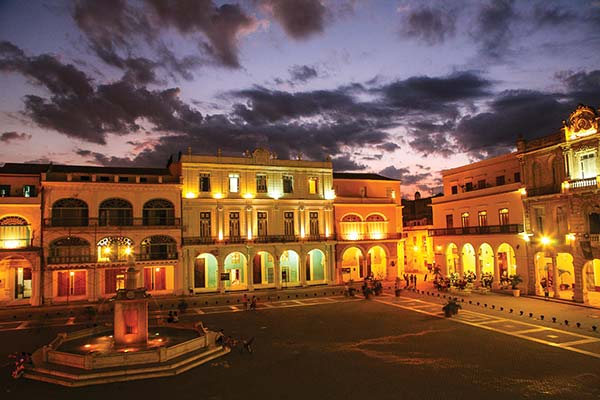
Plaza Vieja at night
In the 20th century the square sank into disrepair. Today it is in the final stages of restoration. Even the white Carrara marble fountain—an exact replica of the original by Italian sculptor Giorgio Massari—has reappeared. Two decades ago, most buildings were squalid tenements; the tenants have since moved out as the buildings metamorphosed into boutiques, restaurants, museums, and luxury apartments for foreign residents.
Various modern sculptures grace the park. At the southeast corner is Viaje Fantástico, by Roberto Fabelo—a bronze figure of a bald, naked woman riding a rooster.
The tallest building is the Edificio Gómez Villa, on the square’s northeast corner. Take the elevator to the top for views over the plaza and to visit the Cámara Oscura (tel. 07/866-4461, daily 9am-5:30pm, CUC2). The optical reflection camera revolves 360 degrees, projecting a real-time picture of Havana at 30 times the magnification onto a two-meter-wide parabola housed in a completely darkened room.
The shaded arcade along the plaza’s east side leads past the Casa de Juan Rico de Mata, today the headquarters of Fototeca (Mercaderes #307, tel. 07/862-2530, fototeca@cubarte.cult.cu, Tues.-Sat. 10am-5pm), the state-run agency that promotes the work of Cuban photographers. It hosts photo exhibitions.
Next door, the Planetario Habana (Mercaderes #309, tel. 07/864-9544, shows Wed.-Sat. 9:30am-5pm, Sun. 9:30am-12:30pm, CUC10 adults, children under 12 free) delights visitors with its high-tech interactive exhibitions on space science and technology. A scale model of the solar system spirals around the sun in the 66-seat theater.
The old Palacio Cueto, on the southeast corner of Plaza Vieja, is a phenomenal piece of Gaudí-esque art nouveau architecture dating from 1906. It awaits restoration as a hotel.
On the southeast corner, the Casa de Marqués de Prado Amero today houses the Museo de Naipes (Museum of Playing Cards, Muralla #101, tel. 07/860-1534, Tues.-Sat. 9:30am-5pm, Sun. 9am-2:30pm, entrance by donation), displaying playing cards through the ages.
The 18th-century Casa de los Condes de Jaruco (House of the Counts of Jaruco, Muralla #107), or “La Casona,” on the southeast corner, was built between 1733 and 1737. It is highlighted by mammoth doors that open into a cavernous courtyard surrounded by lofty archways festooned with hanging vines. Art galleries (Tues.-Sat. 9am-5pm) occupy the downstairs.
On the plaza’s southwest corner, cool off with a chilled beer brewed on-site in the Factoría de Plaza Vieja (San Ignacio #364, tel. 07/866-4453, daily 11am-1am), in the former Casa del Conde de Casa Lombillo. The copper stills are displayed in the main bar, where a 1913 Ford delivery truck now sits amid artworks by such famous Cuban artists as Kcho and Nelson Domínguez. Accessed via a door next to the brewpub is the Taller de Luthiería (tel. 07/801-8339), a workshop run by Habaguanex that repairs string instruments.
The Casa del Conde de San Estéban de Cañongo (San Ignacio #356, tel. 07/868-3561, Mon.-Fri. 9:30am-5:30pm, Sat. 9:30am-1pm) is today a cultural center. Adjoining, on the northwest corner of the plaza, is the Casa de las Hermanas Cárdenas, housing the Centro de Desarollo de Artes Visuales (San Ignacio #352, tel. 07/862-2611, Tues.-Sat. 10am-6pm). The inner courtyard is dominated by an intriguing sculpture by Alfredo Sosabravo. Art education classes are given on the second floor. The top story has an art gallery.
Well worth the side trip is Hotel Raquel (San Ignacio, esq. Amargura, tel. 07/860-8280), one block north of the plaza. This former 1908 bank and warehouse is an architectural jewel with a stunning stained glass atrium ceiling and art nouveau facade. The hotel is themed to honor the city’s former Jewish community.
One block west and one north of the plaza is the Museo Histórico de las Ciencias Naturales Carlos Finlay (Museum of Natural History, Cuba #460, e/ Amargura y Brasil, tel. 07/863-4824, Mon.-Fri. 9am-5pm, Sat. 9am-1pm, CUC2). Dating from 1868 and once the headquarters of the Academy of Medical, Physical, and Natural Sciences, today it contains a pharmaceutical collection and tells the tales of Cuban scientists’ discoveries and innovations. The Cuban scientist Dr. Finlay is honored, of course; it was he who on August 14, 1881, discovered that yellow fever is transmitted by the Aedes aegipti mosquito. The museum also contains, on the third floor, a reconstructed period pharmacy.
Adjoining the museum to the north, the Convento y Iglesia de San Francisco el Nuevo (Cuba, esq. Amargura, tel. 07/861-8490, free) was completed in 1633 for the Augustine friars. It was consecrated anew in 1842, when it was given to the Franciscans, who then rebuilt it in renaissance style in 1847. The church has a marvelous domed altar and nave.
The mostly residential and dilapidated southern half of Habana Vieja, south of Calle Brasil, was the ecclesiastical center of Havana during the colonial era and is studded with churches and convents. This was also Havana’s Jewish quarter.
Southern Habana Vieja is enclosed by Avenida del Puerto, which swings along the harborfront and becomes Avenida San Pedro, then Avenida Leonor Pérez, then Avenida Desamparados as it curves around to Avenida de Bélgica (colloquially called Egido). The waterfront boulevard is overshadowed by warehouses. Here were the old P&O docks where the ships from Miami and Key West used to land and where Pan American World Airways had its terminal when it was still operating the old clipper flying boats.
Egido follows the hollow once occupied by Habana Vieja’s ancient walls. It is a continuation of Monserrate and flows downhill to the harbor. The Puerta de la Tenaza (Egido, esq. Fundición) is the only ancient city gate still standing; a plaque inset in the wall shows a map of the city walls as they once were. About 100 meters south, on Avenida de Puerto, the Monumento Mártires del Vapor La Coubre is made of twisted metal fragments of La Coubre, the French cargo ship that exploded in Havana harbor on March 4, 1960 (the vessel was carrying armaments for the Castro government). The monument honors the seamen who died in the explosion.
Egido’s masterpiece is the Estación Central de Ferrocarril (esq. Arsenal), or Terminal de Trenes, Havana’s railway station. Designed in 1910, it blends Spanish Revival and Italian Renaissance styles and features twin towers displaying the shields of Havana and Cuba (and a clock permanently frozen at 5:20). It is built atop the former Spanish naval shipyard. It closed in 2015 for a long restoration that will incorporate contemporary architecture.
On the station’s north side, the small, shady Parque de los Agrimensores (Park of the Surveyors) features a remnant of the Cortina de la Habana, the old city wall. The park is now populated by steam trains retired from hauling sugarcane; the oldest dates from 1878.
Two blocks north of the park, do not miss the Mercado Agropecuario Egido (e/ Apodaca y Corrales), Havana’s most colorful farmers market. Take (and hold on to) your camera! Head two blocks west, then turn left onto Cárdenas. The two blocks between Misión y Apodaca feature some astounding examples of Gaudi-style art nouveau architecture (especially noteworthy are #103, #107, and #161).
The birthplace of Cuba’s preeminent national hero, Museo Casa Natal de José Martí (Leonor Pérez #314, esq. Av. de Bélgica, tel. 07/861-3778, Tues.-Sat. 9am-5pm, entrance CUC1, guide CUC1, cameras CUC2, videos CUC10) sits one block south of the railway station at the end of a street named after Martí’s mother. The leader of the independence movement was born on January 28, 1853, in this simple house with terra-cotta tile floors. The house displays many of his personal effects, including an escritorio (writing desk) and even a lock of Martí’s hair.
The Iglesia y Convento de Nuestra Señora de Belén (Church and Convent of Our Lady of Bethlehem, Compostela y Luz, tel. 07/860-3150, Mon.-Sat. 10am-4pm, Sun. 9am-1pm, free; visits only with a prearranged guide with Agencia San Cristóbal), the city’s largest religious complex, occupies an entire block. The convent, completed in 1718, was built to house the first nuns to arrive in Havana and later served as a refuge for convalescents. In 1842, Spanish authorities ejected the religious order and turned the complex over to the Jesuits, who established a college for the sons of the aristocracy. As the nation’s official weather forecasters, they erected the Observatorio Real (Royal Observatory) atop the tower in 1858; it was in use until 1925. The church and convent are linked to contiguous buildings across the street by an arched walkway—the Arco de Belén (Arch of Bethlehem)—spanning Acosta.
Partially restored, the Iglesia y Convento de Santa Clara de Asís (Convent of Saint Clair of Assisi, Cuba #610, e/ Luz y Sol, tel. 07/761-3335), two blocks east of Belén, is a massive former nunnery completed in 1644. The nuns moved out in 1922. It is a remarkable building, with a lobby full of beautiful period pieces. The cloistered courtyard is surrounded by columns. Note the 17th-century fountain of a Samaritan woman, and the beautiful cloister roof carved with geometric designs—a classic alfarje—in the Salón Plenario, a marble-floored hall of imposing stature. Wooden carvings abound. The second cloister contains the so-called Sailor’s House, built by a wealthy ship owner for his daughter, whom he failed to dissuade from a life of asceticism.
The Iglesia Parroquial del Espíritu Santo (Parish Church of the Holy Ghost, Acosta #161, esq. Cuba, tel. 07/862-3410, Mon.-Fri. 8am-noon and 3pm-6pm), two blocks south of Santa Clara de Asís, is Havana’s oldest church, dating from 1638 (the circa-1674 central nave and facade, as well as the circa-1720 Gothic vault, are later additions), when it was a hermitage for the devotions of free blacks. Later, King Charles III granted the right of asylum here to anyone hunted by the authorities.
The church’s many surprises include a gilded, carved wooden pelican in a niche in the baptistry. The sacristy, where parish archives dating back through the 17th century are preserved, boasts an enormous cupboard full of baroque silver staffs and incense holders. Catacombs to the left of the nave are held up by subterranean tree trunks. You can explore the eerie vault that runs under the chapel, with the niches still containing the odd bone. Steps lead up to the bell tower.
Iglesia y Convento de Nuestra Señora de la Merced (Our Lady of Mercy, Cuba #806, esq. Merced, tel. 07/863-8873, daily 8am-noon and 3pm-6pm) is Havana’s most impressive church, thanks to its ornate interior multiple dome paintings and walls entirely painted in early-20th-century religious frescoes. The church, begun in 1755, has strong Afro-Cuban connections (the Virgin of Mercy is also Obatalá, goddess of earth and purity), drawing devotees of Santería. Each September 24, scores of worshippers cram in for the Virgen de la Merced’s feast day. More modest celebrations are held on the 24th of every other month.
Boxing fans might nip across the street to Gimnasio Rafael Trejo (Cuba #815, tel. 07/862-0266, Fri. 7pm), where young boxers train in a tumbledown open-air facility.
The 100-meter-long Alameda de Paula promenade runs alongside the waterfront boulevard between Luz and Leonor Pérez. Lined with marble and iron street lamps, the promenade is the midst of a two-decades-long remodeling project. In 2016, it gained a new ferry terminal and statues.
The raised central median that is the Alameda proper begins on the south side of Parque Aracelio Iglesias (Av. del Puerto y Luz), where passengers alight ferries at Emboque de Luz terminal. Two blocks south at Calle Jesús María stands a carved column with a fountain at its base, erected in 1847 in homage to the Spanish navy. It bears an unlikely Irish name: Columna O’Donnell, for the Capitán-General of Cuba, Leopoldo O’Donnell, who dedicated the monument. It is covered in relief work on a military theme and crowned by a lion with the arms of Spain in its claws.
At the southern end of the Alameda, Iglesia de San Francisco de Paula (San Ignacio y Leonor Pérez, tel. 07/860-4210, daily 9am-5pm) highlights the circular Plazuela de Paula. The quaint, restored church features marvelous artworks including stained glass pieces. It is used for baroque and chamber concerts. To its east, occupying a waterfront wharf, is the Antiguo Almacén de Madera y el Tabaco (daily noon-midnight), a beer hall with an on-site brewery.
A stone’s throw south, the Centro Cultural Almacenes de San José (Av. Desamparados at San Ignacio, tel. 07/864-7793, daily 10am-6pm), or Feria de la Artesanía—the city’s main arts and crafts market—also occupies a former waterfront warehouse. Several antique steam trains sit on rails outside. Immediately to the south is the Museo de Automóviles (Automobile Museum, Desemparados esq. Damas, tel. 07/863-9942, automovil@bp.patrimonio.ohc.cu, Tues.-Sat. 9:30am-5pm, Sun. 9am-1pm, entrance CUC1.50, cameras CUC2, videos CUC10), displaying an eclectic range of 30 antique automobiles—from a 1905 Cadillac to singer Benny More’s 1953 MGA and revolutionary leader Camilo Cienfuegos’s 1959 mint Oldsmobile. Classic Harley-Davidson motorcycles are also exhibited.
Two blocks north of Luz is the Fundación Destilería Havana Club, or Museo del Ron (Museum of Rum, Av. San Pedro #262, e/ Muralla y Sol, tel. 07/861-8051, daily 9:30am-5:30pm, CUC7 including guide and drink). Occupying the former colonial mansion of the Conde de la Mortera, it’s a must-see introduction to the manufacture of Cuban rum. Tours begin with an audiovisual presentation and include exhibits such as a mini-cooperage, pailes (sugar boiling pots), wooden trapiches (sugarcane presses), salas dedicated to an exposition on sugarcane, and the colonial sugar mills where the cane was pressed and the liquid processed. An operating production unit replete with bubbling vats and copper demonstrates the process. The highlight is a model of an early-20th-century sugar plantation at 1:22.5 scale, complete with working steam locomotives.
Hemingway once favored Dos Hermanos (Av. San Pedro #304, esq. Sol, tel. 07/861-3514), a simple bar immediately south of the museum.
Immediately south of Dos Hermanos bar is the beautiful, gleaming white Sacra Catedral Ortodoxa Rusa (Russian Orthodox Cathedral, Av. del Puerto and Calle San Pedro, daily 9am-5:45pm), a 21st-century construction. Officially called the Iglesia Virgen de María de Kazan, it whisks you allegorically to Moscow with its bulbous, golden minarets. No photos are allowed inside, where a gold altar and chandeliers hang above gray marble floors.
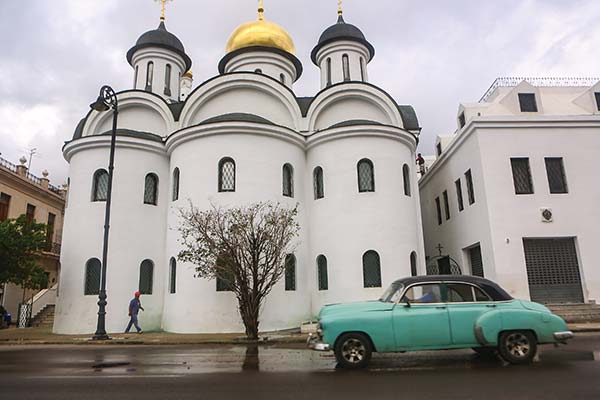
Sacra Catedral Ortodoxa Rusa
Laid out in a near-perfect grid, mostly residential Centro Habana (Central Havana, pop. 175,000) lies west of the Paseo de Martí and south of the Malecón. The region evolved following demolition of the city walls in 1863. Prior, it had served as a glacis. The buildings are deep and tall, of four or five stories, built mostly as apartment units. Many houses are in a tumbledown state, and barely a month goes by without at least one building collapse.
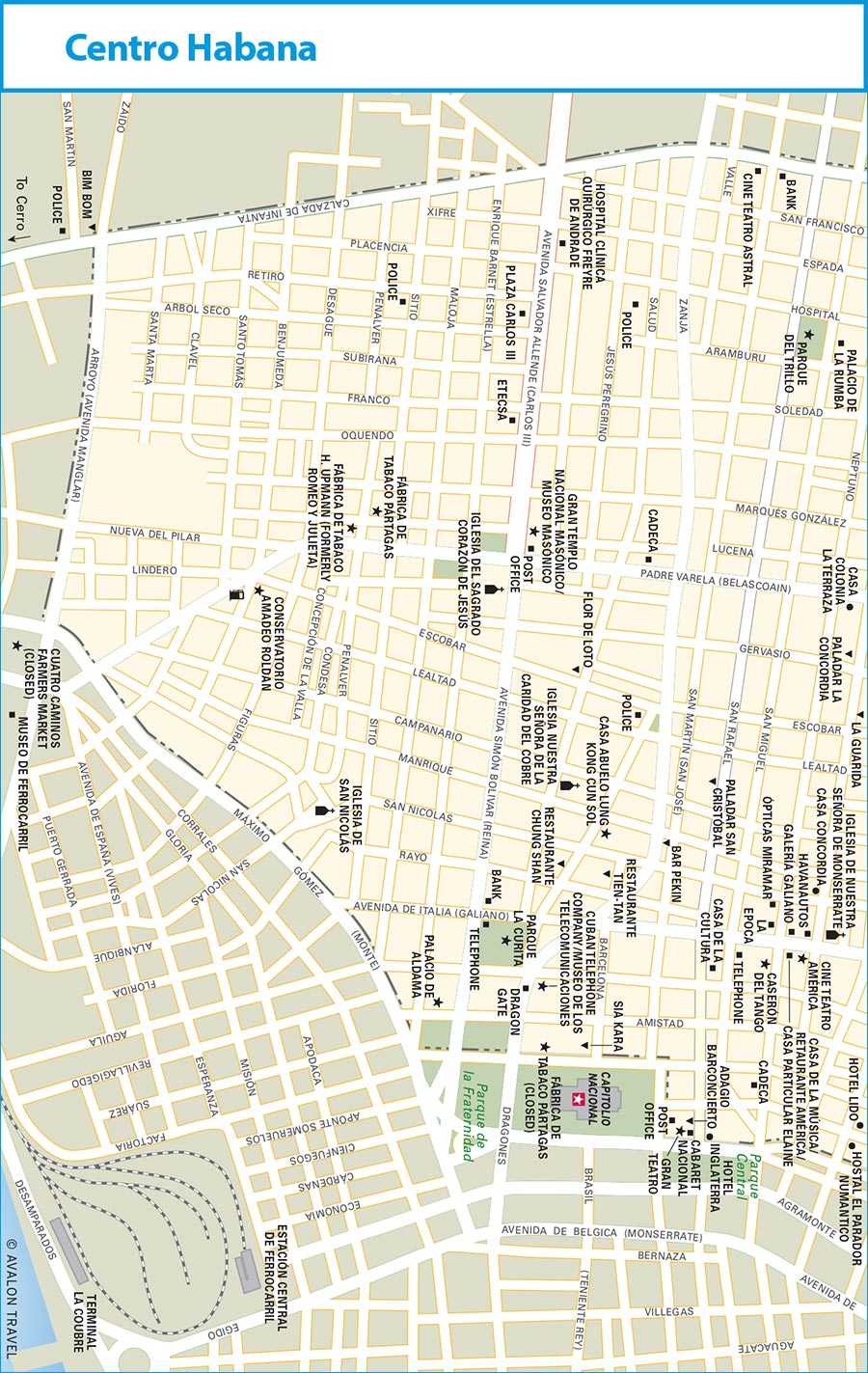
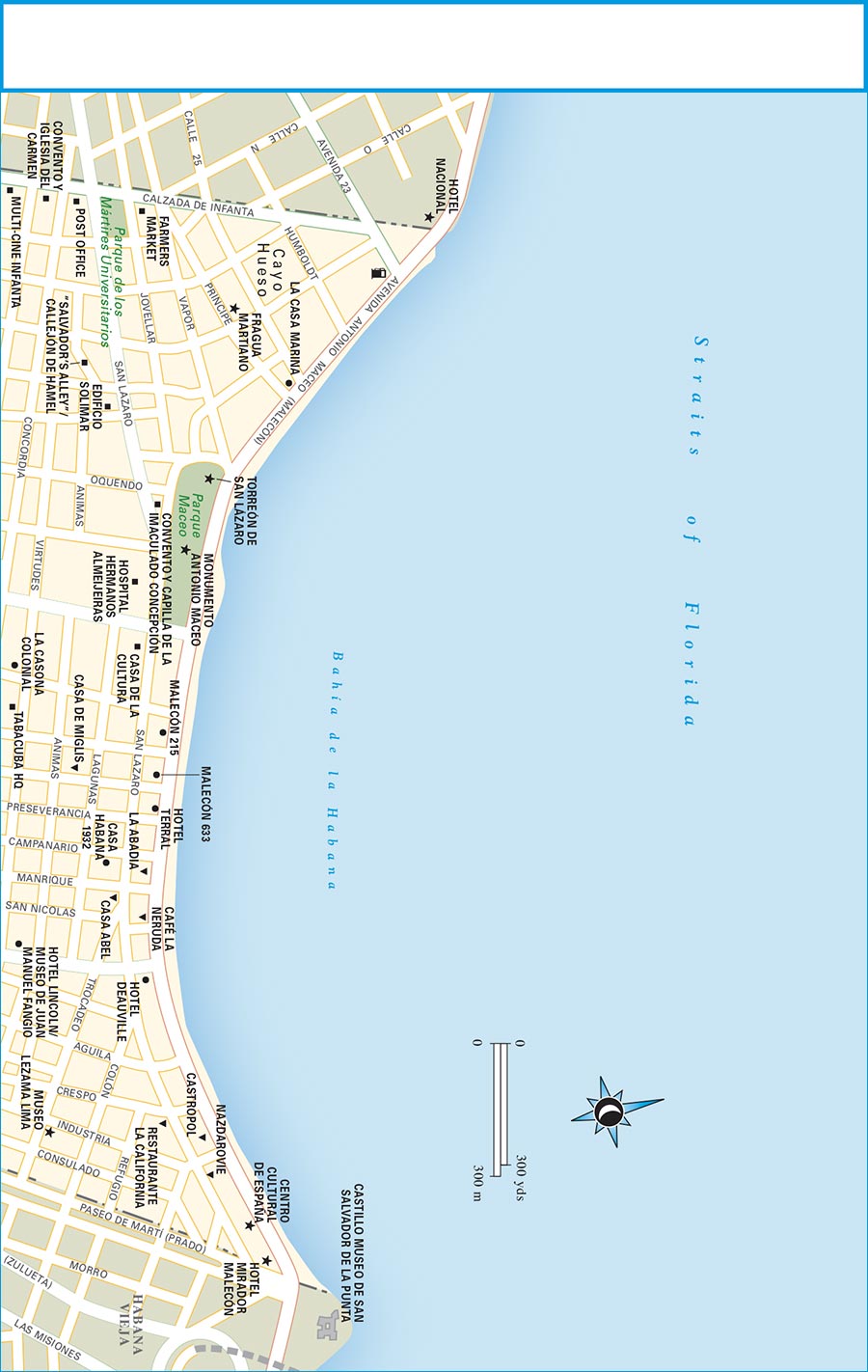
The major west-east thoroughfares are the Malecón to the north and Zanja and Avenida Salvador Allende through the center, plus Calles Neptuno and San Rafael between the Malecón and Zanja. Three major thoroughfares run perpendicular, north-south: Calzada de Infanta, forming the western boundary; Padre Varela, down the center; and Avenida de Italia (Galiano), farther east.
In prerevolutionary days, Centro Habana hosted Havana’s red-light district, and prostitutes roamed such streets as the ill-named Calle Virtudes (Virtues). Neptuno and San Rafael formed the retail heart of the city. The famous department stores of prerevolutionary days still bear neon signs promoting U.S. brand names from yesteryear.
Caution is required, as snatch-and-grabs and muggings are common.
Officially known as Avenida Antonio Maceo, and more properly the Muro de Malecón (literally “embankment,” or “seawall”), Havana’s seafront boulevard winds dramatically along the Atlantic shoreline between the Castillo de San Salvador de la Punta and the Río Almendares. The six-lane seafront boulevard was designed as a jetty wall in 1857 by Cuban engineer Francisco de Albear but not laid out until 1902, by U.S. governor General Leonard Wood. It took 50 years to reach the Río Almendares, almost five miles to the west.
The Malecón is lined with once-glorious high-rise houses, each exuberantly distinct from the next. Unprotected by seaworthy paint, they have proven incapable of withstanding the salt spray that crashes over the seawall. Many buildings have already collapsed, and an ongoing restoration has made little headway against the elements.
All along the shore are the worn remains of square baths—known as the “Elysian Fields”—hewn from the rocks below the seawall, originally with separate areas for men, women, and blacks. These Baños del Mar preceded construction of the Malecón. Each is about four meters square and two meters deep, with rock steps for access and a couple of portholes through which the waves wash in and out.
The Malecón offers a microcosm of Havana life: the elderly walking their dogs; the shiftless selling cigars and cheap sex to tourists; the young passing rum among friends; fishers tending their lines and casting off on giant inner tubes (neumáticos); and always, scores of couples courting and necking. The Malecón is known as “Havana’s sofa” and acts, wrote Claudia Lightfoot, as “the city’s drawing room, office, study, and often bedroom.”
Every October 26, schoolchildren throw flowers over the seawall in memory of revolutionary leader Camilo Cienfuegos, killed in an air crash on that day in 1959.
The most intriguing site is Primavera (esq. Galiano), a fantastical bronze bust by sculptor Rafael San Juan. A tribute to Cuban women, with mariopas (the national flower) for hair, it went up for the 2015 Havana Biennial.
Dominating the Malecón to the west, at the foot of Avenida Padre Varela, is the massive bronze Monumento Antonio Maceo, atop a marble base in a plaza with a fountain. The classical monument was erected in 1916 in honor of the mulatto general and hero of the wars of independence who was known as the “Bronze Titan.” The motley tower that stands at the west end of the plaza is the 17th-century Torreón de San Lázaro. Although it looks modern, it was built in 1665 to guard the former cove of San Lázaro.
To the south, the Hospital Hermanos Almeijeiras looms over the park; its basement forms Cuba’s “Fort Knox.” The Convento y Capilla de la Inmaculada Concepción (San Lázaro #805, e/ Oquendo y Lucena, tel. 07/878-8404, Mon.-Fri. 8am-5pm, Sat. 5pm-7pm, Sun. 8am-11am) is immediately west of the hospital. This beautiful church and convent was built in Gothic style in 1874 and features notable stained glass windows and a painted altar.
Immediately west of the Plaza Antonio Maceo, a triangular area bordered roughly by the Malecón, San Lázaro, and Calzada de Infanta forms the northwest corner of Centro Habana. Known as Barrio Cayo Hueso, the region dates from the early 20th century, when tenement homes were erected atop what had been the Espada cemetery (hence the name, Cay of Bones). Its several art deco inspirations include the Edificio Solimar (Soledad #205, e/ San Lázaro y Ánimas) apartment complex, built in 1944.
The pseudo-castle at the corner of Calle 25 and the Malecón was before the Revolution the Casa Marina, Havana’s most palatial brothel.
Hallowed ground to Cubans, the tiny Museo Fragua Martiana (Museum of Martí’s Forging, Principe #108, esq. Hospital, tel. 07/870-7338, fragua@comuh.uh.cu, Mon.-Fri. 9am-4pm, Sat. 9am-noon, free) occupies the site of the former San Lázaro quarry, where national hero José Martí and fellow prisoners were forced to break rocks. The museum displays manuscripts and shackles. To its rear, the quarry has been turned into a garden, with a life-size bronze statue of Martí.
Every January 27 the nighttime La Marcha de las Antorchas (March of the Torches) takes place to celebrate Martí’s birthday. Thousands of students walk with lit torches from the university (which oversees the site) to the Fragua Martiana.
Almost every dance enthusiast in the know gravitates to Callejón de Hamel (e/ Aramburu y Hospital) on Sunday for Afro-Cuban rumbas in an alley adorned by local artist Salvador González Escalona with evocative murals in sun-drenched yellow, burnt orange, and blazing reds, inspired by Santería. The alley features a Santería shrine and fantastical totemic sculptures. González, a bearded artist with an eye for self-promotion, has an eclectic gallery, Estudio-Galería Fambá (Callejón de Hamel #1054, tel. 07/878-1661, eliasasef@yahoo.es, daily 9:30am-6pm). Alas, jineteros abound.
The area has several other sites associated with santería, including Parque del Trillo (Calle San Miguel y Hospital), four blocks south. Note the sacred ceiba trees on each corner; the plastic bags at their base contain offerings. Santero Abel Hierrezuelo Nolasco (Calle Espada #268 Apt. 9 bajos, e/ San Lázaro y Concordia, no tel., by donation) displays an amazing collection of effigies.
Parque de los Mártires Universitarios (Infanta, e/ Calles Jovellar y San Lázaro), one block west of Callejón de Hamel, honors students who lost their lives during the fights against the Machado and Batista regimes.
Soaring over Calzada de Infanta, about 100 meters south of San Lázaro, Convento y Iglesia del Carmen (Infanta, e/ Neptuno y Concordia, tel. 07/878-5168, Tues.-Sun. 7:30am-noon and 3pm-7pm) is one of Havana’s largest and most impressive churches. Built in baroque fashion, the church is capped by a 60.5-meter-tall tower topped by a sculpture of Our Lady of Carmen.
This boulevard, lined with arcaded porticos, runs south from the Malecón to Avenida Salvador Allende and is Centro’s main north-south artery. The Hotel Lincoln (Galiano, e/ Ánimas y Virtudes) was where Argentina’s world-champion race-car driver Juan Manuel Fangio was kidnapped by Castro’s revolutionaries in 1958 during the Cuban Grand Prix. Room 810 is today the Museo de Juan Manuel Fangio (open when not occupied), presenting a predictably one-sided version of the affair.
Cine América (Galiano #253, esq. Concordia, tel. 07/862-5416) dates from 1941 and is one of the world’s great art deco theaters, albeit severely deteriorated. The foyer features a terrazzo floor inlaid with zodiac motifs and a map of the world, with Cuba at the center in polished brass. Kitty-corner, the rarely open Iglesia de Nuestra Señora de Monserrate dates from 1843.
Literature buffs might detour to Casa Museo Lezama Lima (Trocadero #162, e/ Crespo y Industria, tel. 07/863-4161, Tues.-Sat. 9am-5pm, Sun. 9am-1pm, entrance CUC2, guide CUC1), four blocks east of Galiano, in the former home of writer José Lezama Lima. The novelist is most famous for Paradiso, an autobiographical, sexually explicit, homoerotic baroque novel that viewed Cuba as a “paradise lost.” Lima fell afoul of Fidel Castro and became a recluse until his death in 1975.
The first Chinese immigrants to Cuba arrived in 1847 as indentured laborers. Over ensuing decades, as many as 150,000 arrived to work the fields. They were contracted to labor for miserable wages insufficient to buy their return. Most stayed, and many intermarried with blacks. The Sino-Cuban descendants of those who worked off their indenture gravitated to Centro Habana, where they settled in the zones bordering the Zanza Real, the aqueduct that channeled water to the city. They were later joined by other Chinese. In time Havana’s Chinese quarter, Barrio Chino, became the largest in Latin America. The vast majority of Chinese left Cuba immediately following the Revolution; those who stayed were encouraged to become “less Chinese and more Cuban.”
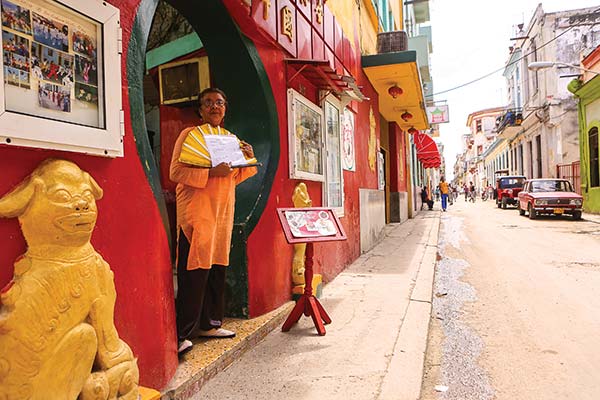
Barrio Chino, Centro Habana
Today, Barrio Chino is a mere shadow of its former self, with about 2,000 descendants still resident. Approximately a dozen social associations (casinos) attempt to keep Chinese culture alive. In 1995, the city fathers initiated Proyecto Integral Barrio Chino to revitalize the area and its culture. The Casa de Artes y Tradiciones Chinas (Salud #313, e/ Gervasio y Escobar, tel. 07/860-9976, barriochino@patrimonio.ohc.cu) features a small gallery and tai chi and dance classes. The Casa Abuelo Lung Kong Cun Sol (Dragones #364, e/ Manrique y San Nicolás, tel. 07/862-5388) exists to support elders in the Chinese community; on the third floor, the Templo San Fan Kong has an exquisitely carved gold-plated altar.
In 1995, the government of China funded a Pórtico Chino (Dragon Gate, or paifang) across Calle Dragones, between Amistad and Aguila, announcing visitors’ entry from the east. The highlight is pedestrian-only Callejón Cuchillo (Knife Alley), lined with Chinese restaurants and aglow at night with Chinese lanterns.
Two blocks to the southwest, the Iglesia Nuestra Señora de la Caridad del Cobre (Manrique #570, esq. Salud, tel. 07/861-0945), erected in 1802, features exquisite statuary, stained glass, and a gilded altar. A shrine to the Virgen del Cobre draws worshippers (both Catholics and believers in santería come to worship her avatar, Ochún), who bring sunflowers to adorn the shrine.
Soaring over Barrio Chino is the eclectic-style former headquarters of the Cuban Telephone Company, inaugurated in 1927 and at the time the tallest building in Havana. Today utilized by Etecsa, the Cuban state-owned telephone company, it hosts the impressive Museo de las Telecomunicaciones (tel. 07/860-7574, Mon.-Fri. 10am-4pm), telling the history of the telephone in Cuba and with a functional and interactive antique telephone exchange.
Avenida Simón Bolívar (formerly Avenida Reina) runs west from Parque de la Fraternidad. It is lined with once-impressive colonial-era structures gone to ruin. Beyond Avenida Padre Varela (Belascoain), the street broadens into a wide boulevard called Avenida Salvador Allende, laid out in the early 19th century (when it was known as Carlos III) by Governor Tacón.
The Gran Templo Nacional Masónico (Grand Masonic Temple, Av. Salvador Allende, e/ Padre Varela y Lucena) was established in 1951. Though no longer a Freemasons’ lodge, it retains a mural in the lobby depicting the history of Masonry in Cuba. Upstairs, reached by a marble staircase, the Museo Nacional Masónico (tel. 07/878-4795, www.granlogiacuba.org/museo, Mon.-Fri. 2pm-6pm) has eclectic exhibits—from ceremonial swords to an antique steam-powered fire engine, plus busts honoring great American Masons (including George Washington, Abraham Lincoln, and Simón Bolívar).
One of the few structures not seemingly on its last legs, the Iglesia del Sagrado Corazón de Jesús (Church of the Sacred Heart of Jesus, Simón Bolívar, e/ Padre Varela y Gervasio, tel. 07/862-4979, daily 8am-noon and 3pm-6pm) is a Gothic inspiration that could have been transported from medieval England. It was built in 1922 with a beamed ceiling held aloft by great marbled columns. Gargoyles and Christian allegories adorn the exterior.
South of Avenidas Simón Bolívar and Salvador Allende, the down-at-the-heels neighborhoods of southern Centro Habana extend to Cuatros Caminos, an all-important junction where the Mercado Agropecuario Cuatros Caminos (Four Roads Farmers Market) takes up an entire block between Máximo Gómez and Cristina (also called Avenida de la México), and Manglar Arroyo and Matadero. The dilapidated 19th-century market hall closed in 2015 for restoration.
On the east side of Cristina, facing the market, is the Museo de Ferrocarril (Railway Museum, tel. 07/879-4414, Tues.-Sat. 9:30am-5pm, Sun. 9:30am-1pm, entrance CUC2, camera CUC5), housed in the former Estación Cristina. The exhibits include model trains, bells, signals, and even telegraph equipment that tell the history of rail in Cuba. Sitting on rails in its lobby is an 1843 steam locomotive (Cuba’s first) called La Junta. Three other antique steam trains are displayed, along with various diesel locomotives.
The most rewarding cigar factory tour in Havana is offered at Fábrica de Tabaco H. Upmann (H. Upmann Tobacco Factory, Padre Varela #852, e/ Desagüe y Peñal Verno, tel. 07/878-1059 or 07/879-3927, 9am-1pm, CUC10), five blocks northwest of Cuatro Caminos. The factory was founded in 1875 by Inocencia Álvarez and later became the Romeo y Julieta factory, making the famous brand of that name. At press time, it had become the temporary home of the H. Upmann brand, whose name it now bears. The facade, however, is topped by a scroll with the original name: “Cuesta Rey & Co.”
To the rear is the old Fábrica El Rey del Mundo, decorated with Ionic columns. Today it operates as the temporary Fábrica de Tabaco Partagás (Luceña esq. Penalver, Centro Habana). A visit here is not as rewarding due to the cramped conditions. One block south is the Conservatorio Amaeo Roldán (Padre Varela, esq. Carmen), a music conservatory boasting a well-preserved classical facade.
South of Habana Vieja and Centro the land rises gently to Cerro, which developed during the 19th century as the place to retire for the torrid midsummer months. Many wealthy families maintained two homes in Havana—one in town, another on the cooler cerro (hill). The area is replete with once-stately quintas (summer homes) in neoclassical, beaux-arts, and art nouveau styles. Alas, the region is terribly deteriorated and the majority of buildings transcend sordid.
Cerro merges east into the less-crowded municipality of Diez de Octubre, a relatively leafy and attractive residential area laid out during the 20th century comprising the district of Santo Suárez and, to its east, Luyanó.
Avenida Máximo Gómez (popularly called Monte; the name changes to Calzada de Cerro west of Infanta) snakes southwest from Parque de la Fraternidad and south of Arroyo (Avenida Manglar), connecting Habana Vieja with Cerro. During the 19th century, scores of summer homes in classical style were erected. It has been described by writer Paul Goldberger as “one of the most remarkable streets in the world: three unbroken kilometers of 19th-century neoclassical villas, with colonnaded arcades making an urban vista of heartbreaking beauty.” The avenue ascends southward, marching backward into the past like a classical ruin, with once-stunning arcades and houses collapsing behind decaying facades.
One of the most splendid mansions is the palatial Quinta del Conde de Santovenia, erected in 1845 in subdued neoclassical style with a 1929 neo-Gothic chapel addition. Today housing the Hogar de Ancianos Santovenia (Calzada de Cerro #1424, e/ Patria y Auditor, tel. 07/879-6072, visits by appointment Tues., Thurs., and Sat. 4pm-5pm and Sun. 10am-noon), it has served as a home for the elderly (hogar de ancianos) for more than a century. It’s run by Spanish nuns.
Rising over the south of Cerro is Estadio Latinoamericano (Consejero Aranjo y Pedro Pérez, Cerro, tel. 07/870-6526), Havana’s main baseball stadium. To its northwest is Fábrica de Tabaco Corona (20 de Mayo #520, e/ Marta Abreu y Línea, Cerro, tel. 07/873-0131, Mon.-Fri. 9am-11am and 1pm-3pm, CUC10 guided tours), a modern cigar factory producing Hoyo de Monterey, Punch, and other labels.
Founded in 2001, this art-focused community project spans roughly four blocks along Calle Aguilera southeast of Porvenir. Fourteen core residents have cleaned up their once trash-strewn neighborhood and turned the metal garbage pieces into fanciful art, such as the Arco de Triunfo—an arch made of old wheel rims. Walls have been brightened with colorful murals, including an international wall with murals by non-Cuban painters.
The headquarters is El Tanque (Aguilera, esq. 9 de Abril, Luyanó), a converted water tank that now holds a performance art space and art gallery. On weekends, it hosts free art workshops for adults and kids, plus a children’s street party every month. A highlight is Obelisko Amistad (Friendship Obelisk), with plaques representing differing countries; visitors are invited to circle the column and ask for peace for the world.
About 1.5 km southwest, off Avenida Porvenir, is Museo Casa Natal Camilo Cienfuegos (Calle Pocito #228, esq. Lawton, tel. 07/698-3509, Tues.-Sat. 9:30am-3:30pm, Sun. 9:30am-noon, free), occupying a small house built in eclectic style in 1920 and where on February 6, 1932, was born Camilo Cienfuegos Gorriarán, who rose to be Fidel’s chief of staff before dying in a mysterious plane crash in 1959. Furnished with original pieces, it has five rooms dedicated to his life as a child and, later, revolutionary commander.
The municipio of Plaza de la Revolución (pop. 165,000), west of Centro Habana, comprises the leafy residential streets of Vedado and, to the southwest, the modern enclave of Nuevo Vedado and Plaza de la Revolución.
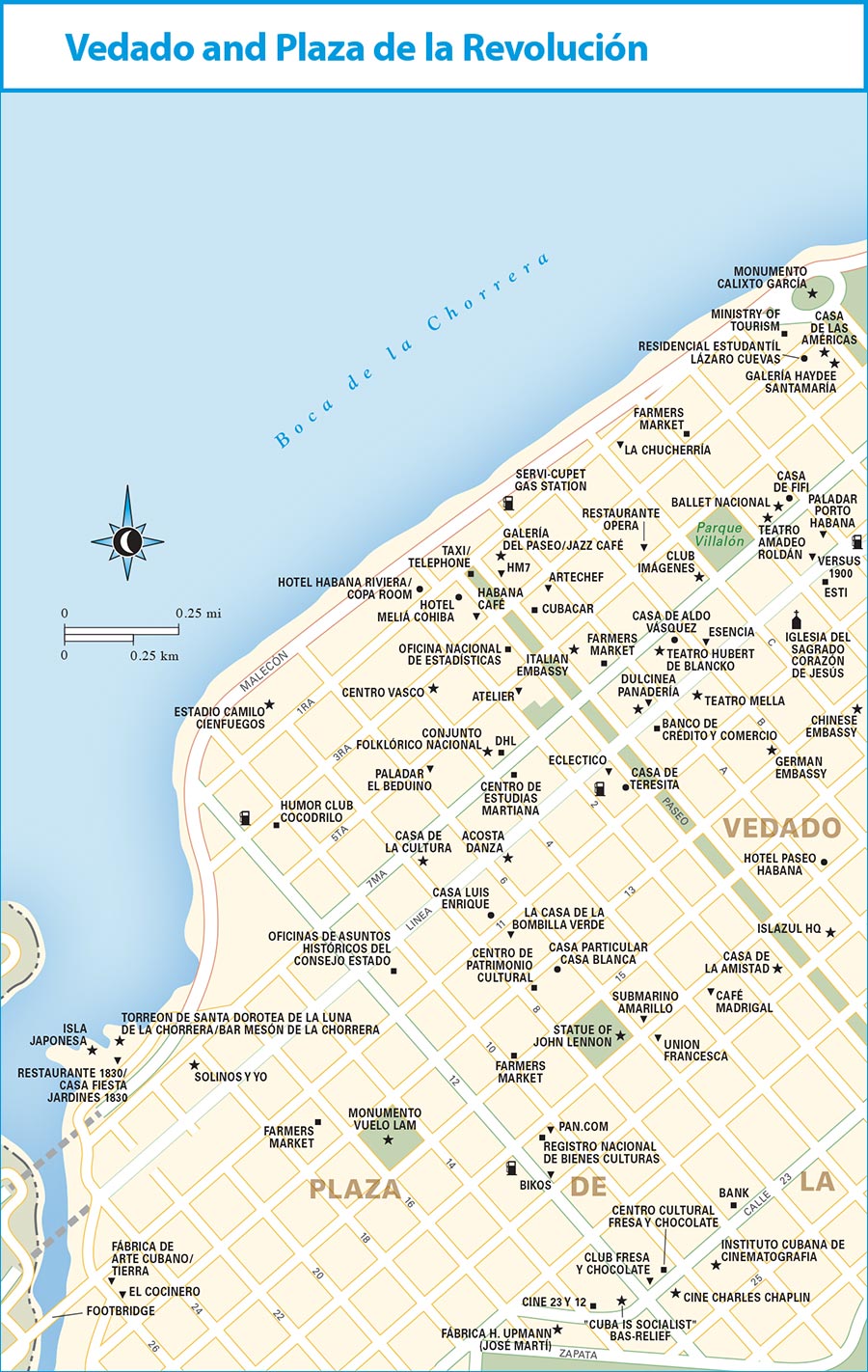
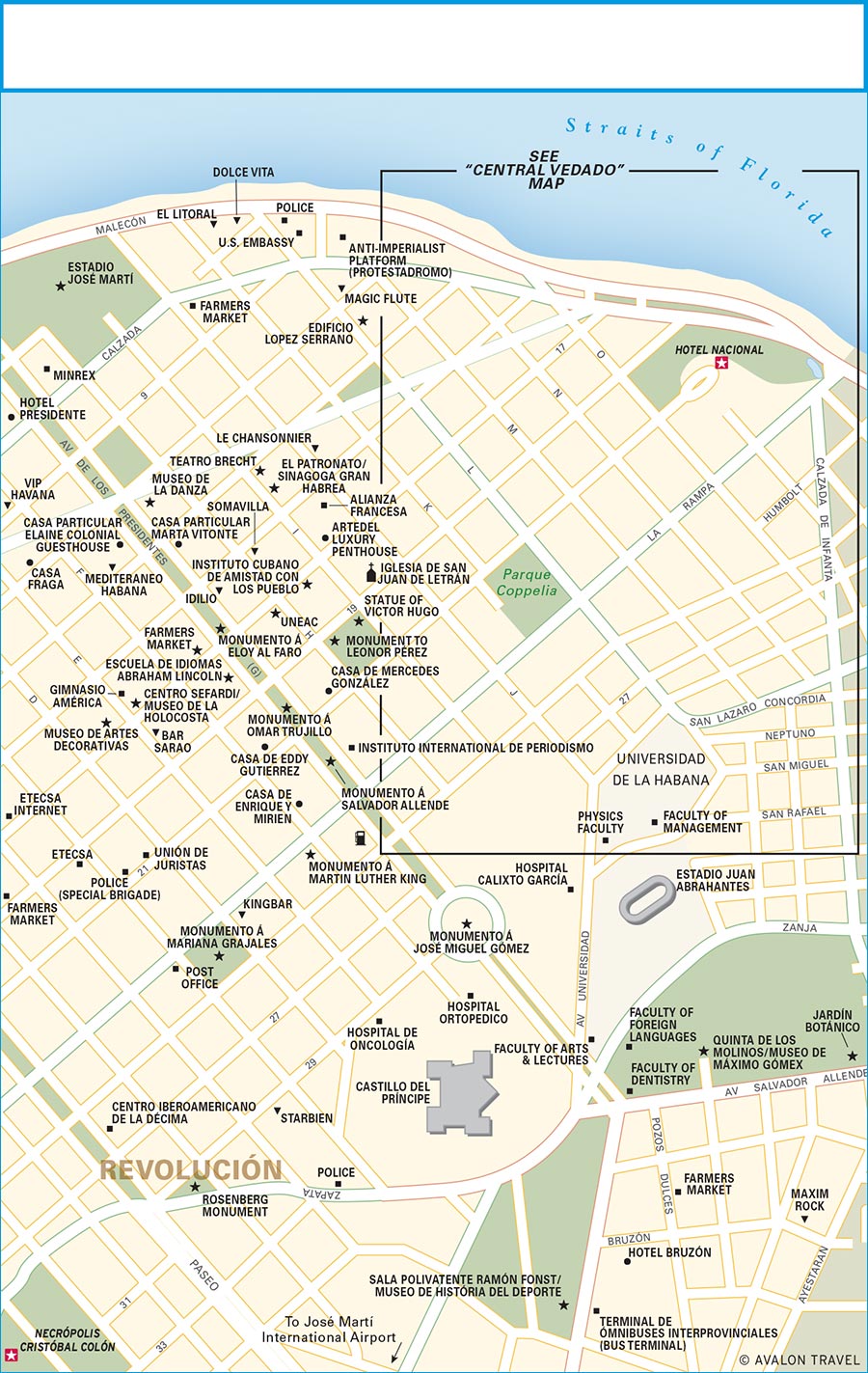
Vedado—the commercial heart of “modern” Havana—has been described as “Havana at its middle-class best.” The University of Havana is here. So are many of the city’s prime hotels and restaurants, virtually all its main commercial buildings, and block after block of handsome mansions and apartment houses in art deco, eclectic, beaux-arts, and neoclassical styles—luxurious and humble alike lining streets shaded by stately jagüeys dropping their aerial roots to the ground.
Formerly a vast open space between Centro Habana and the Río Almendares, Vedado (which means “forbidden”) served as a buffer zone in case of attack from the west; construction was prohibited. In 1859, however, plans were drawn up for urban expansion. Strict building regulations called for 15 feet of gardens between building and street, and more in wider avenidas. Regularly spaced parks were mandated. The conclusion of the Spanish-Cuban-American War in 1898 brought U.S. money rushing in. Civic structures, hotels, casinos, department stores, and restaurants sprouted alongside nightclubs.
The sprawling region is hemmed to the north by the Malecón, to the east by Calzada de Infanta, to the west by the Río Almendares, and to the southeast by the Calzada de Ayestaran and Avenida de la Independencia. Vedado follows a grid pattern laid out in quadrants. Odd-numbered streets (calles) run east-west, parallel to the shore. Even-numbered calles run perpendicular. (To confuse things, west of Paseo, calles are even-numbered; east of Paseo, calles run from A to P.) The basic grid is overlaid by a larger grid of broad boulevards (avenidas) an average of six blocks apart: Calle L to the east, and Avenida de los Presidentes, Paseo, and Avenida 12 farther west.
Dividing the quadrants east-west is Calle 23, which rises (colloquially) as La Rampa from the Malecón at its junction with Calzada de Infanta. La Rampa runs uphill to Calle L and continues on the flat as Calle 23. Paralleling it to the north is a second major east-west thoroughfare, Línea (Calle 9), five blocks inland of the Malecón, which it meets to the northeast.
Vedado slopes gently upward from the shore to Calle 23 and then gently downward toward Plaza de la Revolución.
Extending west from Centro Havana, the Malecón runs along the bulging, wave-battered shorefront of northern Vedado, curling from La Rampa in the east to the Río Almendares in the west, a distance of three miles. The sidewalk is pitted underfoot, but a stroll makes for good exercise while taking in such sights as the Monumento Calixto García (Malecón y Av. de los Presidentes), featuring a bronze figure of the 19th-century rebel general on horseback; the Hotel Habana Riviera (Malecón y Paseo), opened by the Mafia in 1958 and recently remodeled to show off its spectacular modernist lobby; and the Torreón de Santa Dorotea de la Luna de la Chorrera (Malecón y Calle 20), a small fortress built in 1762 to guard the mouth of the Río Almendares. Immediately beyond “La Chorrera,” the Restaurante 1830 features a Gaudí-esque garden that includes a dramatic cupola and a tiny island in Japanese style.
The landmark Hotel Nacional (Calles O y 21, tel. 07/836-3564) is dramatically perched atop a cliff at the junction of La Rampa and the Malecón. Now a national monument, this grande dame hotel was designed by the same architects who designed The Breakers in Palm Beach, which it closely resembles. It opened on December 30, 1930, in the midst of the Great Depression. In 1933, army officers loyal to Machado holed up here following Batista’s coup; a gun battle ensued. More famously, in December 1946 Lucky Luciano called a mobster summit to discuss carving up Havana.
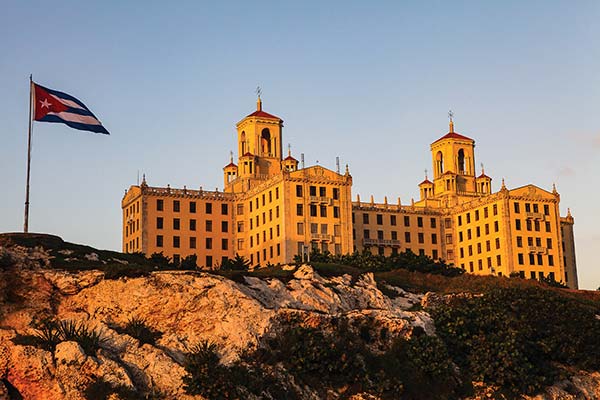
Hotel Nacional, Vedado
The Spanish Renaissance-style hotel was greatly in need of refurbishment when, in 1955, mobster Meyer Lansky persuaded General Batista to let him build a grand casino. Luminaries from Winston Churchill and the Prince of Wales to Marlon Brando have laid their heads here, as attested by the photos in the bar. It is still the preferred hotel for visiting bigwigs.
Beyond the Palladian porch, the vestibule is lavishly adorned with Mudejar patterned tiles. The sweeping palm-shaded lawns to the rear slope toward the Malecón, above which sits a battery of cannons from the independence wars. The cliff is riddled with defensive tunnels built since the 1970s.
The modernist Hotel Capri (Calles 21 y N), one block west of the Hotel Nacional, was built in 1958 by the American gangster Santo Trafficante. It was a setting in the movies The Godfather and Soy Cuba.
The Monumento a las Víctimas del Maine (Maine Monument, Malecón y Calle 17) was dedicated by the republican Cuban government to the memory of the 260 sailors who died when the USS Maine exploded in Havana harbor in 1898, creating a prelude for U.S. intervention in the War of Independence. Two rusting cannons tethered by chains from the ship’s anchor are laid out beneath 12-meter-tall Corinthian columns that were originally topped by an eagle with wings spread wide. Immediately after the failed Bay of Pigs invasion in 1961, a mob toppled the eagle; its body is now in the Museo de la Ciudad de la Habana, while the head hangs in the U.S. Embassy (the ambassador’s residence in Siboney displays an original eagle, felled from the monument by a hurricane in 1925). The Castro government later dedicated a plaque that reads, “To the victims of the Maine, who were sacrificed by imperialist voracity in its eagerness to seize the island of Cuba.”
The Plaza de la Dignidad (Plaza of Dignity, Malecón y Calzada), west of the Maine Monument, was created at the height of the Elián González fiasco in 1999-2000 from what was a grassy knoll in front of the U.S. Embassy. A statue of José Martí stands at the plaza’s eastern end, bearing in one arm a bronze likeness of young Elián while with the other he points an accusatory finger at the embassy—habaneros joke that Martí is trying to tell them, “Your visas are that way!”
The Cuban government also built the Tribuna Abierta Anti-Imperialista (José Martí Anti-Imperialist Platform)—called jokingly by locals the “protestadromo”—at the west end of the plaza to accommodate the masses bused in to taunt Uncle Sam. The concrete supports bear plaques inscribed with the names of Communist and revolutionary heroes, plus those of prominent North Americans, from Benjamin Spock to Malcolm X, at the fore of the fight for social justice.
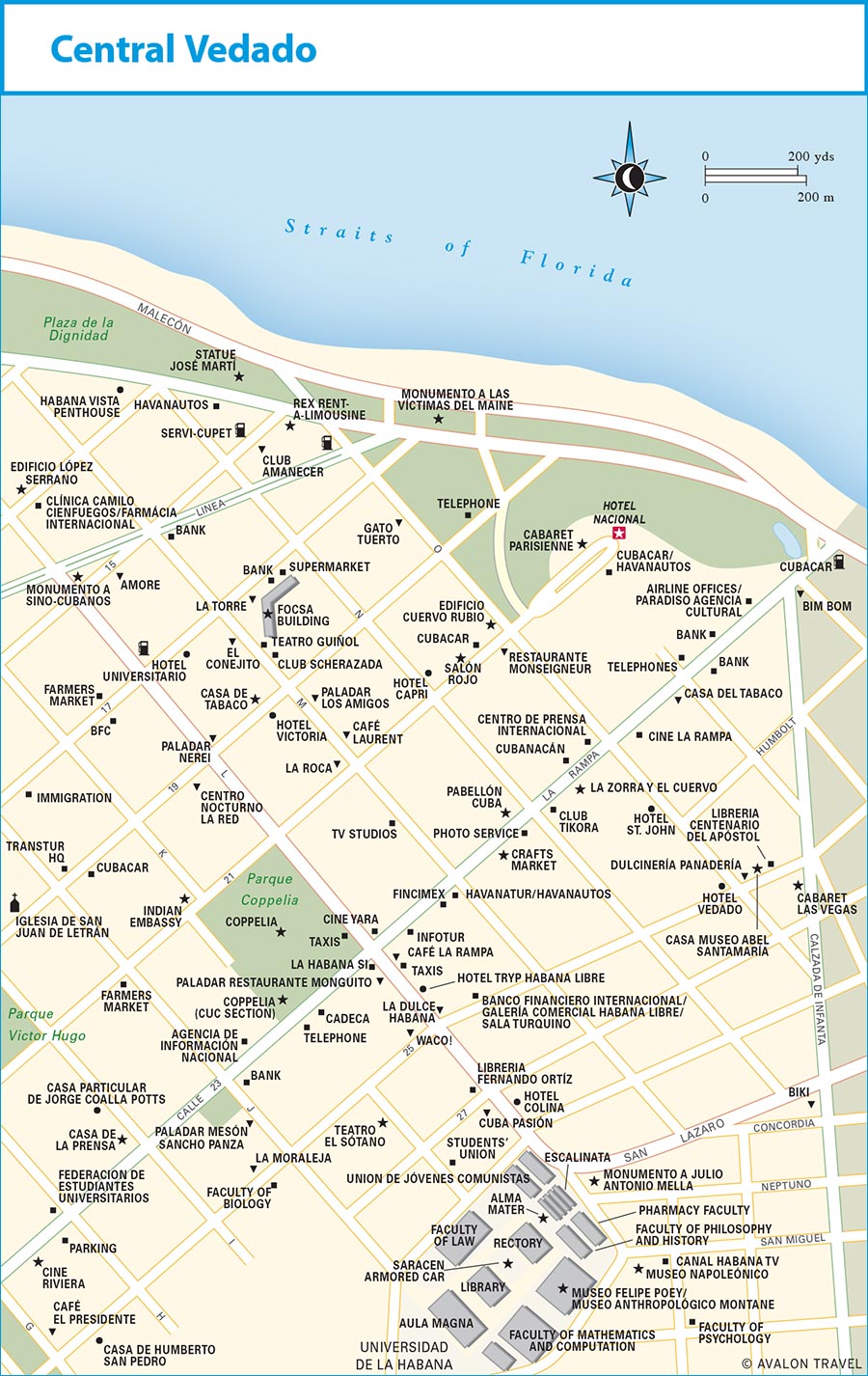
At the western end of the plaza is the U.S. Embassy (formerly the U.S. Interests Section), where U.S. diplomats and CIA agents serve Uncle Sam’s whims behind a veil of mirrored-glass windows. A forest of 138 huge flagstaffs, El Monte de los Banderas, was erected by Cuba in front of the building in 2007. Each black flag represents a year since the launch of the Ten Years War in 1868.
Calle 23 rises from the Malecón to Calle L and climbs steadily past high-rise office buildings, nightclubs, cinemas, travel agencies, TV studios, and art deco apartment buildings. La Rampa (the Ramp) was the setting of Three Trapped Tigers, Guillermo Cabrera Infante’s famous novel about swinging 1950s Havana; it was here that the ritziest hotels, casinos, and nightclubs were concentrated in the days before the Revolution. Multicolored granite tiles created by Wilfredo Lam and René Portocarrero are laid in the sidewalks.
At the top of La Rampa is Parque Coppelia (Calle 23 y L, Tues.-Sun. 10am-9:30pm), the name of a park in Havana, of the flying saucer-like structure at its heart, and of the brand of excellent ice cream served here. In 1966, the government built this lush park with a parlor in the middle as the biggest ice creamery in the world, serving up to an estimated 30,000 customers a day. Cuba’s rich diversity can be observed standing in line at Coppelia on a sultry Havana afternoon.
The strange concrete structure, suspended on spidery legs and looming over the park, features circular rooms overhead like a four-leaf clover, offering views over open-air sections where helado (ice cream) is enjoyed beneath the dappled shade of lush jagüey trees. Each section has its own cola (line), proportional in length to the strength of the sun. Foreigners are usually sent to a section where you pay CUC1 per scoop, but the fun is standing in line with Cubans (you’ll need moneda nacional).
The 416-foot-tall Hotel Habana Libre (Free Havana Hotel, Calle L, e/ 23 y 25, tel. 07/834-6100) was the place to be after opening as the Havana Hilton in April 1958. Castro even had his headquarters here briefly in 1959. The modernist hotel is fronted by a massive mural—Frutas Cubanas—by ceramist Amelia Peláez, made of 6.7 million pieces in the style of Picasso. The mezzanine contains a mosaic mural, Carro de la Revolución (the Revolutionary Car) by Alfredo Sosabravo.
Of interest to students of Cuba’s revolutionary history, this museum (Calle 25 #164, e/ Infanta y O, tel. 07/835-0891, Mon.-Sat. 9am-4pm, free) occupies a simple two-room, sixth-floor apartment (#603) where Fidel Castro’s revolutionary movement, the M-26-7, had its secret headquarters in the former home of the eponymous martyr, brutally tortured and murdered following the attack on the Moncada barracks in 1953. Original furnishings include Fidel’s work desk.
The Universidad de la Habana (University of Havana, Calle L y San Lázaro, tel. 07/878-3231, www.uh.cu, Mon.-Fri. 8am-6pm) was founded by Dominican friars in 1728 and was originally situated on Calle Obispo in Habana Vieja. The current edifices were built 1905-1911, when the school was inaugurated in its current location. During the 20th century the university was an autonomous “sacred hill” that neither the police nor the army could enter. The campus is off-limits on weekends and is closed July-August.
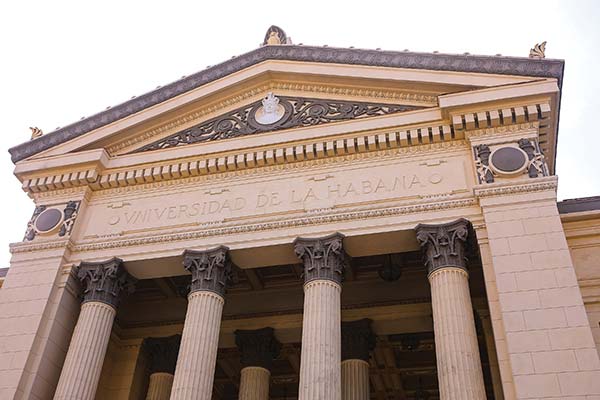
Universidad de la Habana, Vedado
From Calle L, the university is entered via an immense, 50-meter-wide stone staircase: the 88-step Escalinata (staircase). A patinated bronze statue of the Alma Mater cast by Czech sculptor Mario Korbel in 1919 sits atop the staircase. The twice-life-size statue portrays a woman seated in a bronze chair with six classical bas-reliefs representing disciplines taught at the university. She is dressed in a tunic and extends her bare arms, beckoning all who desire knowledge.
The staircase is topped by a columned portico, beyond which lies the peaceful Plaza Ignacio Agramonte, surrounded by classical buildings. A Saracen armored car in the quadrant was captured in 1958 by students in the fight against Batista. The Aula Magna (Great Hall) features magnificent murals by Armando Menocal, plus the marble tomb of independence leader Félix Varela (1788-1853).
The Monumento a Julio Antonio Mella, across Calle L at the base of the Escalinata, contains the ashes of Mella, founder of the University Students’ Federation and, later, of the Cuban Communist Party.
The Escuela de Ciencias (School of Sciences), on the south side of the quadrant, contains the Museo de Ciencias Naturales Felipe Poey (Felipe Poey Museum of Natural Sciences, tel. 07/877-4221, Mon.-Fri. 9am-noon and 1pm-4pm, free), displaying endemic species from alligators to sharks, stuffed or pickled for posterity. The museum dates from 1842 and is named for its French-Cuban founder. Poey (1799-1891) was versed in every field of the sciences and founded the Academy of Medical Sciences, the Anthropological Society of Cuba, and a half-dozen other societies. The Museo Anthropológico Montane (Montane Anthropology Museum, tel. 07/879-3488, http://fbio.uh.cu/mmontane.php, Mon.-Fri. 9am-noon and 1pm-4pm, free), on the second floor, displays pre-Columbian artifacts.
Who would imagine that so much of Napoleon Bonaparte’s personal memorabilia would end up in Cuba? But it has, housed in the Museo Napoleónico (Napoleonic Museum, San Miguel #1159, e/ Ronda y Masón, tel. 07/879-1412, mnapoleonico@patrimonio.ohc.cu, Tues.-Sat. 9:30am-5pm, Sun. 9:30am-12:30pm, entrance CUC3, cameras CUC5, guide CUC2) in a three-story Florentine Renaissance mansion on the south side of the university. The collection (7,000 pieces) was the private work of Orestes Ferrara, one-time Cuban ambassador to France. Ferrara brought back from Europe such precious items as the French emperor’s death mask, his watch, toothbrush, and the pistols Napoleon used at the Battle of Borodino. Other items were seized from Julio Lobo, the former National Bank president, when he left Cuba for exile. The museum, housed in Ferrara’s former home (Ferrara was also forced out by the Revolution), is replete with busts and portraits of the military genius, plus armaments and uniforms.
This street stretches west from the Monumento a las Víctimas del Maine and is lined with remarkable buildings, beginning with the landmark 35-story Focsa (Calle 17 e/ M y N), a V-shaped apartment block built 1954-1956 as one of the largest reinforced concrete structures in the world. The Instituto Cubano de Amistad con los Pueblos (Cuban Institute for People’s Friendship, Calle 17 #301, e/ H y I) occupies a palatial beaux-arts villa. One block west, the equally magnificent Casa de Juan Gelats is another spectacular exemplar of beaux-arts style; built in 1920 it houses the Unión Nacional de Escritores y Artistas de Cuba (National Union of Cuban Writers and Artists, UNEAC, Calle 17 #351, esq. H, tel. 07/832-4551, www.uneac.org.cu).
West of Avenida de los Presidentes, the Centro Hebreo Sefaradi (Calle 17 #462, esq. E, tel. 07/832-6623) hosts a small Holocaust museum that is limited to visual displays. The Museo de Artes Decorativas (Museum of Decorative Arts, Calle 17 #502, e/ D y E, tel. 07/861-0241 or 07/832-0924, Tues.-Sat. 9:30am-5pm and Sun. 10am-2pm, CUC5 with guide, cameras CUC5, videos CUC10), housed in the former mansion of a Cuban countess, brims with lavish furniture, paintings, textiles, and chinoiserie from the 18th and 19th centuries.

Beaux Arts Museo de Artes Decorativas, Vedado
Beyond Paseo, on the west side, to the left, is the Casa de la Amistad (Paseo #406, e/ 17 y 19, tel. 07/830-3114), an Italian Renaissance mansion built in 1926 with a surfeit of Carrara marble, silver-laminated banisters, decorative Lalique glass, and Baccarat crystal.
Two blocks west, Calle 17 opens onto Parque Lennon (Calle 6), where in 2000, on the 20th anniversary of John Lennon’s death, a life-size bronze statue was unveiled in the presence of Fidel (who had previously banned Beatles music). Lennon sits on a cast-iron bench, with plenty of room for anyone who wants to join him. The sculpture is by Cuban artist José Villa, who inscribed the words “People say I’m a dreamer, but I’m not the only one,” at Lennon’s feet. A custodio is there 24/7; he takes care of Lennon’s spectacles.
Stroll two blocks north and one block west to reach Calle 11 (bet. 10 and 12), where revolutionary heroine Celia Sánchez once lived. Fidel had an apartment here until his death, and the area was off-limits until 2017. MININT security still patrol the street, where the Oficinas de Asuntos Históricos del Consejo del Estado (Linea e/ 10 y 12, c/o tel. 07/832-9149) is located. It houses the official archives of the Cuban Revolution and boasts an astonishing art collection, but is closed to public view.
Avenida de los Presidentes (Calle G) runs perpendicular to Calle 23 and climbs from the Malecón toward Plaza de la Revolución. The avenue is named for the statues of Cuban and Latin American presidents that grace its length.
The Monumento Calixto García studs the Malecón. One block south, on your right, the Casa de las Américas (Presidentes, esq. 3ra, tel. 07/832-2706, www.casa.cult.cu, Mon.-Fri. 8am-4:45pm), formed in 1959 to study and promote the cultures of Latin America and the Caribbean, is housed in a cathedral-like art deco building. Fifty meters south is the Casa’s Galería Haydee Santamaría (e/ 5ta and G).
The Museo de la Danza (Calle Línea #365, esq. Presidentes, tel. 07/831-2198, musdanza@cubarte.cult.cu, Tues.-Sat. 10am-5pm, CUC2, guide CUC1) occupies a restored mansion and has salons dedicated to Russian ballet, modern dance, and the Ballet Nacional de Cuba. Divert one block west along Linea to visit Galería Habana (Línea 460 e/ E y F, tel. 07/832-7101, www.galerihabana.com, Mon.-Fri. 10am-4pm, Sat. 10am-1pm, free), a superb art gallery showing works by leading contemporary and yesteryear maestros.
Ascending the avenue, you’ll pass statues to Ecuadorian president Eloy Alfaro (e/ 15 y 17; note the wall mural called Wrinkles, for self-evident reasons, on the southwest corner), Mexican president Benito Juárez (e/ 17 y 19), Venezuelan Simón Bolívar (e/ 19 y 21), Panamanian strongman president Omar Torrijos (e/ 19 y 21), and Chilean president Salvador Allende (e/ 21 y 23).
The tree-shaded boulevard climbs two blocks to the Monumento a José Miguel Gómez (Calle 29), designed by Italian sculptor Giovanni Nicolini and erected in 1936 in classical style to honor the vainglorious republican president (1909-1913). Beyond, the road drops through a canyon to the junction with Avenida Salvador Allende.
To the west, on the north side of the road, the once-graceful Quinta de los Molinos (e/ Infanta y Luaces, tel. 07/879-8850) was closed for restoration at last visit. Built between 1837 and 1840, it was a summer palace for the captains-general. In 1899, it was granted as the private residence of General Máximo Gómez, the Dominican-born commander in chief of the liberation army. The molino (mill) refers to a tobacco mill that operated 1800-1835, powered by the waters of the Zanja Real. The quinta’s 4.8-hectare grounds form the Jardín Botánico (Botanical Gardens, Tues.-Sun. 7am-7pm, free), featuring a mariposario (butterfly garden). Guided walks are offered.
The Necrópolis Cristóbal Colón (Columbus Cemetery, Zapata, esq. 12, tel. 07/830-4517, daily 8am-5pm, entrance CUC5 includes guide and right to photograph) covers 56 hectares and contains more than 500 major mausoleums, chapels, vaults, tombs, and galleries (in addition to countless gravestones) embellished with angels, griffins, cherubs, and other flamboyant ornamentation. You’ll even find Greco-Roman temples in miniature, an Egyptian pyramid, and medieval castles, plus baroque, Romantic, Renaissance, art deco, and art nouveau monuments. The triple-arched entrance gate has marble reliefs depicting the crucifixion and Lazarus rising from the grave and is topped by a marble coronation stone representing the theological virtues of faith, hope, and charity.
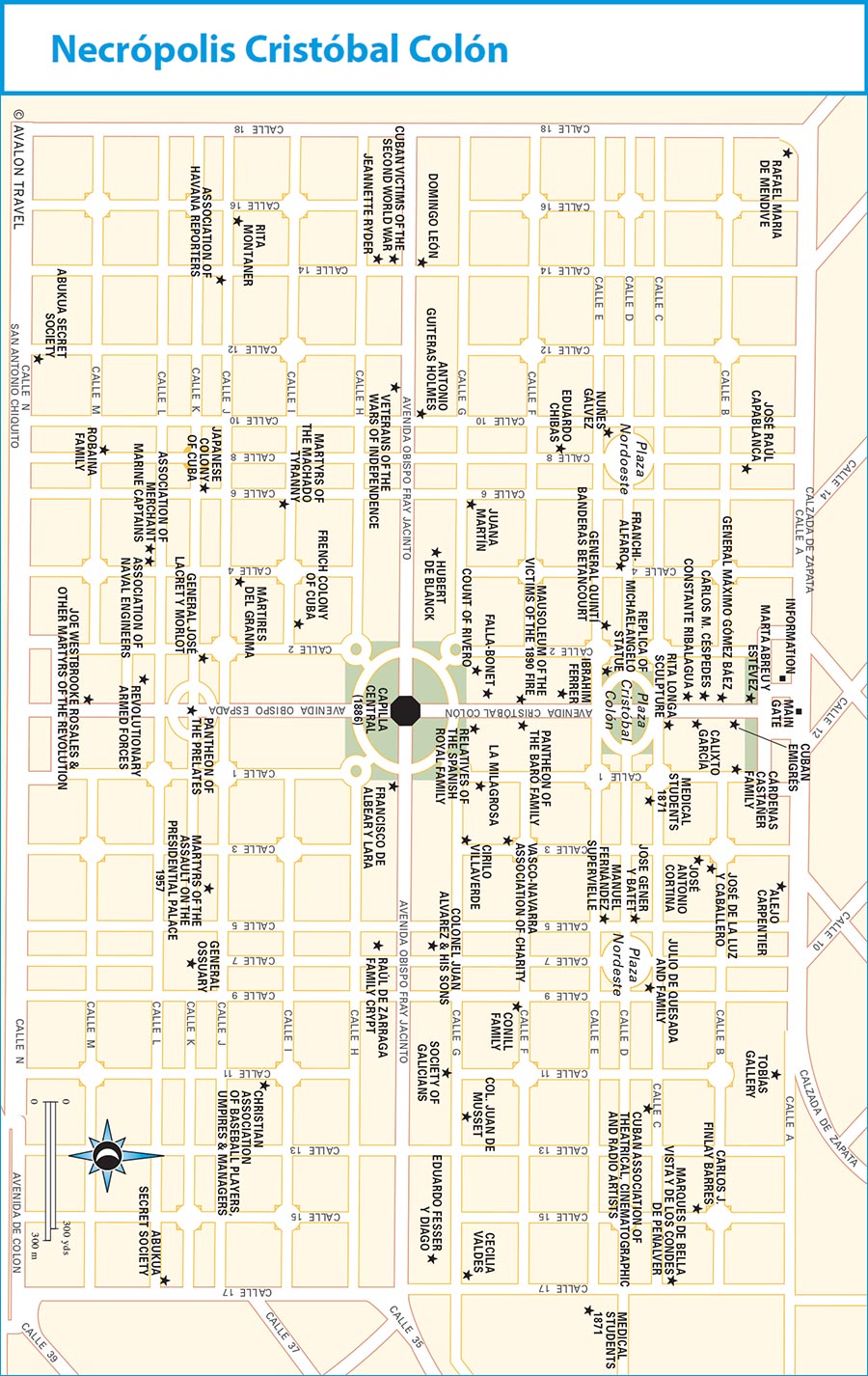
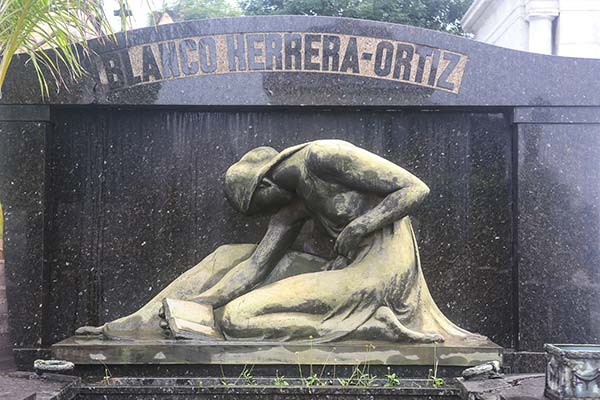
Necrópolis Cristóbal Colón
Today a national monument, the cemetery was laid out between 1871 and 1886 in 16 rectangular blocks, like a Roman military camp, divided by social status. Nobles competed to build the most elaborate tombs, with social standing dictating the size and location of plots.
Famous criollo patricians, colonial aristocrats, and war heroes such as Máximo Gómez are buried here alongside noted intellectuals and politicians. The list goes on and on: José Raúl Capablanca, the world chess champion 1921-1927 (his tomb is guarded by a marble queen chess piece); Alejo Carpentier, Cuba’s most revered contemporary novelist; Celia Sánchez, Haydee Santamaría, and a plethora of other revolutionaries killed for the cause; and even some of the Revolution’s enemies. The Galería Tobias is one of several massive underground ossuaries.
The major tombs line Avenida Cristóbal Colón, the main avenue, which leads south from the gate to an ocher-colored, octagonal neo-Byzantine church, the Capilla Central, containing a fresco of the Last Judgment.
The most visited grave is the flower-bedecked tomb of Amelia Goyri de Hoz, revered as La Milagrosa (The Miraculous One, Calles 3 y F) and to whom the superstitious ascribe miraculous healings. According to legend, she died during childbirth in 1901 and was buried with her stillborn child at her feet. When her sarcophagus was later opened, the baby was supposedly cradled in her arms. Ever since, believers have paid homage by knocking three times on the tombstone with one of its brass rings, before touching the tomb and requesting a favor (one must not turn one’s back on the tomb when departing). Many childless women pray here in hopes of a pregnancy.
The Chinese built their own cemetery immediately southwest of Cementerio Colón, on the west side of Avenida 26 (e/ 28 y 33, tel. 07/831-1645, daily 8am-4pm, free). Beyond the circular gateway, traditional lions stand guard over burial chapels with upward-curving roofs.
The northwest corner of Calles 23 and 12, one block north of Cementerio Colón, marks the spot where, on April 16, 1961 (the eve of the Bay of Pigs invasion), Castro announced that Cuba was henceforth socialist. The anniversary of the declaration of socialism is marked each April 16. A bronze bas-relief shows Fidel surrounded by soldiers, rifles held aloft. It honors citizens killed in the U.S.-sponsored strike on the airfield at Marianao that was a prelude to the invasion, repeating his words: “This is the socialist and democratic revolution of the humble, with the humble, for the humble.” At last visit, the building (and memorial) were boarded up as unsafe.
Havana’s largest plaza, Plaza de la Revolución (Revolution Plaza), which occupies the Loma de los Catalanes (Hill of the Catalans), is an ugly tarred square. The trapezoidal complex spanning 11 acres was laid out during the Batista era, when it was known as the Plaza Cívica. It forms the administrative center for Cuba. All the major edifices date to the 1950s. Huge rallies are held here on May 1.
Among the important buildings are the monumentalist Biblioteca Nacional (National Library, tel. 07/855-5542, Mon. 8:15am-1pm, Tues.-Fri. 8:15am-6:30pm, Sat. 8am-4:30pm, guided tours offered), Cuba’s largest library, built 1955-1957; the 21-story Ministerio de Defensa, originally built as the municipal seat of government on the plaza’s southeast side; and the Teatro Nacional (National Theater, Paseo y Av. Carlos M. de Céspedes, tel. 07/878-5590, www.teatronacional.cu), one block to the northwest of the plaza, built 1954-1960 with a convex glazed facade. Paseo climbs northwest from the plaza to Zapata, where in the middle of the road rises the Memorial a Ethel y Julius Rosenberg, bearing cement doves and an inset sculpture of the U.S. couple executed in 1953 for passing nuclear secrets to the Soviet Union. An inscription reads, “Assassinated June 19, 1953.” The Cuban government holds a memorial service here each June 19.
The massive Memorial José Martí on the south side of the square sits atop a 30-meter-tall base that is shaped as a five-pointed star. It is made entirely of gray granite and marble and was designed by Enrique Luis Varela and completed in 1958. To each side, arching stairways lead to an 18-meter-tall (59-foot) gray-white marble statue of Martí sitting in a contemplative pose, like Rodin’s The Thinker.
Behind looms a 109-meter-tall marble edifice stepped like a soaring ziggurat from a sci-fi movie. It’s the highest point in Havana. The edifice houses the Museo José Martí (tel. 07/859-2347, Mon.-Sat. 9am-4:30pm, entrance CUC3, cameras CUC5, videos CUC10), dedicated to Martí’s life, with maps, texts, paintings, and a multiscreen broadcast on independence and the Revolution. An elevator whisks you to the top of the tower for a 360-degree view over Havana (CUC2).
The center of government is the Palacio de la Revolución (Palace of the Revolution), immediately south of the José Martí monument. This imposing structure was inspired by the architecture then popular in Fascist Europe and was built 1954-1957 as the Palace of Justice. Today, it is where Raúl Castro and the Council of Ministers work out the policies of state. The labyrinthine, ocher-colored palace with gleaming black stone walls and checkered floors adjoins the buildings of the Central Committee of the Communist Party. Before the Revolution, the buildings served as the Cuban Supreme Court and national police headquarters. No visitors are allowed.
Commanding the northwest side of the plaza is the seven-story Ministerio del Interior (Ministry of the Interior, MININT, in charge of national security), built in 1953 to be the Office of the Comptroller. On its east side is a windowless horizontal block that bears a soaring “mural" of Che Guevara and the words Hasta la victoria siempre (“Always toward victory”), erected in 1995 from steel railings donated by the French government. See it by day and by night, when it is illuminated.
In October 2009, a visage of Comandante Camilo Cienfuegos (identical in style to that of Che) was erected on the facade of the Ministerio de Comunicaciones (Ministry of Communications), on the plaza’s northeast corner. The 100-ton steel mural was raised for the 50th anniversary of Cienfuegos’s death and is accompanied by the words Vas bien, Fidel (“You’re doing fine, Fidel”). Cienfuegos’s famous response was in reply to Fidel’s question “Am I doing all right, Camilo?” at a rally on January 8, 1959. The ground-floor Museo Postal Cubano (Cuban Post Museum, Av. Rancho Boyeros, esq. 19 de Mayo, tel. 07/882-8255, Mon.-Fri. 8am-4pm, entrance CUC1) has a well-catalogued philatelic collection, including a complete range of Cuban postage stamps dating from 1855, plus stamps from almost 100 other countries.
Nuevo Vedado, which stretches southwest of Plaza de la Revolución, is a sprawling complex of mid-20th-century housing, including postrevolutionary high-rise apartment blocks. The most magnificent and prominent building is undoutedbly the Coliseo de la Ciudad Deportiva (Sports Coliseum, colloquially called “El Coliseo”), a giant Olympic stadium with a massive concrete dome. It was built in 1957 at Avenida 26, Avenida de la Independencia (Rancho Boyeros), and Vía Blanca.
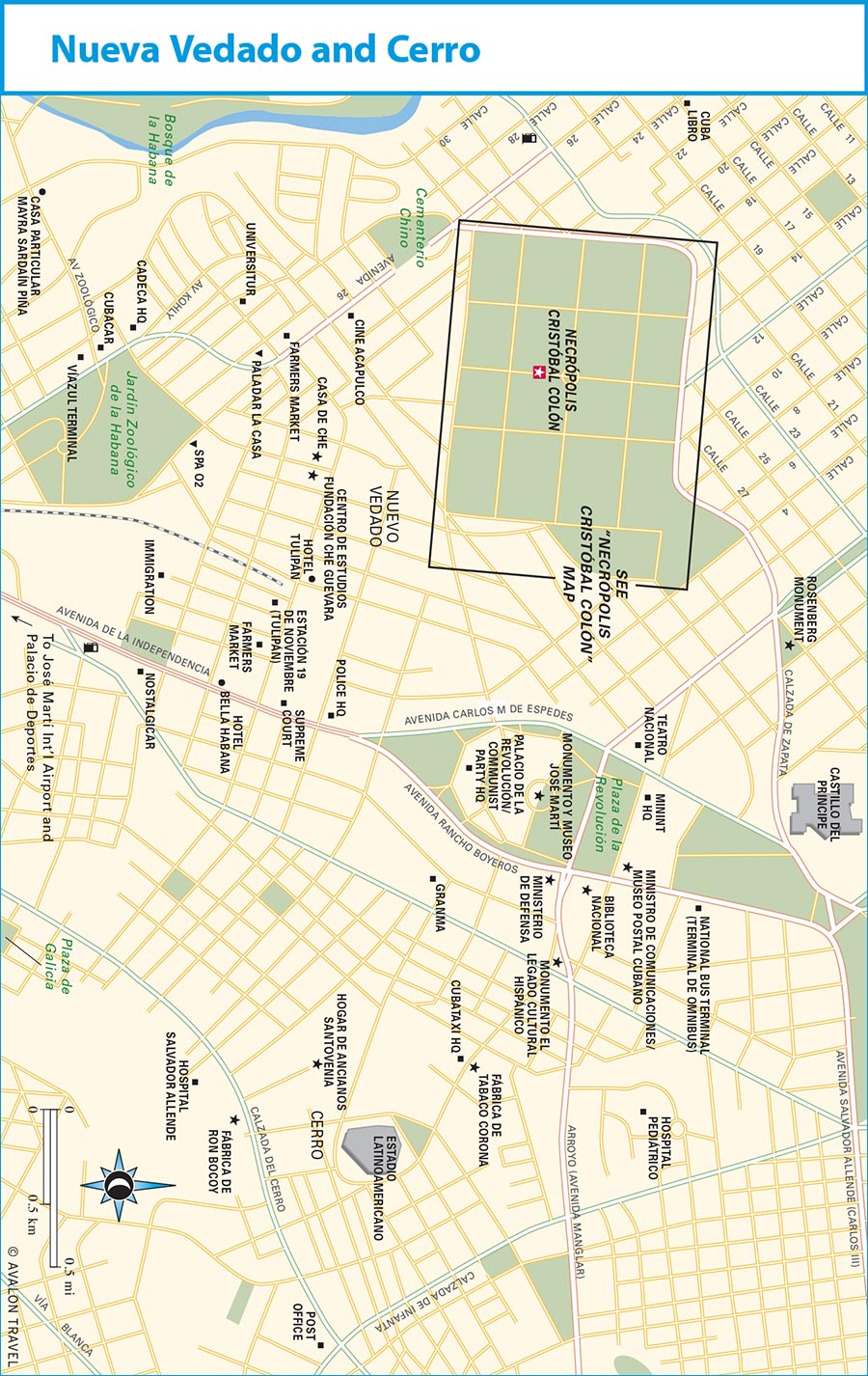
Note: Those with children in tow might be tempted to visit the poorly managed Jardín Zoológico de la Habana (Havana Zoological Garden, Av. 26 y Zoológico, tel. 07/881-8915, zoohabana@ch.gov.cu, Wed.-Sun. 9:30am-5pm, CUC2), but this depressing zoo is best avoided.
Opened in 2014, the Center for Che Guevara Studies (Calle 47 #772 e/ Conill y Tulipán, tel. 07/814-1013, www.centroche.co.cu) is housed in a handsome contemporary building opposite Che’s gorgeous former modernist home (Calle 47 #770), where he lived 1962-1964 and which now houses offices for the center. It has separate salas dedicated to Che, Camilo Cienfuegos, and Haydee Santamaría, plus a library, auditorium, and expositions on Che’s life.
Follow Avenida Zoológica west to the bridge over the Río Almendares to enter the Bosque de la Habana (Havana Forest). This ribbon of wild, vine-draped woodland stretches alongside the river. There is no path—you must walk along Calle 49C, which parallels the river. Going alone is not advised; robberies have occurred.
North of Bosque de la Habana, and accessed from Avenida 47, the motley riverside Parque Metropolitano de la Habana has pony rides, rowboats, mini-golf, and a children’s playground. To the south, the woods extend to Los Jardines de la Tropical (Calle Rizo, Tues.-Sun. 9am-6pm), a landscaped park built 1904-1910 on the grounds of a former brewery. The park found its inspiration in Antoni Gaudí’s Parque Güell in Barcelona. Today it is near-derelict and looks like an abandoned set from Lord of the Rings.
West of Vedado and the Río Almendares, the municipio of Playa extends to the western boundary of Havana as far as the Río Quibu. Most areas were renamed following the Revolution. Gone are Country Club and Biltmore, replaced with politically acceptable names such as Atabey, Cubanacán, and Siboney, in honor of Cuba’s indigenous past.
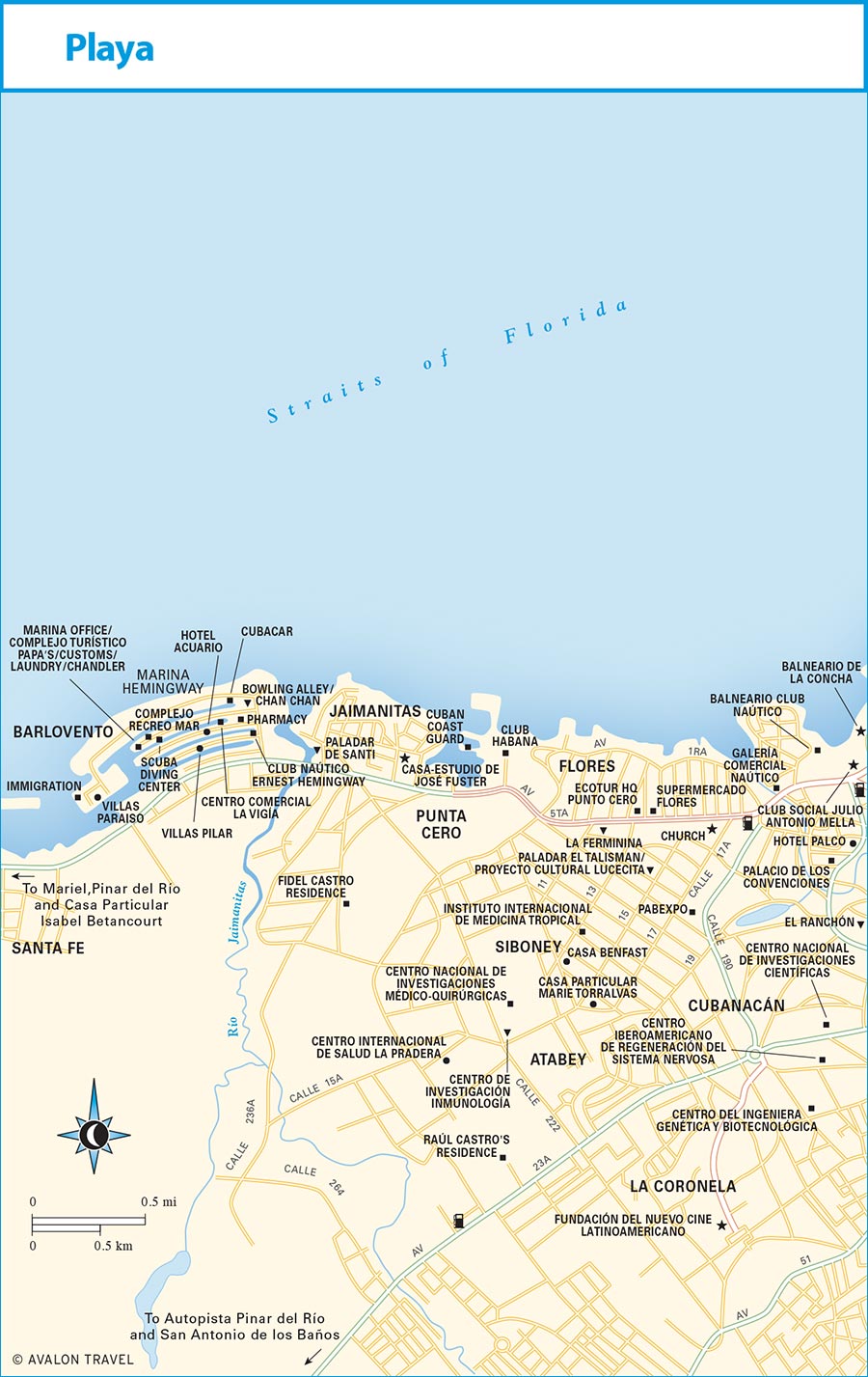
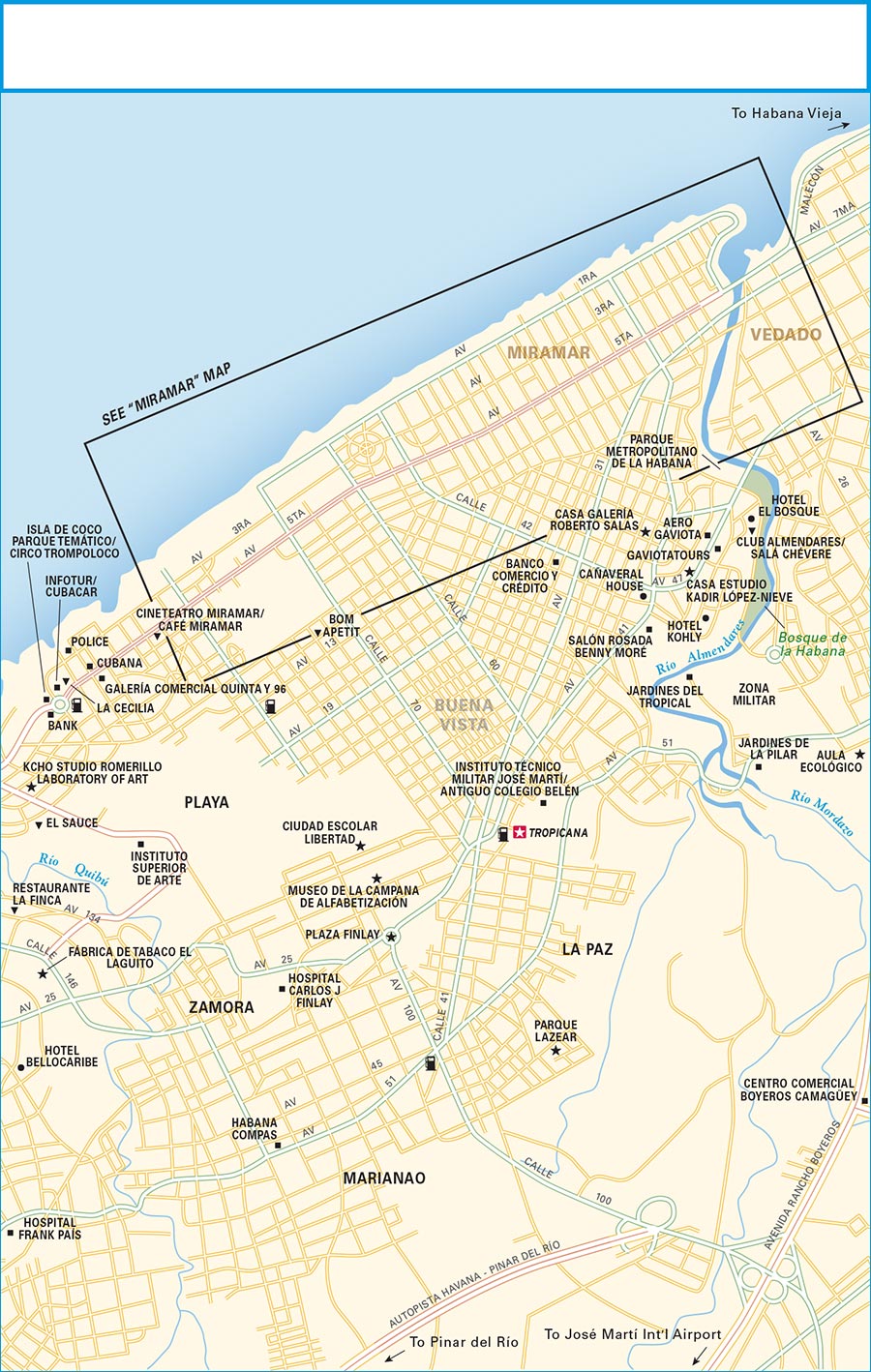
Miramar is Havana’s upscale residential district, laid out in an expansive grid of tree-shaded streets lined by fine mansions. Most of their original owners fled Cuba after the Revolution. Nonetheless, Miramar is at the forefront of Cuba’s quasi-capitalist remake. The best-stocked stores are here, as are the foreign embassies and many of the city’s top paladares and private nightclubs.
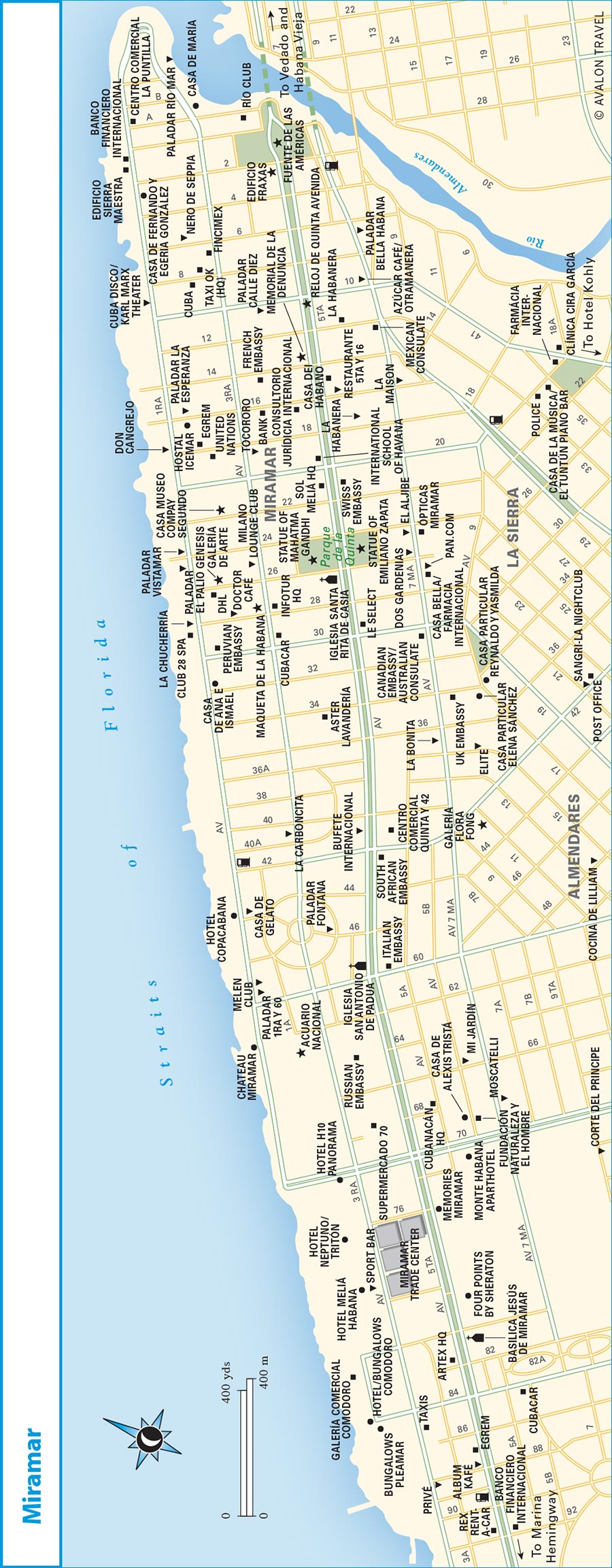
Primera Avenida (1st Avenue, 1ra Av.) runs along the shore. Time-worn balnearios (bathing areas) are found along Miramar’s waterfront, cut into the shore. Of limited appeal to tourists, they draw Cubans on hot summer days. Inland, running parallel at intervals of about 200 meters, are 3ra Avenida, 5ta Avenida (the main thoroughfare), and 7ma Avenida.
Tunnels under the Río Almendares connect Miramar to Vedado. The Malecón connects with 5ta Avenida; Línea (Calle 9) connects with 7ma Avenida and Avenida 31, which leads to the Marianao district; Calle 11 connects with 7ma Avenida; and Calle 23 becomes Avenida 47, linking Vedado with Kohly and Marianao.
The wide, fig-tree-lined, eight-kilometer-long boulevard called 5th Avenue, or “Quinta,” runs ruler-straight through the heart of Miramar. It is flanked by mansions, many now occupied by foreign embassies; Quinta Avenida (5ta Av.) is known as “Embassy Row.”
At its eastern end, the Casa de la Tejas Verdes (House of Green Tiles, Calle 2 #318, Miramar, tel. 07/212-5282, tejasverde@patrimonio.ohc.cu, visits by appointment), or Edificio Fraxas, is a restored beaux-arts mansion on the north side of Quinta at Calle 2, immediately west of the tunnel. Built in 1926, after the Revolution it fell into utter decay. It has a sumptuous postmodern interior.
The junction at Calle 10 is pinned by Reloj de Quinta Avenida, a large clock erected in 1924 in the central median. At Calle 12, the Memorial de la Denuncia (Museum of Denouncement, 5ta Av., esq. 14, tel. 07/206-8802, ext. 108, www.cubadenuncia.cu) opened in 2016 and is dedicated to U.S.-Cuba relations. Six salas (rooms) are themed, including one dedicated to the CIA’s efforts to dethrone Fidel and another to el bloqueo (the embargo). It’s run by the Ministry of the Interior.
Parque de los Ahorcados (Park of the Hanged), aka Parque de la Quinta, spans Quinta between Calles 24 and 26. The park is shaded by massive jagüey trees and features a Greek-style rotunda, a bust of Gandhi (north side), and a statue of Emilio Zapata (south side). The park is best avoided on Sunday mornings, when the “Ladies in White” dissident group gathers to march, with no shortage of secret police present. Rising over the west side is Iglesia de Santa Rita de Casia (5ta, esq. Calle 26, tel. 07/204-2001). This exemplar of modernist church architecture dates from 1942; its main feature is a statue of Santa Rita by Rita Longa. Music lovers might head two blocks north to Casa Museo Compay Segundo (Calle 22 #103, e/ 1ra y 3ra, tel. 07/206-8629 or 202-5922, Mon.-Fri. 10am-noon and 2pm-4pm, free), where the crooner of Buena Vista Social Club fame is honored.
The modernist-style Romanesque Iglesia San Antonio de Padua (Calle 60 #316, esq. 5ta, tel. 07/203-5045) dates from 1951 and boasts a magnificent, albeit nonfunctional, organ. On the north side of Quinta, a monstrous Cubist tower can be seen virtually the length of the avenue. Formerly the Soviet Embassy, it is now the Russian Embassy (5ta, e/ 62 y 66), topped by an intelligence-gathering tower with a view over the horizon to Florida.
At Calle 70 is the Miramar Trade Center, comprising six buildings. On the south side of Quinta rises the massive Roman-Byzantine-style Basílica Jesús de Miramar (5ta #8003, e/ 80 y 82, tel. 07/203-5301, daily 9am-noon and 4pm-6pm), built in 1953 with a magnificent organ with 5,000 pipes and 14 splendid oversize paintings of the stations of the cross.
The Pabellón de la Maqueta de la Habana (Model of Havana, Calle 28 #113, e/ 1ra y 3ra, tel. 07/202-7303, Mon.-Sat. 9:30am-5pm, adults CUC3, students, seniors, and children CUC1, guided tour CUC1, cameras CUC2) is a 1:1,000 scale model of the city. The 144-square-meter maqueta (model) represents 144 square kilometers of Havana and its environs. The model took more than 10 years to complete and shows Havana with every building present, color-coded by age.
The Acuario Nacional (National Aquarium, 3ra Av., esq. 62, tel. 07/203-6401, www.acuarionacional.cu, Tues.-Sun. 10am-6pm and until 10pm July-Aug., adults CUC10, children CUC7, including shows) exhibits 450 species of sealife, including corals, exotic tropical fish, sharks, hawksbill turtles, sea lions, and dolphins. The displays are disappointing by international standards. Sea lion shows (Tues.-Sun. 11am and 4pm, Sat.-Sun. 11am, 2pm, and 4pm) and dolphin shows (daily noon, 3pm, and 5pm) are offered.
The Fundación Naturaleza y El Hombre (Foundation of Man and Nature, Av. 5B #6611, e/ 66 y 70, tel. 07/204-2985, www.fanj.cult.cu, Mon.-Fri. 9am-4pm, CUC2) honors Cuban naturalist and explorer Antonio Nuñez Jiménez. Many of the eclectic exhibits in its Museo de la Canoa are dedicated to the 10,889-mile journey by a team of Cubans (led by Nuñez in 1996) that paddled from the source of the Amazon to the Bahamas in dugout canoes. There is a replica of the canoe along with indigenous artifacts, including pre-Columbian erotic ceramics.
Beyond Miramar, 5ta Avenida curls around the half-moon Playa Marianao and passes through the Náutico district, a setting for Havana’s elite prerevolutionary social clubs and balnearios. Following the Revolution, the area reopened to the hoi polloi and was rechristened. The beaches—collectively known as Playas del Oeste—are popular with Cubans on weekends. There was even an eponymous mini-version of New York’s famous Coney Island theme park, re-created in 2008 as Isla de Coco Parque Temático (tel. 07/208-0330, Wed.-Fri. 4pm-10pm, Sat.-Sun. 10am-10pm).
Commanding the scene are the palatial Mudejar-style former Balneario de la Concha (5ta e/ 112 and 146) and, immediately west, the Balneario Club Náutico with its sweeping modernist entrance. Beyond the Río Quibu, 5ta Avenida passes into the Flores district. The Havana-Biltmore Yacht and Country Club was here, dating from 1928 and fronting Havana’s most beautiful expanse of white sand. The “Yacht” was founded in 1886 and became the snootiest place in Havana (it was here that President Fulgencio Batista, mulatto, was famously refused entry for being too “black”) until the Revolution, when it became the Club Social Julio Antonio Mella, for workers. Today, as the Club Habana (5ta Av., e/ 188 y 214, Playa, tel. 07/204-5700, yanis@clubhabana.palco.cu), it has reverted to its former role as a private club for the (mostly foreign) elite. Nonmembers are welcome (daily 9am-7pm, Mon.-Fri. CUC20, Sat.-Sun. CUC30) to use the beach, water sports equipment, and pool.
Fidel Castro’s main domicile was here at Punta Cero in Jaimanitas, although you can’t see it. The home is set in an expansive compound surrounded by pine trees and electrified fences and heavy security south of Avenida 5ta. All streets surrounding it are marked as one-way, heading away from the house, which is connected by a tunnel to the navy base immediately west of Club Havana. Avenida 5ta between Calles 188 and 230 is a no-photography zone.
In 2014, world-renowned artist Alexis Leiva Machado, better known as “Kcho,” opened this contemporary art complex (7ma, esq. 120, Playa, tel. 07/208-4750 or 5279-1844, www.kchoestudio.com, by appointment) with a library, theater, experimental graphic workshop, and galleries showing revolving exhibitions of leading artists worldwide. It also has a foundry and carpentry and pottery workshops. Enhancing the complex are the local parks that comprise Museo Orgánico Romerillo, which spans 20 blocks. Kcho finances the project himself.
Artist José R. Fuster, a world-renowned painter and ceramist nicknamed the “Picasso of the Caribbean,” has an open-air workshop-gallery at his home (Calle 226, esq. Av. 3ra, Jaimanitas, tel. 07/271-2932 or 5281-5421, www.josefuster.com, daily 9am-5pm; call ahead). You step through a giant doorway to discover a surreal world made of ceramics. Many of the naïve, childlike works are inspired by farmyard scenes and icons of cubanidad, such as El Torre del Gallo (Rooster’s Tower), a four-meter-tall statement on male chauvinism. Fuster’s creativity now graces the entryways, benches, roofs, and facades of houses throughout his local community.
Cubanacán is—or was—Havana’s Beverly Hills, an exclusive area inland of Náutico and Flores. It was developed in the 1920s with winding tree-lined streets on which the most grandiose of Havana’s mansions arose. The golf course at the Havana Country Club lent the name “Country Club Park” to what is now called Cubanacán, still the swankiest address in town. Following the Revolution, most of the area’s homeowners fled Cuba. Many mansions were dispensed to Communist officials, who live in a manner that the majority of Cubans can only dream of and, of course, never see. The area is replete with military camps and security personnel. Other homes serve either as “protocol” houses—villas where foreign dignitaries and VIPs are housed during visits—or as foreign embassies and ambassadors’ homes.
One of the swankiest mansions was built in 1910 for the Marqués de Pinar del Río; it was later adorned with 1930s art deco glass and chrome, a spiral staircase, and abstract floral designs. Today it is the Fábrica El Laguito (Av. 146 #2302, e/ 21 y 21A, tel. 07/208-0738, by appointment only), the nation’s premier cigar factory, making Montecristos and the majority of Cohibas—the premium Havana cigar.
Havana’s impressive convention center, the Palacio de las Convenciones (Convention Palace, Calle 146, e/ 11 y 13, tel. 07/202-6011, www.eventospalco.com), was built in 1979 for the Non-Aligned Conference. The main hall hosts twice-yearly meetings of the Cuban National Assembly. Two blocks west, Pabexpo (Av. 17 e/ 180 y 182, tel. 07/271-3670) has four exhibition halls for trade shows and is Cuba’s main expo space.
Cuba’s biotechnology industry is also centered here and extends westward into the districts of Atabey and Siboney (a residential area for MININT and military elite), earning the area the moniker “Scientific City.” The Centro de Ingenieria Genética y Biotecnología (Center for Genetic Engineering and Biotechnology, Av. 31, e/ 158 y 190, Havana, tel. 07/271-8008, http://cigb.edu.cu) is Cuba’s main research facility and perhaps the most sophisticated research facility in any developing nation.
Following the Revolution, Fidel Castro and Che Guevara famously played a few rounds of golf at the exclusive Havana Country Club before tearing it up and converting the grounds to house Cuba’s leading art academy, the Instituto Superior de Arte (Higher Art Institute, Calle 120 #1110, esq. 9na, tel. 07/208-9771, www.isa.cult.cu, appointment only through a tour agency; closed in summer), featuring the Escuela de Música (School of Music), Escuela de Ballet (Ballet School), Escuela de Baile Moderno (School of Modern Dance), and Escuela de Bellas Artes (School of Fine Arts). The school was designed by three young “rebel” architects: Italians Roberto Gottardi and Vittorio Garatti, and Cuban Ricardo Porro. As the five redbrick main buildings emerged, they were thought too avant-garde. The project was halted, though the school did open. Many buildings were never completed and fell into ruin. Calles 15 and 134 have the best views.
This dilapidated municipio, on the heights south of Miramar, evolved since the mid-19th century along newly laid streets. During the 1920s, Marianao boasted the Marianao Country Club, the Oriental Park racetrack, and Grand Nacional Casino; it was given a boost on New Year’s Eve 1939 when the Tropicana opened as Havana’s ritziest nightclub. After the Revolution, the casinos, racetrack, and even Tropicana (briefly) were shut down.
Following the U.S. occupation of Cuba in 1898, the U.S. military governor, General Fitzhugh Lee, established his headquarters in Marianao and called it Camp Columbia. Campamento Columbia later became headquarters for Batista’s army, and it was from here that the sergeant effected his golpes in 1933 and 1952. Camp Columbia was bombed on April 15, 1960, during the prelude to the CIA-run Bay of Pigs invasion.
Following the Revolution, Castro turned the barracks into Ciudad Escolar Libertad, a school complex that became the headquarters for Castro’s national literacy campaign. The Museo de la Campaña de Alfabetización (Museum of the Literacy Campaign, Av. 29E, esq. 76, tel. 07/260-8054, Mon.-Fri. 8am-5pm, Sat. 8am-noon, free) is dedicated to the campaign initiated on January 1, 1960, when 120,632 uniformed brigadistas, mostly students, spread out across the country to teach illiterate peasantry to read and write. The blue building 100 meters west was Fulgencio Batista’s former manse.
A tower in the center of the traffic circle—Plaza Finlay—outside the main entrance, at Avenida 31 and Avenida 100, was erected in 1944 as a beacon for the military airfield. In 1948 a needle was added so that today it is shaped like a syringe in honor of Carlos Finlay, the Cuban who in 1881 discovered the cause of yellow fever.
The Autopista a San Antonio links Havana with San Antonio de los Baños. Midway between the two cities, you’ll pass the Universidad de las Ciencias Informáticas (Carretera de San Antonio de los Baños, Km 2, Torrens, tel. 07/837-2548, www.uci.cu), Cuba’s university dedicated to making the country a world power in software technology. Immediately north is the gray marble Memorial al Soldado Internacionalista Soviético, with an eternal flame dedicated to Soviet military personnel who died in combat.
The Tropicana (Calle 72 e/ 41 y 45, tel. 07/207-0110, www.cabaret-tropicana.com) is an astonishing exemplar of modernist architecture. Most of the structures date from 1951, when the nightclub was restored with a new showroom—the Salon Arcos de Cristal (Crystal Bows)—designed by Max Borges Recio with a roof of five arcing concrete vaults and curving bands of glass to fill the intervening space. Built in decreasing order of height, they produce a telescopic effect that channels the perspective toward the orchestra platform. Borges also added the famous geometric sculpture that still forms the backdrop to the main stage, in the outdoor Salón Bajo las Estrellas.
A ballet dancer pirouettes on the tips of her toes amid the lush foliage in front of the entrance. The statue, by the renowned Cuban sculptor Rita Longa, is surrounded by bacchantes performing a wild ritual dance to honor Dionysius.
The harbor channel and Bahía de la Habana (Havana Bay) separate Habana Vieja from the communities of Casablanca, Regla, and Guanabacoa. The communities can be reached through a tunnel under the channel (access is eastbound off Avenida del Puerto and the Prado) or along Vía Blanca, skirting the harbor. Little ferries bob their way across the water, connecting Casablanca and Regla with each other and with Habana Vieja.
Looming over Habana Vieja, on the north side of the harbor channel, the rugged cliff face is dominated by two great fortresses that constitute Parque Histórico Militar Morro-Cabaña (Morro-La Cabaña Historical Military Park, Carretera de la Cabaña, Habana del Este, tel. 07/862-4095). Together, the castles comprise the largest and most powerful defensive complex built by the Spanish in the Americas.
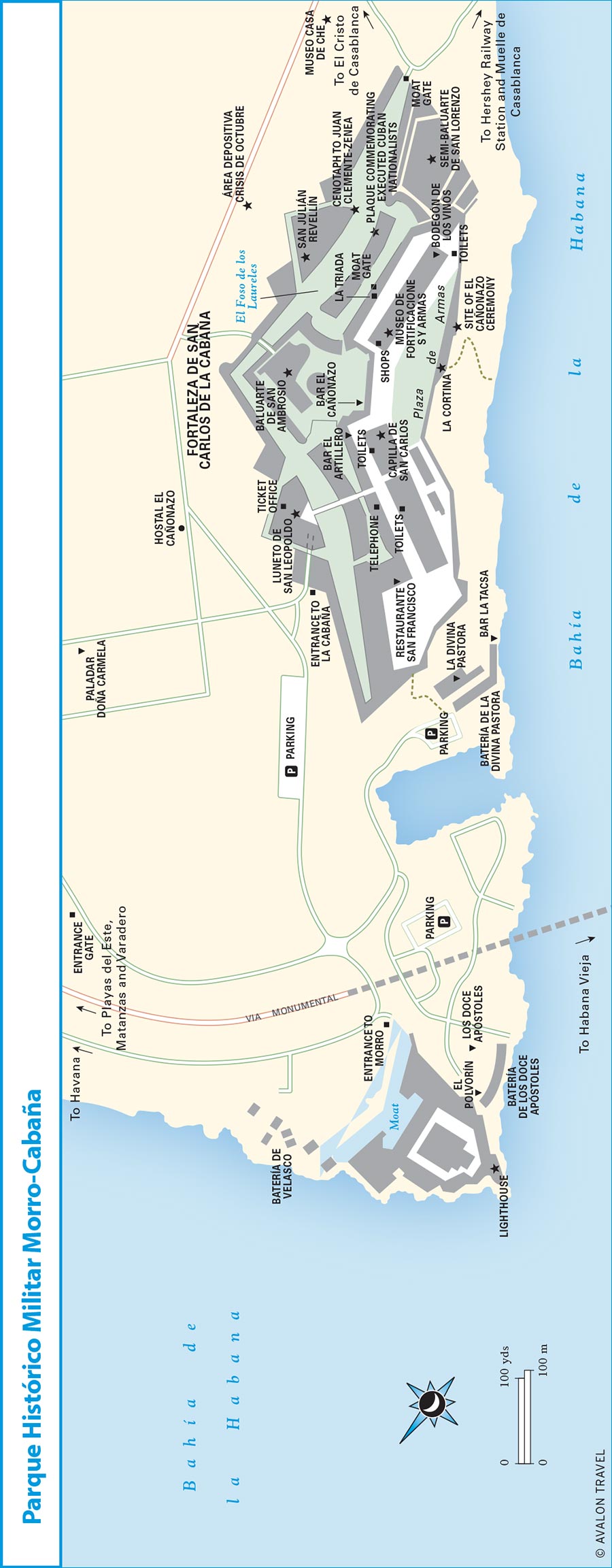
Visitors arriving by car reach the complex via the harbor tunnel (no pedestrians or motorcycles without sidecars are allowed) that descends beneath the Monumento al General Máximo Gómez off Avenida de Céspedes. Buses from Parque de la Fraternidad pass through the tunnel and stop by the fortress access road.
The Castillo de Los Tres Reyes del Morro (Castle of the Three Kings of the Headland, tel. 07/863-7941, daily 8am-7pm, entrance CUC6, children under 12 free, guide CUC1) is built into the rocky palisades of Punta Barlovento at the entrance to Havana’s narrow harbor channel. The fort—designed by Italian engineer Bautista Antonelli and initiated in 1589—forms an irregular polygon that follows the contours of the headland, with a sharp-angled bastion at the apex, stone walls 10 feet thick, and a series of batteries stepping down to the shore. Slaves toiled under the lash of whip and sun to cut the stone in situ, extracted from the void that forms the moats. El Morro took 40 years to complete and served its job well, repelling countless pirate attacks and withstanding for 44 days a siege by British cannons in 1762.

Castillo de los Tres Reyes del Morro
Enter via a drawbridge across a deep moat, leading through the Túnel Aspillerado (Tunnel of Loopholes) to vast wooden gates that open to the Camino de Rondas, a small parade ground (Plaza de Armas) containing a two-story building atop water cisterns that supplied the garrison of 1,000 men. To the right of the plaza, a narrow entrance leads to the Baluarte de Austria (Austrian Bastion), with cannon embrasures for firing down on the moat.
To the left of the Plaza de Armas, the Sala de Historia del Faro y Castillo profiles the various lighthouses and castles in Cuba. Beyond is the Surtida de los Tinajones, where giant earthenware vases are inset in stone. They once contained rapeseed oil as lantern fuel for the 25-meter-tall Faro del Morro (daily 10am-noon and 2pm-7pm, CUC2 extra), a lighthouse constructed in 1844. Today an electric lantern still flashes twice every 15 seconds. You can climb to the top for a bird’s-eye view.
All maritime traffic in and out of Havana harbor is controlled from the Estación Semafórica, the semaphore station atop the castle, accessed via the Baluarte de Tejeda. Below the castle, facing the city on the landward side and reached by a cobbled ramp, is the Batería de los Doce Apóstoles (Battery of the Twelve Apostles). It boasts massive cannons and El Polvorín (The Powderhouse) bar.
The massive Fortaleza de San Carlos de la Cabaña (Saint Charles of the Flock Fortress, Carretera de la Cabaña, tel. 07/862-4095, daily 10am-10pm, entrance CUC6 adults, children under 12 free, CUC8 for the cañonazo ceremony, guide CUC1), half a kilometer east of the Morro, enjoys a fantastic strategic position overlooking the city and harbor. It is the largest fort in the Americas, covering 10 hectares and stretching 700 meters in length. It was built 1763-1774 following the English invasion, and cost the staggering sum of 14 million pesos—when told the cost, the king after whom it is named reached for a telescope; surely, he said, it must be large enough to see from Madrid. The castle counted some 120 bronze cannons and mortars, plus a permanent garrison of 1,300 men. While never actually used in battle, it has been claimed that its dissuasive presence won all potential battles—a tribute to the French designer and engineer entrusted with its conception and construction.
From the north, you pass through two defensive structures before reaching the monumental baroque portal flanked by great columns with a pediment etched with the escutcheon of Kings Charles III, followed by a massive drawbridge over a 12-meter-deep moat, one of several moats carved from solid rock and separating individual fortress components.
Beyond the entrance gate a paved alley leads to the Plaza de Armas, centered on a grassy, tree-shaded park fronted by a 400-meter-long curtain wall: La Cortina runs the length of the castle on its south side and formed the main gun position overlooking Havana. It is lined with cannons. The Ceremonía del Cañonazo (cannon-firing ceremony, CUC6) is held nightly at 8:30pm, when troops dressed in 18th-century military garb and led by fife and drum light the fuse of a cannon to announce the closing of the city gates, maintaining a tradition going back centuries. The soldiers prepare the cannon with ramrod and live charge. When the soldier puts the torch to the cannon at 9pm, you have about three seconds before the thunderous boom. It’s all over in a millisecond, and the troops march away. Opening to the plaza is a small chapel with a baroque facade and charming vaulted interior. The building opposite served as the headquarters for Che Guevara following the Triunfo del Revolución, when he oversaw the tribunals for “crimes against the security of the state.”
Facing the plaza on its north side is the Museo de Fortificaciones y Armas. The museum (set in thick-walled, vaulted storage rooms, or bovedas) traces the castle’s development and features uniforms and weaponry from the colonial epoch, including a representation of a former prison cell, plus suits of armor and weaponry that span the ancient Arab and Asian worlds and stretch back through medieval times to the Roman era.
A portal here leads into a garden—Patio de los Jagüeyes—that once served as a cortadura, a defensive element packed with explosives that could be ignited to foil the enemy’s attempts to gain entry. The bovedas open to the north to cobbled Calle de la Marina, where converted barracks, armaments stores, and prisoners’ cells now contain restaurants and the Casa del Tabaco y Ron, displaying the world’s longest cigar (11 meters long).
Midway down Marina, a gate leads down to El Foso de los Laureles, a massive moat containing the execution wall where nationalist sympathizers were shot during the wars of independence. Following the Revolution, scores of Batista supporters and “counterrevolutionaries” met a similar fate.
Displayed atop the San Julián Revellín moat, on the north side of Fortaleza de San Carlos, are missiles and armaments from the Cuban Missile Crisis (called the October 1962 Crisis by Cubans). These include an SS-4 nuclear missile; English-language panels explain that it had a range of 2,100 kilometers and a one-megaton load. It was one of 36 such missiles installed at the time. Also here are a MiG fighter jet, various antiaircraft guns, and the remains of the U-2 piloted by Major Rudolf Anderson shot down over Cuba on October 27, 1962. You can view them from the road but it costs CUC1 to get up close and personal.
The Estatua Cristo de la Habana (Havana Christ Statue, Carretera del Asilo, daily 9am-8pm, entrance CUC1, children under 12 free) looms over Casablanca, dominating the cliff face immediately east of the fortaleza. The 15-meter-tall statue, unveiled on December 25, 1958, was hewn from Italian Carrara marble by Cuban sculptor Jilma Madera. From the mirador surrounding the statue, you have a bird’s-eye view of the harbor. It is possible, with the sun gilding the waters, to imagine great galleons slipping in and out of the harbor laden with treasure en route to Spain.
The adjoining Casa-Museo del Che (tel. 07/866-4747, daily 9am-7pm, entrance CUC6, guide CUC1) is where Che Guevara lived immediately following the fall of Batista. Today it displays his M-1 rifle, submachine gun, radio, and rucksack, among other exhibits.
A ferry (10 centavos) runs to Casablanca every 20 minutes or so from the Emboque de Luz (Av. del Puerto y Calle Luz) in Habana Vieja. You can walk uphill from Casablanca.
Regla, a working-class barrio on the eastern shore of Havana harbor, evolved in the 16th century as a fishing village and eventually became Havana’s foremost warehousing and slaving center. It developed into a smugglers’ port in colonial days. Havana’s main electricity-generating plant and petrochemical works are here, pouring bilious plumes over town.
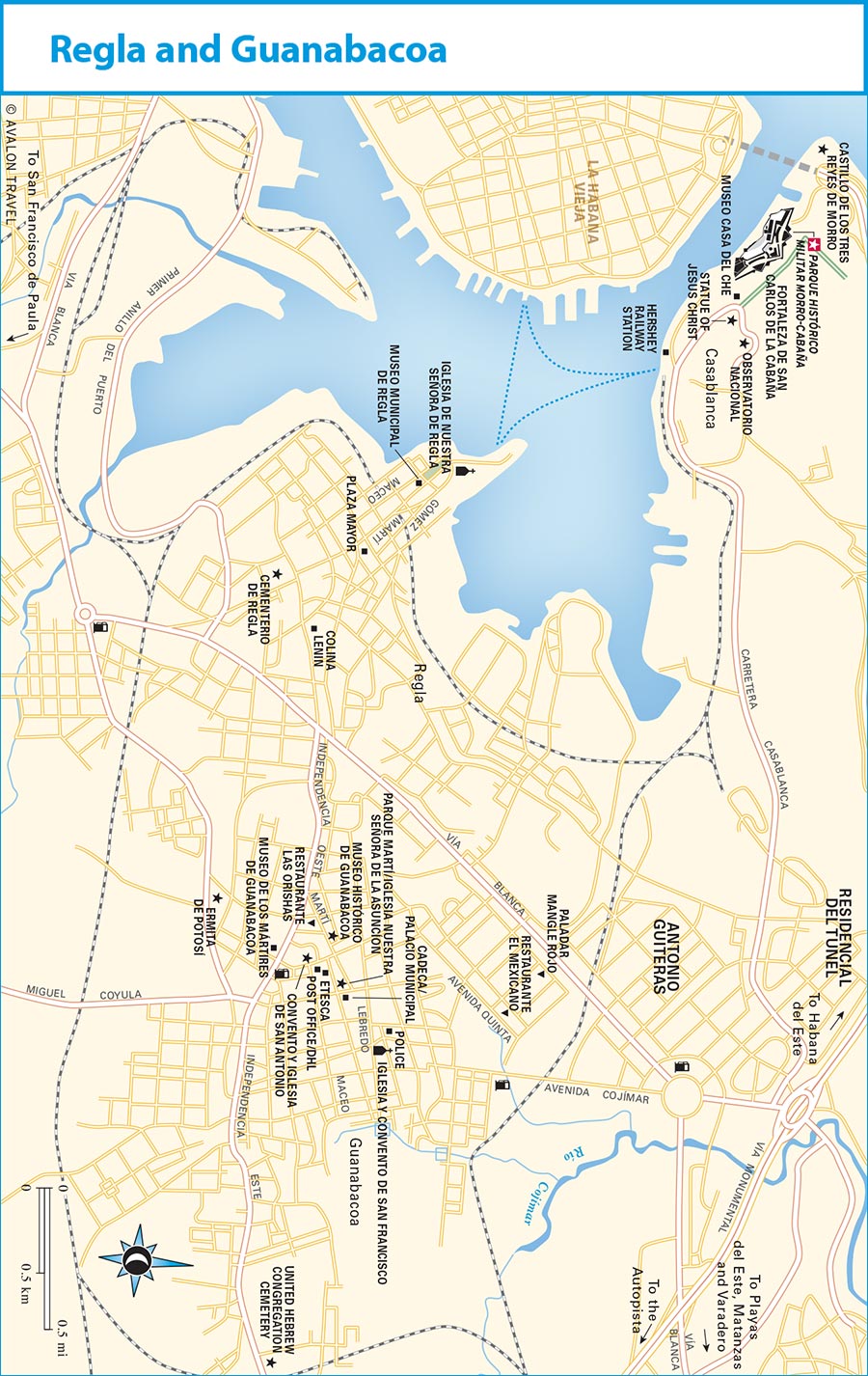
Regla is a center of Santería; note the tiny shrines outside many houses. Calle Calixto García has many fine examples. Many babalawos (Santería priests) live here and will happily dispense advice for a fee.
The Museo Municipal de Regla (Martí #158, e/ Facciolo y La Piedra, tel. 07/797-6989, Tues.-Sat. 9am-8:45pm, Sun. 1pm-8:45pm, entrance CUC2, guide CUC1), two blocks east of the harborfront, tells the tale of the town’s Santería associations. Other displays include colonial-era swords, slave shackles, and the like.
Calle Martí, the main street, leads southeast to the city cemetery; from there, turn east onto Avenida Rosario for two blocks, where steps ascend to Colina Lenin (Lenin Hill, Calle Vieja, e/ Enlase y Rosaria). A three-meter-tall bronze face of the Communist leader is carved into the cliff face; a dozen life-size figures (in cement) cheer him from below. A museum (tel. 07/797-6899, Tues.-Sat. 9am-5pm, free) atop the hill is dedicated to Lenin and various martyrs of the Cuban Revolution.
The Colina is more directly reached from Parque Guaycanamar (Calle Martí, six blocks east of the harborfront) via Calle Albuquerque and 24 de Febrero; you’ll reach a metal staircase that leads to the park. Bus #29 will take you there from the Regla dock.
Ferries (10 centavos) run between Regla and the Emboque de Luz (Av. San Pedro y Luz) in Habana Vieja. Bus P15 departs the Capitolio for Regla.
The Iglesia de Nuestra Señora de Regla (Church of Our Lady of Regla, Sanctuario #11, e/ Máximo Gómez y Litoral, tel. 07/797-6228, daily 7:30am-5:30pm), built in 1810 on the harborfront, is one of Havana’s loveliest churches, highlighted by a gilt altar. Figurines of miscellaneous saints dwell in wall alcoves, including a statue of St. Anthony leading a wooden suckling pig. Habaneros flock to pay homage to the black Virgen de Regla, patron saint of sailors and Catholic counterpart to Yemayá, the goddess of water in the Santería religion. Time your visit for the seventh of each month, when large masses are held, or for a pilgrimage each September 7, when the Virgin is paraded through town.
Outside, 20 meters to the east and presiding over her own private chapel, is a statue of the Virgen de la Caridad del Cobre, Cuba’s patron saint. Syncretized as the orisha Ochún, she also draws adherents of Santería.
Guanabacoa, three kilometers east of Regla, was founded in 1607 and developed as the major trading center for slaves. An Afro-Cuban culture evolved here, expressed in a strong musical heritage. The Casa de la Trova (Martí #111, e/ San Antonio y Versalles, tel. 07/797-7687, hours vary, entrance one peso) hosts performances of Afro-Cuban music and dance, as does Centro Cultural Recreativo Los Orishas (Calle Martí, e/ Lamas y Cruz Verde, tel. 07/794-7878, daily noon-midnight), which hosts live rumba on weekends plus Friday 9pm shows; it doubles as a restaurant serving criolla dishes and pizzas (CUC2-10). Guanabacoa is also Cuba’s most important center of Santería. So strong is the association that all over Cuba, folks facing extreme adversity will say “I’m going to have to go to Guanabacoa,” implying that only the power of a babalawo can fix the problem.
Guanabacoa also boasts several religious sites (most are tumbledown and await restoration), including two Jewish cemeteries on the east side of town.
The sprawling town is centered on the small tree-shaded Parque Martí (Calles Martí, División Pepe Antonio, y Adolfo del Castillo Cadenas), dominated by the Iglesia Nuestra Señora de la Asunción (División #331, e/ Martí y Cadenas, tel. 07/797-7368, Mon.-Fri. 8am-noon and 2pm-5pm, Sun. 8am-11am), commonly called the Parroquial Mayor. Completed in 1748, it features a lofty Mudejar-inspired wooden roof and baroque gilt altar dripping with gold, plus 14 stations of the cross. If the doors are locked, try the side entrance on Calle Enrique Güiral.
The Museo Histórico de Guanabacoa (Historical Museum of Guanabacoa, Martí #108, e/ Valenzuela y Quintín Bandera, tel. 07/797-9117, musgbcoa@cubarte.cult.cu, Tues.-Sat. 9:30am-5:30pm, entrance CUC2, guide CUC1), one block west of the plaza, tells of Guanabacoa’s development and the evolution of Afro-Cuban culture.
One block southwest of the park, the Convento y Iglesia de San Antonio (Máximo Gómez, esq. San Antonio, tel. 07/797-7241), begun in 1720 and completed in 1806, is now a school. The custodio may let you in to admire the exquisite alfarje ceiling.
The Convento de Santo Domingo (Santo Domingo #407, esq. Rafael de Cadena, tel. 07/797-7376, Tues.-Fri. 9am-11:30am and 3:30pm-5pm but often closed) dates from 1728 and has an impressive neobaroque facade. Its church, the Iglesia de Nuestra Señora de la Candelaria, boasts a magnificent blue-and-gilt baroque altar plus an intricate alfarje. The door is usually closed; ring the doorbell to the left of the entrance.
The only ecclesiastical edifice thus far restored is the tiny hilltop Ermita de Potosí (Potosí Hermitage, Calzada Vieja Guanabacoa, esq. Calle Potosí, tel. 07/797-9867, daily 8am-5pm). The simple hermitage dates to 1644 and is the oldest religious structure still standing in Cuba. It has an intriguing cemetery.
Bus #29 runs to Guanabacoa from the Regla dock. Bus P15 departs for Guanabacoa via Regla from in front of the Capitolio, on the south side of Parque de la Fraternidad; you can catch it in Vedado from G y 23.
Yes, the city has lost the Barbary Coast spirit of prerevolutionary days, but habaneros love to paint the town red as much as their budgets allow. Many venues are seedier than they were in the 1950s—in some, the decor hasn’t changed. Pricey entrance fees dissuade Cubans from attending the hottest new venues. Cubans are even priced out of most bars (one beer can cost the equivalent of a week’s salary).
The great news is that private bars and nightclubs have sprouted like mushrooms on a damp log; all serve food to get around the legal licensing restrictions on bars. Havana now has some chic scenes reminiscent of L.A. or Miami.
For theater, classical concerts, and other live performances it’s difficult to make a reservation by telephone. Instead, go to the venue and buy a ticket in advance or just before the performance. Call ahead to double-check dates, times, and venue.
Cartelera, a cultural magazine for tourists published monthly by Artex, has information on exhibitions, galleries, performances, and more. A fantastic Internet source is La Habana (www.lahabana.com), which publishes a monthly update of live concerts and other cultural events nationwide. Havana Club (www.havana-cultura.com) maintains a pretty cool website with hip profiles on cultural events. And both Suena Cubano (www.suenacubano.com) and Vistar (www.vistarmagazine.com), two Cuban start-ups, also have up-to-date listings of events.
Radio Taíno (1290 AM and 93.3 FM, daily 5pm-7pm) serves tourists with information on cultural happenings via nightly broadcasts.
Since so many young Cubans lack money for bars and clubs, thousands hang out on the Malecón (principally between Calle 23 and Calle 0) and along Avenida de los Presidentes (Calle G) on weekend nights. The latter chiefly draws frikis (Goths and punks), roqueros, and what Julia Cooke calls “a genealogical map of youth culture,” who mill around sharing beer or rum and listening to music played on cell phones.
Every tourist in town wants to sip a mojito at La Bodeguita del Medio (Empedrado #207, e/ Cuba y Tacón, tel. 07/867-1374, daily 10am-midnight). Go for the ambience, aided by troubadours, rather than the drinks: The mojitos are weak, perhaps explaining why Hemingway didn’t sup here, contrary to legend. Instead, Hemingway preferred to tipple his mojitos at the Dos Hermanos (Av. San Pedro #304, esq. Sol, tel. 07/861-3514, 11am-11pm), a refurbished wharf-front saloon where he bent elbows with sailors and prostitutes at the long wooden bar. Tourists and a sprinkling of locals are today’s clientele, but the mojitos are consistently good (CUC4). There’s often live music.
Hemingway enjoyed his sugarless papa doble daiquiri (double shot of rum) at El Floridita (Obispo, esq. Monserrate, tel. 07/867-1301, bar open daily 11:30am-midnight). It may not quite live up to its 1950s aura, when Esquire magazine named it one of the great bars of the world, but to visit Havana without sipping a daiquiri here would be like visiting France without tasting wine. It gets packed; the only Cubans are the musicians and waitstaff.
Now that the de rigueur tourist bars have been addressed, find the real fun at the bi-level O’Reilly 304 (Calle O’Reilly #304, e/ Habana y Aguiar, tel. 5264-4725, oreilly304@gmail.com, daily noon-midnight), one of the hippest and trendiest spots in town. Most folks come to dine, but you can hang at the bar and sample the mango daiquiri and killer watermelon mojitos while grooving to hip music played by a live band on the stairwell. Get there early for a seat.
Privately run, Lamparilla Tapas y Cerveza (Calle Lamparilla #361 e/ Aguacate y Villegas, tel. 5289-5324, daily 11:30am-11:30pm) is a chill place to hang, listen to cool sounds, and savor beer and tapas such as fish croquetas and adobo pork chops with zucchini tempura. Bare brick walls are festooned with hip art, and the eclectic furnishings add a note of the bohemian.
For chic, try Sloppy Joe's (Animas, esq. Zulueta, tel. 07/866-7157, daily noon-2am). This once-legendary bar—founded in 1918 by José Abel, who turned a dilapidated and messy grocery store into “Sloppy Joe’s”—reopened in 2013 after decades in ruins. It’s been remade as it was, with glossy wood paneling and a long mahogany bar with tall barstools and flat-screen TVs. The Sloppy Joe house drink is made of brandy, Cointreau, port, and pineapple juice (CUC5).
Just around the corner is the trendy Bar Asturias (Prado #309 esq. Virtudes, tel. 07/864-1447, 10pm-2am), a cool and colorful club to the rear of the ground floor of the Sociedad Cultural Asturiana. Go for the late-night jazz, jam sessions, and boleros.
Beer lovers should head to Plaza Vieja, where the Viennese-style brewpub Factoría Plaza Vieja (San Ignacio #364, tel. 07/866-4453, daily 11am-1am) produces delicious Pilsen (light) and Munich (dark) beer. You can order half liters (CUC2), liters, or a whopping three-liter dispensa, a tall glass cylinder fitted with a tap and with beer kept chilled by a thin center tube filled with ice.
The penny-pinching farandula (in-crowd) heads to Bar La Chanchullero (Brasil, e/ Berraza y Cristo, tel. 07/861-0915, www.el-chanchullero.com, daily 1pm-midnight), a cool and down-to-earth hole-in-the-wall on Plaza del Cristo.
The suave, state-run Adagio Barconcert (Paseo de Martí esq. Neptuno, tel. 07/861-6575, daily 2pm-2am, no cover) combines chic styling with awesome classical music (think Andrea Boccelli), bolero, and jazz, including live performances.
Bohemian, eclectic, and offbeat sum up Sia Kara (Calle Industria #502 esq. Barcelona, tel. 07/867-4084, daily 1pm-2am), one of Havana’s coolest bars. The brainchild of Cuban ballet dancer José Manuel Carreño and his partner, French-born artist Mateo Royar, it’s a true artsy hangout, popular with locals (including Havana’s cultural elite) who settle in on well-stuffed sofas and canoodle in the loft-style lounge. Tucked away behind the Capitolio, it’s off the tourist radar, but not for long. It serves simple dishes (CUC5) and a full range of cocktails (CUC2.50), but the wine list is feeble. The mojitos are superb, as is the caipiroska—a caipirinha made of vodka.
To find out what happened to the Soviet influence, head to Nazdarovie (Malecón #24, e/ Prado y Carcel, tel. 07/860-2947, daily noon-midnight), located upstairs in a townhouse manse overlooking the Atlantic. You’ll be greeted by a comrade in Soviet military cap. It’s mainly a restaurant serving Slavic-inspired fare, but the bar adds a Russian twist to their cocktails.
For rumba, trova, and even jazz, join the locals at cubbyhole El Jelengue de Areito (Calle San Miguel #410, e/ Campanario y Lealtad, no tel). Friday nights are best.
The Hotel Nacional’s patio Bar La Terraza is a great place to laze in a rattan sofa chair with a cigar and cocktail while musicians entertain with live music. For superb sweeping views of the city, try the Salón Turquino (25th floor inside Hotel Habana Libre Tryp, Calle L, e/ 23 y 25, tel. 07/834-6100), or La Torre (Calle 17 #55, e/ M y N, tel. 07/838-3088), atop the Focsa building.
At Esencia Habana (Calle B #153, e/ Calzada y Línea, tel. 07/836-3031, www.esenciahabana.com, 1pm-3am), owner Juan (a Spaniard) and his Cuban partner have conjured a colonial-style mansion into a classic Cuban bar with quasi-European pretension. It’s hugely popular with expats, perhaps because it feels slightly like an English pub. Go for happy hour Friday 5pm-8pm, and for tapas such as carpaccio (CUC6.50) and garlic shrimp (CUC5), best enjoyed on the patio terrace. Three blocks north, the Corner Café (Av. 1ra, esq. B, tel. 07/837-1220, daily 10am-close) has a hipper vibe thanks to DJs and live music.
La farandula (the in-crowd) hangs out atop El Cocinero (Calle 26, e/ 11 y 13, tel. 07/832-2355, www.elcocinerohabana.com), a former electricity station and fish warehouse turned open-air lounge club with a chic New York City vibe. Adjoining, the Fábrica de Arte (Calle 13 #61, esq. 26, tel. 07/838-2260, www.fac.cu, Thurs.-Sun. 8pm-3am, CUC2) is undisputably Havana’s chicest bohemian nightspot—a complete cultural venue with theater, film, dance, fashion shows, art exhibitions, concerts, and DJ Iván Lejardi’s experimental electronic raves. Alas, it’s been taken over by the tourist crowd and is a party stop for visiting VIPs and tour groups. On last visit I had to ask “where are the Cubans?” It’s housed in a former olive oil factory and fish warehouse and has multiple bars on two tiers. Drinks are on credit; you pay on check-out.
A great spot to mingle with Cuba’s artsy bohemians, Café Madrigal (Calle 17 #809, e/ 2 y 4, tel. 07/831-2433, rafa@audiovisuales.icaic.cu, Tues.-Sun. 6pm-2am) is upstairs in the home of filmmaker Rafael Rosales. This is a spot for tapas and a brain-freezingly chilled daiquiri. Movie memorabilia festoons the redbrick walls, alongside art pieces by Rafael’s pal Javier Garver. Relax over cocktails (from daiquiris to whiskey sours; CUC3) to laid-back tunes from Maxwell and Marvin Gaye.
For casual music and romantic ambience check out Bar Bohemio (Calle 21 #1065, e/ 12 y 14, tel. 07/833-6918, Tues.-Sun. 6pm-midnight, Fri.-Sat. 6pm-4am), housed in a spacious 1940s manse. Former ballet dancers run this private loungelike bar with an L-shaped terrace. Try the Moscow by Tang (a mojito made of vodka, with basil), best enjoyed on the planter-studded patio.
I love the bohemian ambience at La Casa de la Bombilla Verde (Calle 11 #905 e/ 6 y 8, tel. 5848-1331, daily noon-midnight), a chic, unpretentious art-filled lounge billed as a “café cultural.”
This district is ground zero for the hip private lounge club craze sweeping Havana. Many clubs are frequented by high-class jineteras.
Risqué artwork is a head-twisting constant at Espacios (Calle 10 #513, e/ 5ta y 7ta, tel. 07/202-2921, daily 1pm-2am), catering to bohemian types and Havana’s young monied crowd with several indoor lounges and an outdoor party space where live trova is played. It serves tapas.
Expats consider the Miami-style alfresco lounge bar at La Fontana (3ra Av. #305, esq. 46, tel. 07/202-8337, daily noon-2am) a second home for its cool blue-lit chic and great cocktails.
You’re forgiven if you think you’ve landed in South Beach at Melem (Av. 1ra e/ 58 y 60, tel. 07/203-0433, 8pm-3am), a chic and classy contemporary take on a cocktail club; it gets in the groove after midnight. It permits smoking.
Drawing monied young Cubans, the Hotel Meliá Habana’s chic alfresco Sport Bar (3ra Av., e/ 76 y 80, tel. 07/204-8500, Mon.-Fri. noon-3am and Sat.-Sun. 9am-3am) has a hip vibe, with omnipresent TVs tuned to sports, a DJ, and occasional live music.
Cabaret Nacional (San Rafael, esq. Prado, tel. 07/863-2361, CUC5), in the dingy basement of the Gran Teatro, has a modest espectáculo nightly at 10pm. The campy show is followed by a disco, drawing Cubans on weekends for steamy dancing; ostensibly only couples are admitted.
The most lavish show is the Cabaret Parisien (Calle O, esq. 21, tel. 07/836-3564, CUC30), in the Hotel Nacional. The Cubano Cubano show is offered Sunday-Friday at 10pm and is followed by a Latin dance school. The dinner special (CUC50-70) is best avoided. The place is cramped and fills with smoke, and while the show is nowhere near the scale of the Tropicana, it has plenty of color and titillation and allows patrons to avoid the long trek out to the Tropicana.
The Cabaret Copa Room (Paseo y Malecón, tel. 07/836-4051, CUC20), in the Hotel Habana Riviera, hosts a cabaret (Wed.-Mon. 10:30pm). The dated venue features the top names in live Cuban music, such as Los Van Van, and is one of Havana’s top spots for serious salsa fans.
Catering to a tourist crowd, Habana Café (Paseo, e/ 1ra y 3ra, tel. 07/833-3636, ext. 147, nightly 8pm-3am), adjoining the Hotel Meliá Cohiba, offers cabaret at 8:30pm. A vintage Harley-Davidson, two 1950s classic cars, and an airplane suspended from the ceiling add dramatic chic. Entrance is CUC10, but a consumo mínimo applies (CUC30 for top bands such as Los Van Van and Charanga Habanera).
The small yet popular open-air cabaret at La Cecilia (5ta Av. #11010, e/ 110 y 112, tel. 07/204-1562, Fri.-Sat. 10pm-3am, Fri. CUC5, Sat. CUC10) has been running for decades. It still draws monied expats and Cuba’s youthful hipsters for the disco that follows. Top bands often perform (CUC20-25).
Cuba’s catwalk divas strut at La Maison (Calle 16 #701, esq. 7ma, Miramar, tel. 07/204-1543, Thurs.-Sun. 10pm, CUC5), renowned for its desfiles de modas (fashion shows) and cabaret espectáculo in the terrace garden of an elegant old mansion. A piano bar adjoins, and it has weekend matinees.
Cuba’s premier Las Vegas-style nightclub is the Tropicana (Calle 72 #4504 y Línea del Ferrocarril, Marianao, tel. 07/267-1717, www.cabaret-tropicana.com, nightly 10pm, entrance CUC75/85/95, cameras CUC5, videos CUC15), which has been in continuous operation since New Year’s Eve 1939, when it was the most flamboyant nightclub in the world. In its early days, celebrities such as Nat “King” Cole, Josephine Baker, and Carmen Miranda headlined the show, which was so popular that a 50-passenger “Tropicana Special” flew nightly from Miami for an evening of entertainment. Today patrons watch mesmerized as a troupe of showgirls parades down the aisles wearing glowing chandeliers atop their heads, while searchlights sweep over more gaudily feathered showgirls promenade among the floodlit palm trees. The glitzy, high-octane show boasts more than 200 performers, a fabulous orchestra, and astonishing acrobatic feats. The two-hour cabaret takes place in the open-air Salón Bajo Las Estrellas; on rainy nights, it’s held in the Salon Arcos de Cristal.
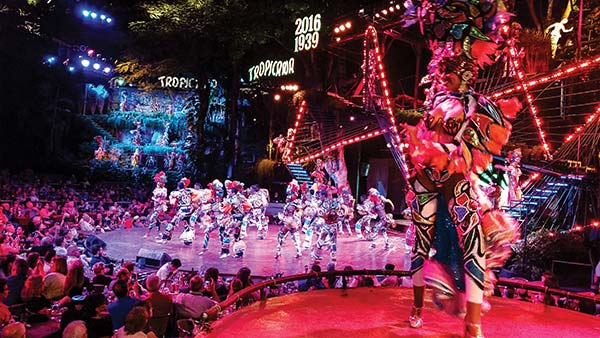
Tropicana
The entrance fee is outrageous, but includes a bottle of rum with cola, a glass of cheap champagne, and a cheap cigar. It’s best to book in advance through your hotel tour desk, as the show often sells out. Beware rip-offs by the waiters, who often wait until the end of the show to bill you for any incidentals, then disappear without bringing your change.
One of the city’s most popular venues is Casa de la Música (Galiano #253, e/ Concordia y Neptuno, tel. 07/860-8296, Tues.-Sun. 10pm-4am, CUC10-20). A modern theater known as “Dos” (for Casa de la Música 2, or dos), it fills with a mostly Cuban crowd for some of the hottest salsa bands and dancing in town. It has a live salsa matinee Saturdays at 5pm.
Salón Turquino (Calle L, e/ 23 y 25, tel. 07/834-6100, Fri.-Sat. 10:30pm-3am, CUC10 cover), atop the Hotel Habana Libre, offers a medley of entertainment that varies nightly, followed by salsa dancing. This expensive and chic hot spot has amazing views. The retractable roof opens at midnight for dancing beneath the stars. Top bands often perform.
The Salón Rojo (Calle 21, e/ N y O, tel. 07/833-3747, nightly 10pm-4am, CUC10-25), beside the Hotel Capri, hosts Havana’s hottest acts, such as Los Van Van and Bandolero. It’s perhaps the venue for searing salsa.
Check with locals as to when Casa Fiesta Jardines del 1830 (Malecón y Calle 20, tel. 07/838-3092, Tues.-Sun. 10pm-2am, CUC3 cover) is happening, as this venue comes and goes in popularity. It’s located in the gardens of a mansion overlooking the mouth of the Río Almendares and is known for its Friday night “House Party” with rueda (wheel), where circles of couples dance in concert then on cue switch partners.
Despite its lackluster setting, Cubans flock to the Café Cantante (Paseo, esq. 39, tel. 07/878-4273, Tues.-Sat. 8pm-3am, CUC10) in the basement of the Teatro Nacional. No hats, T-shirts, or shorts are permitted for men. The plusher Piano Bar Delirio Habanero (tel. 07/878-4275), on the third floor, has Saturday afternoon peñas (4pm) and live music (Thurs.-Fri. 10pm, CUC5). The mood is similar at the Café Teatro Bertolt Brecht (Calle 13, esq. I, tel. 07/832-9359), a sleek low-ceilinged, nonsmoking venue that draws a young crowd.
Getting better all the time, Submarino Amarillo (Yellow Submarine, Calle 17 esq. Calle 6, tel. 07/830-6808, Mon. 9am-2am, Tues.-Sat. 1pm-7:30pm and 9pm-2am, CUC2 cover), on the corner of Parque Lennon, thrills Beatles fans. The decor plays up the Beatles theme, while live bands perform Fab Four tunes amid Cuban rock. It has weekend matinees at 2pm.
Sarao's Bar (Calle 17, esq. E, tel. 07/832-0433 or 5263-8037, daily noon-3am) epitomizes the emerging hip new Cuba, drawing the likes of Usher and Katy Perry to high-octane parties with a South Beach state of mind. This slickly designed venue is the brainchild of several techno DJs and hip-hop artists. With its modern motif and gorgeous staff, this neon-lit nightclub is the hot spot for the monied young.
KingBar (Calle 23 #667, e/ D y E, tel. 07/833-0556, daily 5pm-3am) is a homier version of Sarao’s, with a pumped-up party scene and occasional live music (from hip hop to electronica). Smooth retro soul and R&B tunes are staples in the garden space decorated with erotic art. The club is hidden away to the rear of a large white mansion and doubles as an open-air restaurant with a charcoal grill.
Long considered a top salsa venue by monied locals, Casa de la Música (Av. 25, esq. 20, tel. 07/204-0447, Wed.-Sun. 5pm-9pm and 10pm-3am, CUC10-20) has sizzling-hot afternoon salsa sessions as well as nightly (Tues.-Sun.) salsa and reggaeton performances by such legends as Alexander Abreu, Bamboleo, and NG La Banda. The headliner normally doesn’t come on until 1am. Above the Casa is Disco Tun Tún Piano Bar (Tues.-Sun. 11pm-6am, CUC10), which keeps in the groove until dawn.
While I don’t get its appeal, Don Cangrejo (1ra Av., e/ 16 y 18, tel. 07/204-4169, daily noon-midnight, entrance CUC5-20) is the unlikely Friday and Saturday night hot spot for the Havana elite. The restaurant’s open-air oceanfront pool complex hosts live music by some of Cuba’s top performers (such as Buena Fe and Kelvis Ochoa).
The privately owned, neon-lit Sangri-La (Calle 42, esq. 21, Playa, tel. 5264-8343, daily noon-3am) is a chic lounge club with kick-ass cocktails, white leather banquettes, and flat-screen TVs showing music videos. A small dance floor is tucked in one corner, but after midnight everyone dances wherever. Get there early on weekends to get in.
Cubans find their fun at Teatro Karl Marx (1ra Av., e/ 8 y 10, tel. 07/203-0801, Fri.-Sun. 9pm-2am, CUC10-20), Cuba’s largest theater. Buena Fe, Isaac Delgado, and other big names play here. The vast theater also plays host to many of the city’s gala events.
Farther out, Salón Rosado Benny Moré (Av. 41, esq. 48, tel. 07/203-5322, Fri.-Mon. 7pm-2am for live groups, Tues.-Wed. for cabaret, CUC5-10) is a basic open-air concert arena better known as El Tropical. It’s immensely popular on weekends when top-billed Cuban salsa bands perform. Drawing a relatively impecunious crowd, it features killer music and salacious dancing. Rum-induced fights do break out; it’s best to go with a Cuban friend.
The Asociación Cultural Yoruba de Cuba (Prado #615, e/ Dragones y Monte, tel. 07/863-5953) hosts the Peña de Obini Bata with traditional Afro-Cuban music and dance (Fri. 6pm-8pm), plus cultural activities (Sat. 6pm-8pm, Sun. 9am-1pm, CUC5).
Watch for Gigantería Teatro Callejero, a group of performing street artists who dress as outlandish living statues. The principal group strolls the streets and plazas on stilts; their coming is announced by wailing of cornets and beating of drums, like an ancient cabildo.
The Afro-Cuban All Stars pack in the tourist crowds at Sociedad Cultural Rosalia de Castro (Egido #504 e/ Monte y Dragones, tel. 5270-5271, daily 9:30am-11:30pm) for “Gran Concierto Buena Vista Social Club” nightly shows by old Cuban legends from the Buena Vista Social Club era (CUC30 including dinner). And Buena Vista Social Club-era crooners entertain the tour groups at Café Taberna (Mercaderes #531, esq. Brasil, tel. 07/861-1637, daily 9:30am-11pm, CUC25), on the northeast side of Plaza Vieja.
The place to be on Sunday is Rumba del "Salvador's Alley" (Callejón de Hamel, e/ Aramburo y Hospital, tel. 07/878-1661, eliasasef@yahoo.es), with Afro-Cuban music and dance (Sun. noon-3pm) and traditional music (9pm last Friday of each month).
Decades old and still going strong, the cramped and moody 1950s-style Café Concierto Gato Tuerto (Calle O #14, e/ 17 y 19, tel. 07/838-2696, 10pm-4am, CUC5 cover) nightclub hosts música filin, trova, and bolero nightly. It gets packed with patrons jammed cheek-to-jowl against the postage stamp-size stage tucked into a corner. I’ve been hanging out here for two decades and it hasn’t lost its edge.
The Salón 1930 (in the Hotel Nacional, Calle O y 21, tel. 07/836-3663) hosts traditional Buena Vista Social Club-style shows (Tues. and Sun. 9:30pm, CUC25 cover). El Hurón Azul (UNEAC, Calle 17 #351, esq. H, tel. 07/832-4551, www.uneac.org.cu, daily 5pm-2am) hosts themed peñas (social gatherings) on Wednesday at 5pm (CUC5); the music varies weekly. This is ground zero for intellectual life in Havana.
The acclaimed Conjunto Folklórico Nacional (National Folklore Dance Group, Calle 4 #103, e/ Calzada y 5ta, tel. 07/833-4560, www.folkcuba.cult.cu, CUC5) performs sábado de rumba (Saturday rumba) alfresco each Saturday at 3pm. This is Afro-Cuban music and dance at its best.
Who’d have thought a spa would host trova? If you dig Cuban ballads, or jazz, visit O2 Spa & Jardín (Calle 26 #5 esq. 26B, Nuevo Vedado, tel. 07/883-1663, www.o2habana.com), where top artistes such as Frank Delgado, Abdón Alcarez, and Luna Manzanares perform. Check out the calendar; reservations are essential.
A key jazz venue, Bar Chico O'Farrill (Cuba #102, esq. Chacón, tel. 07/860-5080), in the Hotel Palacio O’Farrill, hosts Cuba’s top performers Friday-Sunday evenings.
The Jazz Café (1ra at the base of Paseo, tel. 07/838-3302, daily 10pm-2am, CUC10 consumo mínimo), on the third floor of the Galería del Paseo, is a classy supper club with some of the best live jazz in town, including resident maestro Chucho Valdés. Get there early to snag a seat. In 2015, Cuban jazz musician Lazarito Valdés (leader of the popular band Bamboleo) opened the nonsmoking Valdés Jazz Club (Calle E #105, e/ 5ta y Calzada, tel. 07/830-5898, valdesjazz@gmail.com), which features a bar, restaurant, and patio. The all-white decor is a bit cold, but the vibe is hot. Local maestros Bobby Carcassés and Maraca are regulars.
An incongruous red London phone booth serves as the entrance to La Zorra y el Cuervo (Calle 23, e/ N y O, tel. 07/833-2402, 10pm-2am, CUC10 including two drinks), a dreary, cramped basement setting (supposedly nonsmoking, but don’t count on it) where Cuban greats such as Roberto Fonseca, Alexis Bosch, and saxophonist Michel Herrera perform. It has blues music on Thursdays, plus a Saturday matinee at 2pm.
Richard Egües—grandson of the eponymous Charanga maestro and lead flautist of Orquesta Aragón—keeps his granddad’s legacy alive at La Flauta Mágica (Calzada #101 e/ L y M, tel. 07/832-3195, noon-4am). The small and intimate restaurant/bar occupies the penthouse suite of a 1950s high-rise overlooking the U.S. Embassy and Malecón. The live jazz can be sensational, and you can lounge on sofas by the rooftop pool.
A jazz ensemble performs at the Tocororo (Calle 18 y 3ra Av., tel. 07/202-2209, Mon.-Sat. noon-midnight) restaurant, where the lively bar is favored by local expats. The über-chic private club Privé (Calle 88A #306, e/ 3ra y 3raA, Miramar, tel. 07/209-2719, Tues.-Sun. 5pm-6am) hosts jazz and nueva trova greats such as Frank Delgado and has an open bar (CUC10).
The state entity Artex did a great job refurbishing Café Miramar (Calle 5ta, esq. 94, tel. 07/204-6244, Tues.-Sun. noon-2am, CUC2-4) as a snazzy jazz venue where you can catch Pacheco, Aldito López Gavilán, and other hot artists. Music kicks in at 10:30pm, plus it has Sunday afternoon jams. The audience can be quite loud.
The Irene Rodríguez Compañía performs amazing flamenco at Centro Andaluz en Cuba (Prado #104, e/ Genios y Refugio, tel. 07/5246-8426, www.irenerodriguezcompania.com, free) each Wednesday, Friday, and Saturday at 9pm. Lessons are offered (Tues.-Thurs. 9am-11am, CUC15 per hour).
El Mesón de la Flota (Mercaderes #257, e/ Amargura y Brasil, tel. 07/863-3838, free) hosts high-energy flamenco shows daily 1pm-3pm and 8pm-11pm; you can even watch through the bars from the street. Patio Sevillano at the Hotel Sevilla (Trocadero, esq. Prado, tel. 07/860-9046) has flamenco on Saturday at 9pm. And the renowned Ballet Lizt Alfonso (Compostela e/ Luz y Acosta, tel. 07/866-3688, www.liztalfonso.com) offers flamenco classes and courses.
Caserón del Tango (Neptuno #309, e/ Águila y Italia, tel. 07/863-0097) hosts tango peñas on Monday 5pm-7pm, drawing local aficionados in Argentinian-style garb. Unión Arabe de Cuba (Prado e/ Animas y Trocadero, tel. 07/861-0582, www.unionarabecuba.org) hosts occasional tango.
Watch for performances by the incomparable Habana Compas Dance (Av. 51 #12202 e/ 122 y 124, Marianao, tel. 07/262-8949, habanacompas@cubarte.cult.cu), a troupe that combines Spanish flamenco with Afro-Cuban drumming.
The most important theater in Havana is the renovated Gran Teatro de la Habana Alicia Alonso (Paseo de Martí #458, e/ San Rafael y San Martín, Habana Vieja, tel. 07/861-3079, CUC25 for best orchestra seats), on the west side of Parque Central. It’s the main stage for the acclaimed Ballet Nacional de Cuba and the national opera company. Performances are Thursday-Saturday at 8:30pm and Sunday at 5pm. A dress code applies.
The Basílica de San Francisco de Asís (Calle Oficios, e/ Amargura y Brasil, tel. 07/862-9683) hosts classical concerts at 6pm (CUC2-10) most Saturdays and some Thursdays.
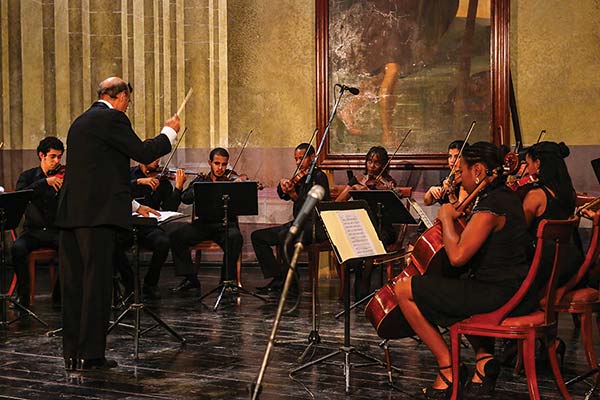
classical concert in Basílica de San Francisco de Asís, Habana Vieja
Classical and ecclesiastical concerts are also featured in the Iglesia de San Francisco de Paula (Av. del Puerto, esq. Leonor Pérez, tel. 07/860-4210, free or CUC5) on Friday at 7pm, and in the Oratorio San Felipe Neri (Calle Aguiar, esq. Obrapía, tel. 07/862-3243) on Thursday at 7pm and Saturday at 4pm.
Check out the program at the Museo Nacional de Bellas Artes (tel. 07/863-9484, www.bellasartes.cult.cu), which hosts classical artists on Thursday and Saturday at 7pm (Cuban section, Trocadero e/ Zulueta y Monserrate) and on Saturday at 4pm (international section, San Rafael e/ Zulueta y Monserrate).
For more avant-garde fare, peruse the schedule at Danza-Teatro Retazos, a contemporary troupe that performs at the Teatro Retazos (Calle Amargura #61 e/ San Ignacio y Mercaderes, tel. 07/860-4341).
The Palacio de Matrimonio (Prado #306, esq. Ánimas, tel. 07/866-0661, Tues.-Fri. 8am-6pm) hosts live chamber and classical music.
Performances of the Orquesta Sinfónica Nacional de Cuba (National Symphony) and Danza Contemporánea de Cuba are hosted at the Teatro Nacional (Av. Carlos M. de Céspedes, esq. Paseo, Vedado, tel. 07/878-5590, www.teatronacional.cu) every Friday-Saturday at 8:30pm and Sunday at 5pm (CUC1.80-8.90).
The Teatro Mella (Línea #657, e/ A y B, Vedado, tel. 07/833-8696, box office Tues.-Sun. 2pm-6pm) is noted for contemporary dance, theater, and ballet (CUC5-10), and hosts the Conjunto Folklórico Nacional.
The last Thursday of each month, UNEAC (Calle 17 #351, e/ G y H, Vedado, tel. 07/832-4551, www.uneac.org.cu) hosts an open peña for chamber musicians at 6pm.
The Teatro Amadeo Roldán (Calzada y D, Vedado, tel. 07/832-1168, CUC5-10) hosts the Simfonia Nacional de Cuba and has two salas; it features classical concerts year-round. Nearby is the Teatro Hubert de Blanck (Calzada #657, e/ A y B, tel. 07/830-1011, CUC5), known for both modern and classical plays. Shows (in Spanish) are usually Friday-Saturday at 8:30pm and Sunday at 5pm.
The 150-seat Teatro Buendía (Calle Loma y 38, Nuevo Vedado, tel. 07/881-6689, five pesos), in a converted Greek Orthodox church, hosts performances by the eponymous theater company, considered to be Cuba’s most innovative and accomplished. It performs here Friday-Sunday at 8:30pm.
Named for a famed, late Cuban clown, Havana’s Circo Trompoloco (Calle 112, esq. 5ta Av., Miramar, tel. 07/206-5609 or 07/206-5641, www.circonacionaldecuba.cu, Thurs.-Fri. 4pm, Sat.-Sun. 4pm and 7pm, CUC10) is the headquarters of the Circo Nacional de Cuba, which performs beneath a red-and-white-striped “big top.”
For a list of forthcoming festivals, conferences, and events, visit www.lahabana.com.
The Cabildos festival is held on January 6, when Habana Vieja resounds with festivities recalling the days when Afro-Cuban comparsas danced through the streets. Contact Agencia de Viajes San Cristóbal (Oficios #110, e/ Lamparilla y Amargura, tel. 07/861-9171).
The Habanos Festival (tel. 07/204-0510, www.habanos.com) celebrates Cuban cigars. It opens at the Tropicana with an elegant dinner and auction for big spenders.
The Feria Internacional del Libro de la Habana (Havana Book Fair, Calle 15 #602 e/ B y C, Vedado, tel. 07/832-9526, www.filcuba.cult.cu) is held in Fortaleza San Carlos de la Cabaña.
The Festival Internacional de Tambor (International Drum Festival, tel. 07/836-5381, www.fiestadeltambor.cult.cu) is held at various venues.
The prestigious Bienal de la Habana (Havana Biennial, tel. 07/209-6569, www.bienalhabana.cult.cu) features artists from more than 50 countries. It is hosted in even-numbered years by the Centro Wilfredo Lam (Calle San Ignacio #22, tel. 07/861-2096, www.cnap.cult.cu).
On May 1, head to the Plaza de la Revolución for the Primero de Mayo (May Day Parade) to honor workers. Intended to appear as a spontaneous demonstration of revolutionary loyalty, in reality it is carefully choreographed. Stooges use loudspeakers to work up the crowd of 500,000 people with chants of “¡Viva Fidel!” and “¡Viva Raúl!” Raúl has toned down the anti-United States flavor since taking over.
The Festival Internacional de Guitarra (International Guitar Festival and Contest) is held at the Teatro Roldán in even-numbered years.
The Festival Internacional Boleros de Oro (International Boleros Festival, UNEAC, Calle 17 #354, e/ G y H, Vedado, tel. 07/832-4571, www.uneac.org.cu) features traditional Latin American folk music.
The Coloquio Internacional Hemingway (International Hemingway Colloquium, tel. 07/691-0809, mushem@cubarte.cult.cu) takes place in early July every odd-numbered year.
The amateurish Carnaval de la Habana (Carnival in Havana, tel. 07/832-3742) is held the first or second week of August on the Malecón.
The 10-day biennial Festival Habanarte, sponsored by the Consejo Nacional de Las Artes (National Council of Arts, Calle 4 #257, Miramar, tel. 07/832-4126, www.habanarte.com), is held in odd-numbered years.
The Festival Internacional de Ballet (International Ballet Festival) features ballet corps from around the world, plus the acclaimed Ballet Nacional de Cuba (BNC, Calzada #510, e/ D y E, Vedado, Ciudad Habana, tel. 07/832-4625, www.balletcuba.cult.cu).
The annual Festival de la Habana de Música Contemporánea (Havana Festival of Contemporary Music, c/o UNEAC, Calle 17 #351, e/ G y H, Vedado, tel. 07/832-0194, www.musicacontemporanea.cult.cu) spans a week in early October, with performances ranging from choral to electro-acoustic.
Expo Canina (tel. 07/267-3156, cdc@enet.cu) is Havana’s answer to the Crufts and Westminster dog shows.
The Festival del Nuevo Cine Latinoamericano (Festival of New Latin American Cinema, c/o the Instituto de Cinematografía, Calle 23 #1155, Vedado, tel. 07/838-2354, www.habanafilmfestival.com) is one of Cuba’s most glittering events, attended by Cuban actors and directors and their Hollywood counterparts. Movies are shown at cinemas across the city, and the festival culminates with Cuba’s own version of the Oscars, the Coral prizes. Buy your tickets well before the programming is announced; you can buy a pass (CUC25) good for the duration of the festival.
The star-studded Festival Internacional de Jazz (International Havana Jazz Festival, Calle 15, esq. F, Vedado, tel. 07/862-4938) is highlighted by the greats of Cuban jazz, such as Chucho Valdés and Irakere, and Juan Formell and Los Van Van. Concerts are held at various venues.